Panasonic of North America 96NKX-TG2583 2.4 GHz Spread Spread Cordless Telephone System User Manual H
Panasonic Corporation of North America 2.4 GHz Spread Spread Cordless Telephone System H
H User Manual
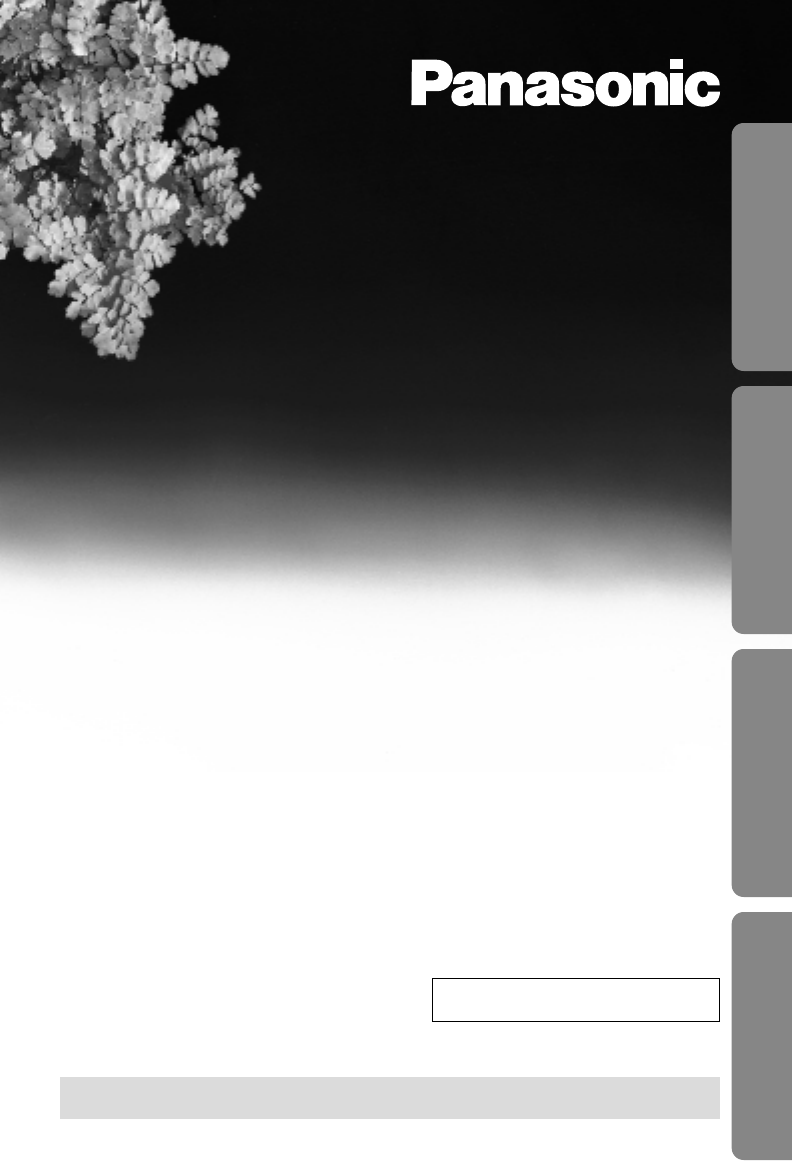
2.4GHz Cordless Answering System
Model No. KX-TG2583B
KX-TG2583S
KX-TG2583PW
Pulse-or-tone dialing capability
Operating Instructions
PLEASE READ BEFORE USE AND SAVE.
Panasonic World Wide Web address: http://www.panasonic.com
for customers in the USA or Puerto Rico
Charge the battery for about 6 hours before initial use.
Preparation Cordless Telephone Answering System Useful Information
Caller ID Compatible
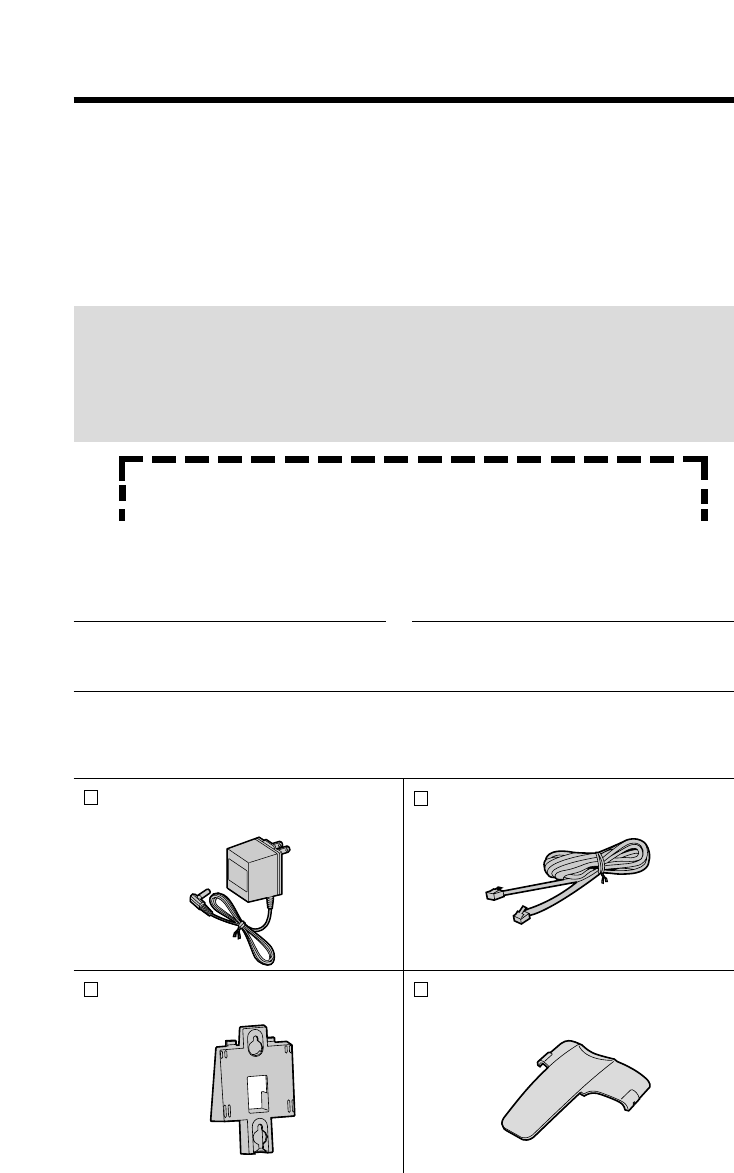
Before Initial Use
2
Please read IMPORTANT SAFETY
INSTRUCTIONS on page 80 before use.
Read and understand all instructions.
Thank you for purchasing your new Panasonic cordless
telephone.
Attach your purchase receipt here.
Caller ID and Call Waiting Service, where available, are telephone
company services. After subscribing to Caller ID, this phone will display a
caller’s name and phone number. Call Waiting Caller ID, which displays a
second caller’s name and phone number while the user is on another
call, requires a subscription to both Caller ID and Call Waiting.
Accessories (included) For extra orders, call 1-800-332-5368.
AC Adaptor (p. 10)
Order No. PQLV10Z
one
Telephone Line Cord
(p. 10)
one
Wall Mounting Adaptor (p. 68)
Order No. PQKL10038Z1
one
Belt Clip (p. 70)
Order No.
one
For your future reference
Serial No. Date of purchase
(found on the bottom of the unit)
Name and address of dealer
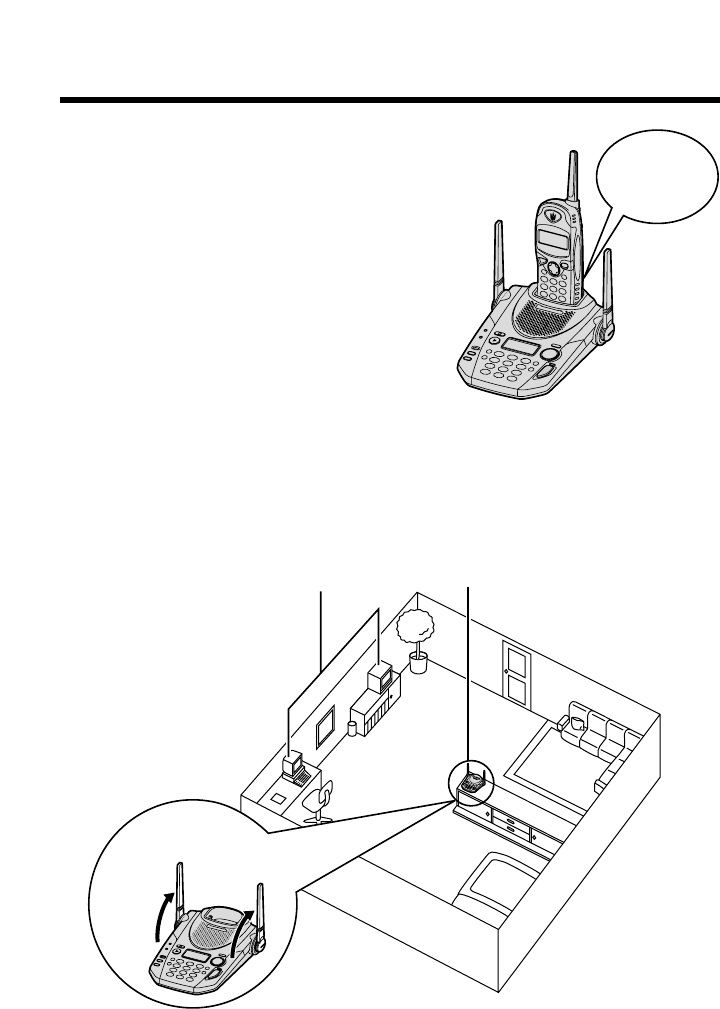
For Best Performance
3
Battery Charge
A rechargeable Ni-Cd battery powers the
handset. Charge the battery for about 6
hours before initial use (p. 11).
Base Unit Location/Noise
Calls are transmitted between the base unit and the handset using
wireless radio waves. For maximum distance and noise-free
operation, the recommended base unit location is:
Note:
While using the handset:
•If you are near a microwave oven which is being used, noise may be heard from
the receiver. Move away from the microwave oven and closer to the base unit.
•If more than one cordless phone is being used and your handset is near another
cordless phone’s base unit, noise may be heard. Move away from the other
cordless phone’s base unit and closer to your base unit.
Away from electrical appliances
such as a TV, personal computer or
another cordless phone.
In a HIGH and CENTRAL location
with no obstructions such as walls.
Raise
the antennas.
The battery
is beneath
this cover.

Preparation
Location of Controls . . . . . . . . . . . . . . . . . . . . . . . . . . . . . . . . . 6
Displays . . . . . . . . . . . . . . . . . . . . . . . . . . . . . . . . . . . . . . . . . . . 9
Settings. . . . . . . . . . . . . . . . . . . . . . . . . . . . . . . . . . . . . . . . . . . . 10
Connections . . . . . . . . . . . . . . . . . . . . . . . . . . . . . . . . . . . . . . . 10
Battery Charge . . . . . . . . . . . . . . . . . . . . . . . . . . . . . . . . . . . . . 11
Selecting the Dialing Mode . . . . . . . . . . . . . . . . . . . . . . . . . . . . 13
Selecting the Line Mode . . . . . . . . . . . . . . . . . . . . . . . . . . . . . . 14
Programmable Functions . . . . . . . . . . . . . . . . . . . . . . . . . . . . . 15
Setting the Auto Talk Feature . . . . . . . . . . . . . . . . . . . . . . . . . . 16
Selecting the Ringer Volume . . . . . . . . . . . . . . . . . . . . . . . . . . . 17
Preparing the Answering System . . . . . . . . . . . . . . . . . . . . . . . 19
Greeting Message. . . . . . . . . . . . . . . . . . . . . . . . . . . . . . . . . . . 19
Programming Summary for the Answering System . . . . . . . . . . 21
Day and Time Adjustment . . . . . . . . . . . . . . . . . . . . . . . . . . . . . 22
Selecting the Caller’s Recording Time. . . . . . . . . . . . . . . . . . . . 24
Selecting the Number of Rings . . . . . . . . . . . . . . . . . . . . . . . . . 25
Cordless Telephone
Making Calls . . . . . . . . . . . . . . . . . . . . . . . . . . . . . . . . . . . . . . . . 26
With the Handset . . . . . . . . . . . . . . . . . . . . . . . . . . . . . . . . . . . 26
With the Base Unit (Digital Duplex Speakerphone) . . . . . . . . . . 28
Simultaneous Keypad Dialing . . . . . . . . . . . . . . . . . . . . . . . . . . 30
Answering Calls . . . . . . . . . . . . . . . . . . . . . . . . . . . . . . . . . . . . . 31
With the Handset . . . . . . . . . . . . . . . . . . . . . . . . . . . . . . . . . . . 31
With the Base Unit (Digital Duplex Speakerphone) . . . . . . . . . . 31
Caller ID Service. . . . . . . . . . . . . . . . . . . . . . . . . . . . . . . . . . . . . 32
Using the Caller List. . . . . . . . . . . . . . . . . . . . . . . . . . . . . . . . . . 34
Viewing the Caller List. . . . . . . . . . . . . . . . . . . . . . . . . . . . . . . . 34
Calling Back from the Caller List . . . . . . . . . . . . . . . . . . . . . . . . 35
Editing the Caller’s Phone Number . . . . . . . . . . . . . . . . . . . . . . 36
Storing Caller List Information in the Directory. . . . . . . . . . . . . . 38
Erasing Caller List Information . . . . . . . . . . . . . . . . . . . . . . . . . 39
One-Touch Dialer . . . . . . . . . . . . . . . . . . . . . . . . . . . . . . . . . . . . 41
Storing a Phone Number in the DIRECT Button . . . . . . . . . . . . 41
Dialing the Stored Number in the DIRECT Button . . . . . . . . . . . 42
Using the Directory . . . . . . . . . . . . . . . . . . . . . . . . . . . . . . . . . . 43
Storing Names and Numbers in the Directory . . . . . . . . . . . . . . 43
Selecting Characters to Enter Names . . . . . . . . . . . . . . . . . . . . 45
Finding Items in the Directory . . . . . . . . . . . . . . . . . . . . . . . . . . 47
Dialing from the Directory . . . . . . . . . . . . . . . . . . . . . . . . . . . . . 49
Contents
4

5
Preparation Cordless Telephone Answering System Useful Information
Editing an Item in the Directory . . . . . . . . . . . . . . . . . . . . . . . . 50
Erasing an Item from the Directory . . . . . . . . . . . . . . . . . . . . . . 51
Intercom . . . . . . . . . . . . . . . . . . . . . . . . . . . . . . . . . . . . . . . . . . . 52
Transferring a Call Using the Intercom . . . . . . . . . . . . . . . . . . . 53
Special Features. . . . . . . . . . . . . . . . . . . . . . . . . . . . . . . . . . . . . 54
Automatic Security Code Setting . . . . . . . . . . . . . . . . . . . . . . . . 54
For Call Waiting Service Users . . . . . . . . . . . . . . . . . . . . . . . . . 54
How to Use the PAUSE Button
(For Analog PBX Line/Long Distance Service Users). . . . . . . 54
Temporary Tone Dialing
(For Rotary or Pulse Service Users) . . . . . . . . . . . . . . . . . . . 55
FLASH Button . . . . . . . . . . . . . . . . . . . . . . . . . . . . . . . . . . . . . . 55
Answering System
Automatic Answering Operation . . . . . . . . . . . . . . . . . . . . . . . . 56
Setting the Unit to Answer Calls . . . . . . . . . . . . . . . . . . . . . . . . 56
Listening to Messages . . . . . . . . . . . . . . . . . . . . . . . . . . . . . . . . 57
From the Handset . . . . . . . . . . . . . . . . . . . . . . . . . . . . . . . . . . . 58
Erasing Messages . . . . . . . . . . . . . . . . . . . . . . . . . . . . . . . . . . . 59
Remote Operation from a Touch Tone Phone . . . . . . . . . . . . . 60
Setting the Remote Code . . . . . . . . . . . . . . . . . . . . . . . . . . . . . 61
Voice Menu. . . . . . . . . . . . . . . . . . . . . . . . . . . . . . . . . . . . . . . . 62
Direct Remote Operation. . . . . . . . . . . . . . . . . . . . . . . . . . . . . . 64
Remote Operation with the Handset . . . . . . . . . . . . . . . . . . . . . 66
Useful Information
Wall Mounting. . . . . . . . . . . . . . . . . . . . . . . . . . . . . . . . . . . . . . . 68
Using the Belt Clip . . . . . . . . . . . . . . . . . . . . . . . . . . . . . . . . . . . 70
Using an Optional Headset . . . . . . . . . . . . . . . . . . . . . . . . . . . . 70
Battery Replacement . . . . . . . . . . . . . . . . . . . . . . . . . . . . . . . . . 71
If the Following Appear... . . . . . . . . . . . . . . . . . . . . . . . . . . . . . 72
Before Requesting Help. . . . . . . . . . . . . . . . . . . . . . . . . . . . . . . 74
Adding Another Phone . . . . . . . . . . . . . . . . . . . . . . . . . . . . . . . 79
Important Safety Instructions . . . . . . . . . . . . . . . . . . . . . . . . . . 80
FCC and Other Information . . . . . . . . . . . . . . . . . . . . . . . . . . . . 82
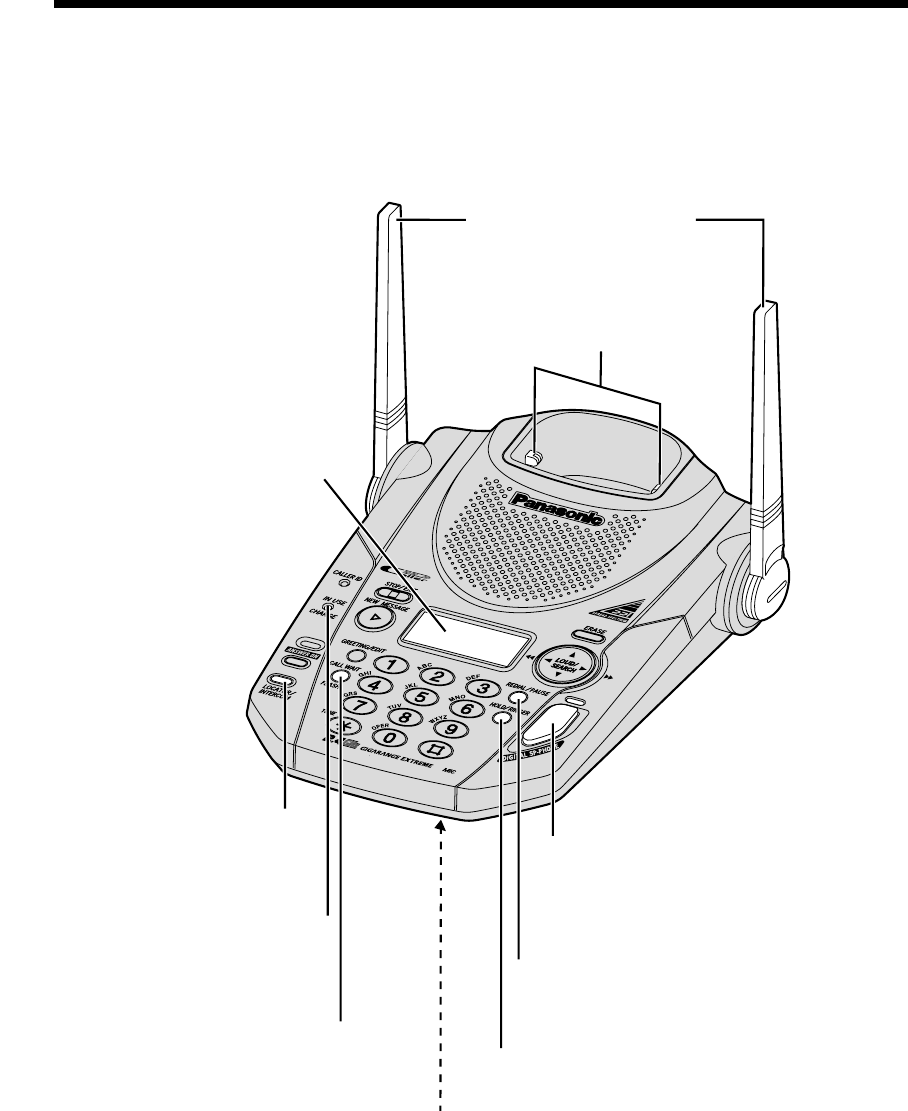
Location of Controls
6
Base unit
IN USE/CHARGE
Indicator (p. 11)
Charge Contacts (p. 12)
(CALL!WAIT/FLASH)
Button (p. 54, 55)
(REDIAL/PAUSE)
Button (p. 29, 54)
Display (p. 9, 73)
(HOLD/RINGER) Button (p. 18, 29)
(LOCATOR/INTERCOM)
Button (p. 52)
MIC (Microphone) (p. 19, 28, 31, 52)
Antennas (p. 3, 10)
(DIGITAL!SP-PHONE)
(Speakerphone) Button
and Indicator (p. 28, 31)
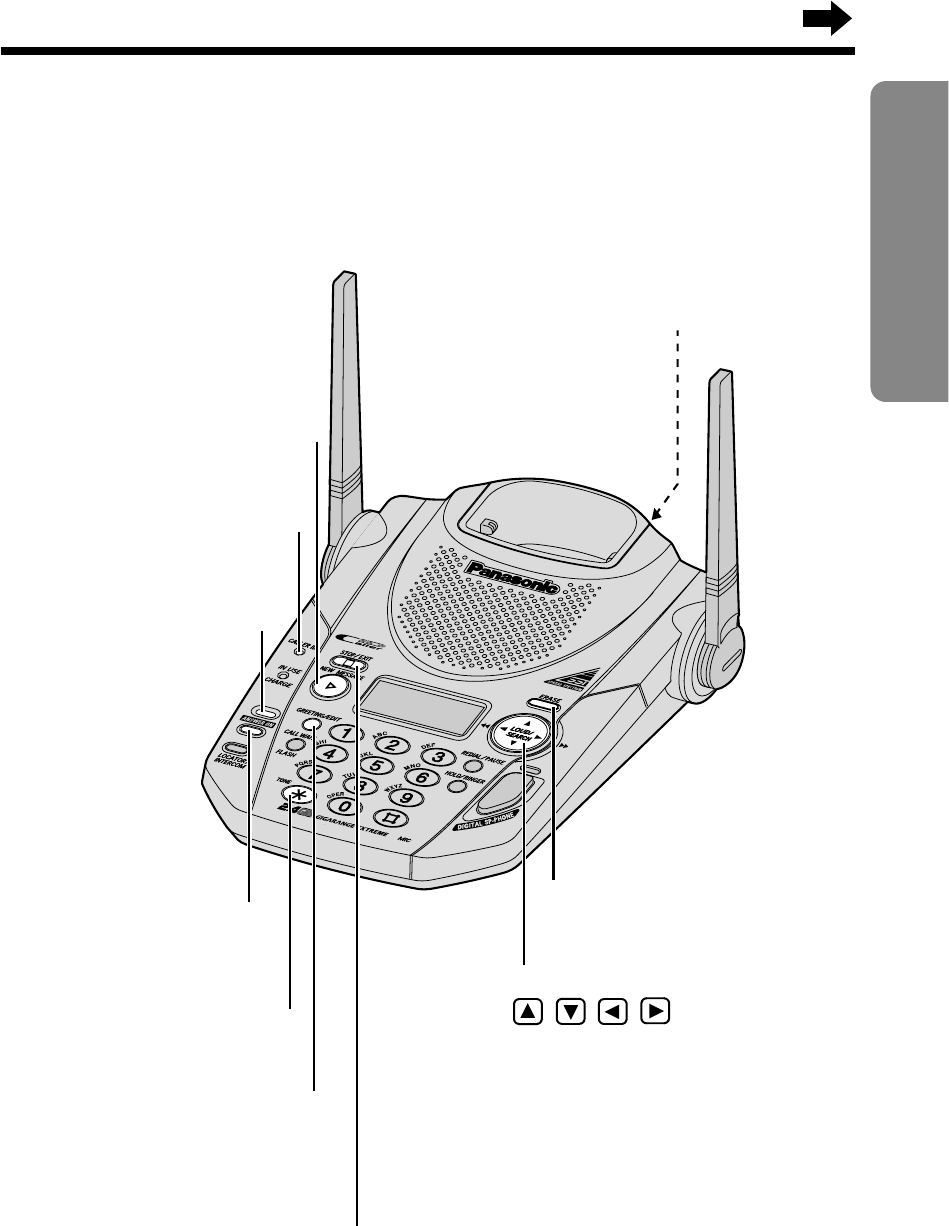
7
Preparation
(ERASE) Button
(p. 20, 39, 51, 59)
(GREETING/EDIT)
Button (p. 19, 37)
(ANSWER!ON) Button
(p. 56)
Navigator Key
( , , , )
(
p. 20, 29, 34, 48, 57
)
(TONE) Button (p. 55)
(NEW!MESSAGE) Button
(p. 57)
(STOP/EXIT) Button
(p. 19, 34, 48, 56, 57)
CALLER ID Indicator
(p. 31, 33)
Cradle Lock
Switch (p. 68)
ANSWER ON Indicator
(p. 56, 57, 59)
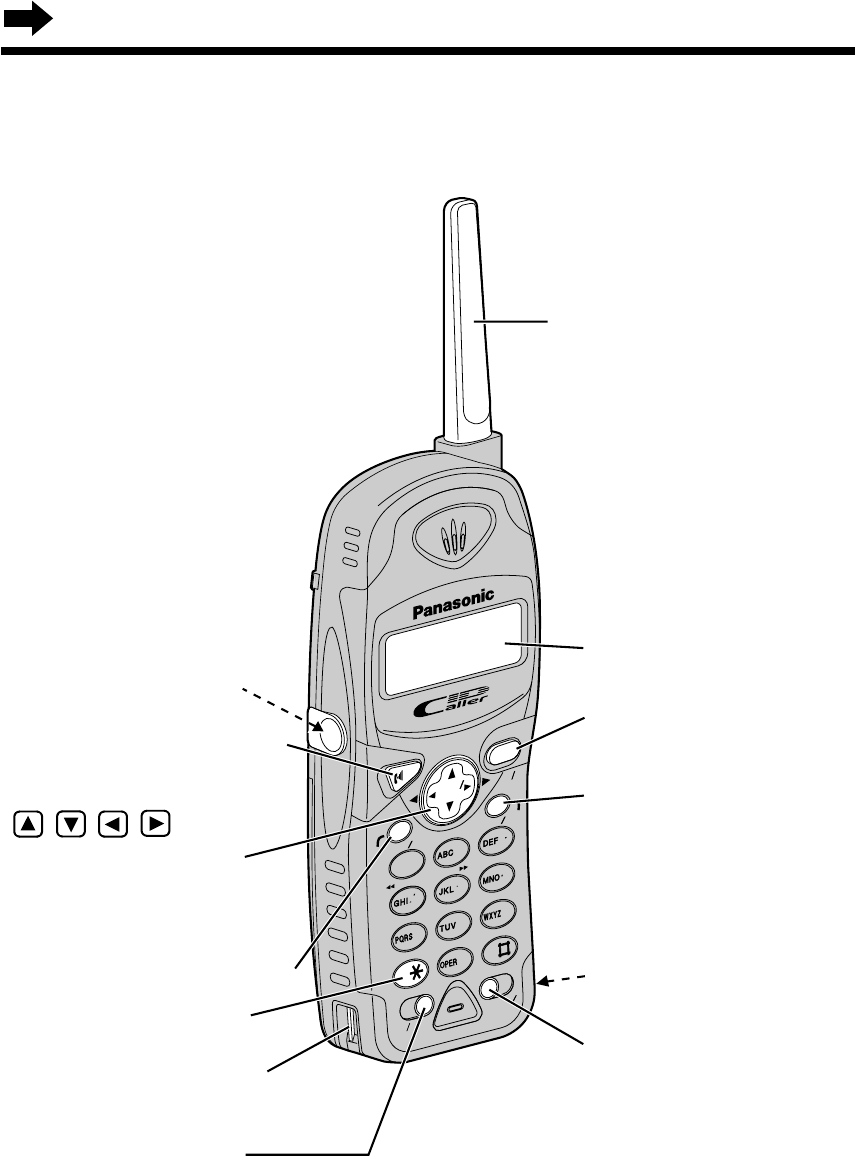
Location of Controls
8
Handset
TALK
4
FL
FLASH
SH
REDIAL
REDIAL
CALL WA
L WAIT
PAUSE
PAUSE
PLPLAYBABACK
TONE
TONE
STOP
ANS
S ON
78
9
0
ANS
OFF
OFF
CHCH
FUNCTION EXITFUNCTION EXIT
INT
INTERCOM
ERCOM CLEAR
CLEAR
PAGER
SKIP
KIP
REPE
PEAT
1
2
3
ALL
L MSG
NEW
W MSG
5
6
BACKBACK
FWD EDIT
EDIT
DIRECT
LOUD LOUD
SESEARCRCH
ON
OFF
(INTERCOM/CLEAR)
Button
(p. 39, 45, 51, 52)
(FLASH/CALL!WAIT/PLAYBACK)
Button (p. 54, 55, 66)
Headset Jack (p. 70)
(TALK) Button (p. 26, 31)
(TONE) Button (p. 55)
Charge Contact (p. 12)
Navigator Key
( , , , )
(
p. 15, 21, 27, 34, 44
)
Display (p. 9, 72)
(FUNCTION/EXIT/CH)
(Channel) Button
(p. 15, 21, 26, 34, 44, 47) Charge Contact (p. 12)
(REDIAL/PAUSE) Button
(p. 27, 54)
(DIRECT) Button
(p. 41, 42)
Antenna
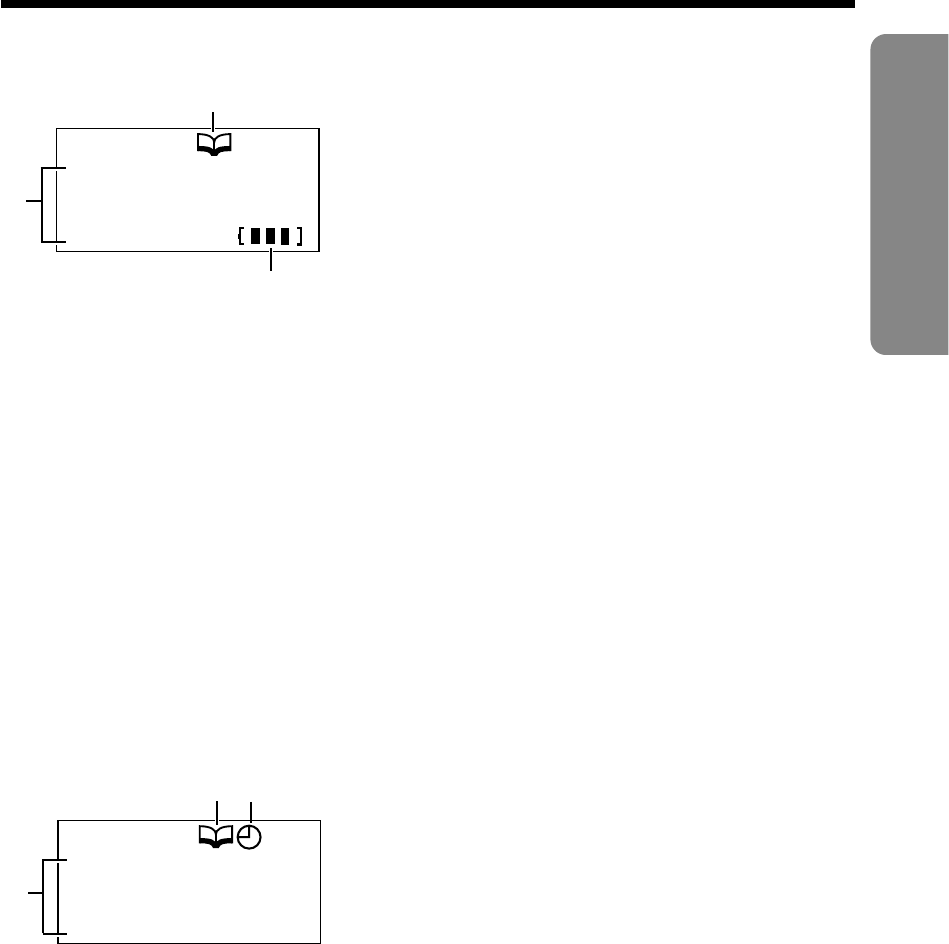
Displays
9
Preparation
Base unit
#The day and time and the number of
incoming messages are displayed while
the unit is not in use (Standby mode).
The display shows the dialed number,
call status, programming options and
directory items etc.
Handset
#The display shows the dialed number,
call status, programming options and
directory items etc. If you subscribe to a
Caller ID service, caller information will
be displayed (p. 32). The number of new
calls will also be displayed.
If you subscribe to a Caller ID service, caller information will be
displayed (p. 34). The number of new calls will also be displayed.
$The directory icon displays when viewing the directory items (p. 48).
%The clock icon flashes with the day and time if the clock needs
adjusting (p. 23).
$The directory icon displays when storing or viewing the directory items
(p. 42, 46).
%The battery icon indicates the battery strength (p. 11).
Standby mode:
While the handset is off the base unit, the display becomes blank after
you finish using the handset (making/answering a call, viewing the Caller
List or directory list etc.). The handset can receive calls. The battery life is
conserved in this state. While the handset is on the base unit, the battery
icon and the number of new Caller ID calls are displayed in the standby
mode (p. 33).
0 new call
#
$
%
SUN 12:00AM
0 Message
#
$%
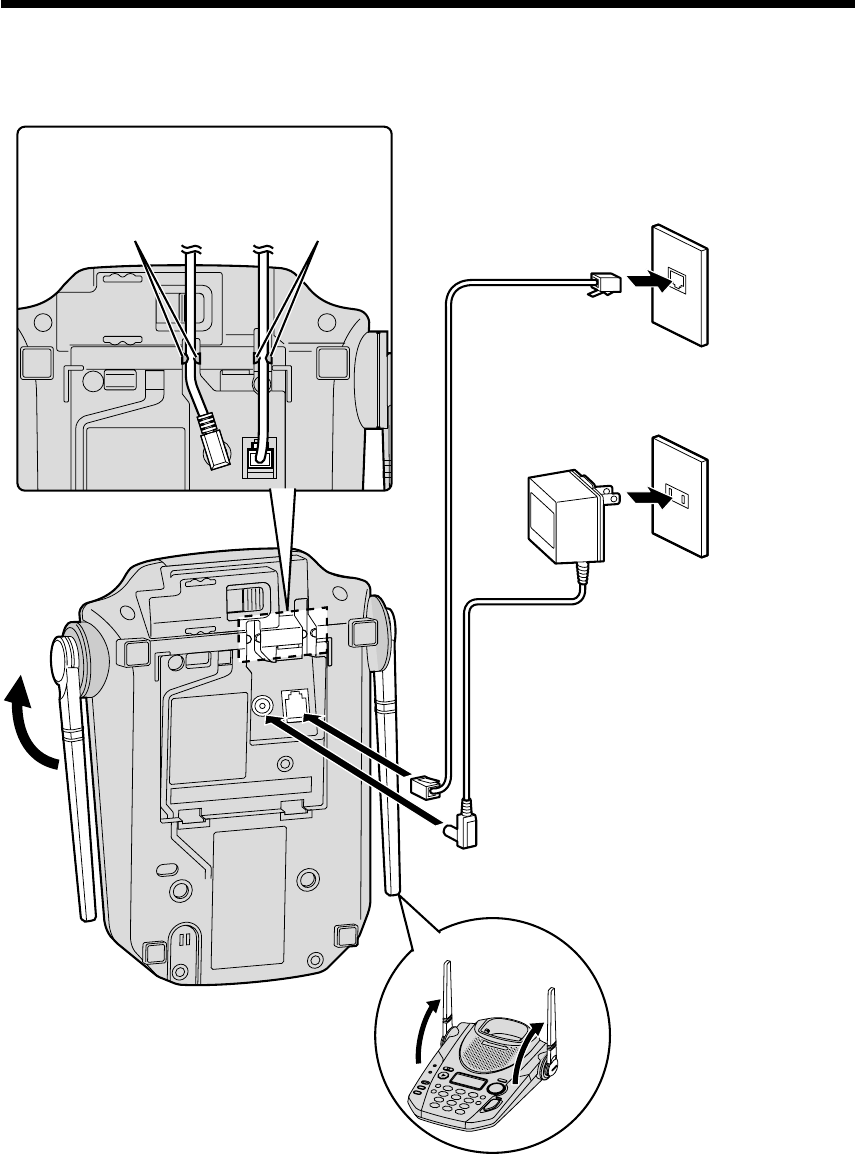
Settings
10
Connections
•
USE ONLY WITH Panasonic AC ADAPTOR PQLV10 (Order No. PQLV10Z).
•The AC adaptor must remain connected at all times. (It is normal for the adaptor
to feel warm during use.)
•To connect a standard telephone on the same line, see page 79.
•If your unit is connected to a PBX which does not support Caller ID services, you
cannot access those services.
HooksHooks
AC Adaptor
Telephone Line
Cord
Power Outlet
(AC 120 V, 60 Hz)
Raise the
antennas.
Fasten the cords to prevent
them from being disconnected.
Single-Line
Telephone Jack
(RJ11C)
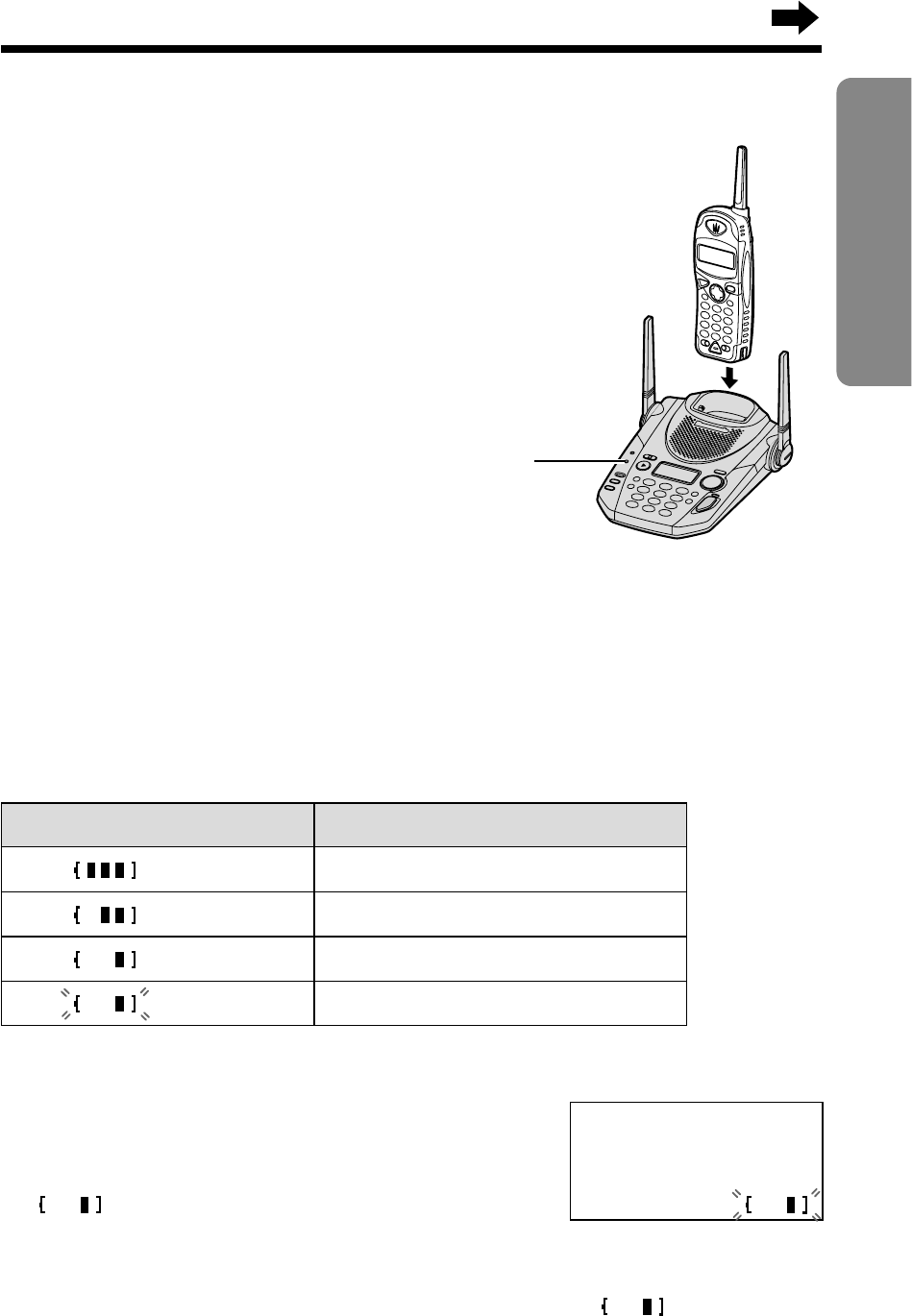
11
Preparation
Needs to be recharged.
Battery Charge
Place the handset on the base unit
and charge for about 6 hours before
initial use.
•The IN USE/CHARGE indicator lights and
a beep sounds.
Battery strength
You can check the battery strength on the handset display while the
handset is on the base unit, while it is in use (making/answering a call
etc.), or after viewing the Caller List or directory items, programming etc.
The battery strength will remain for 5 seconds after using the handset,
then the display will return to the standby mode (p. 9).
The battery strength is as shown in the chart below.
Display prompt Battery strength
Fully charged
Medium
Low
(flashing)
IN USE/CHARGE
Indicator
Recharge
Recharge the battery when:
—“Recharge battery” is displayed on
the handset,
—“ ” flashes on the display, or
—the handset beeps intermittently while it is in use.
•If you DO NOT recharge the handset battery for more than 15 minutes, the
display will keep indicating “Recharge battery” and/or “ ” will continue
to flash.
Recharge battery
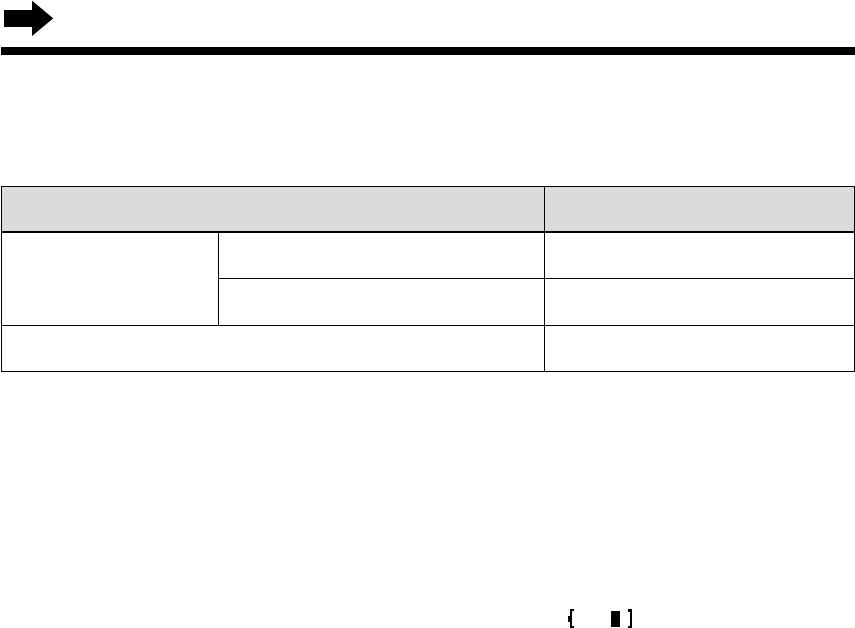
Settings
12
Up to 3.5 hours
Up to 11 days
Battery information
After your Panasonic battery is fully charged (p. 11):
Operation Approx. battery life
While in use
(TALK)
Up to 4.5 hours
While not in use (Standby)
near the base unit*
away from the base unit
*Within about 10 feet (3 m)
•Battery life may be shortened depending on usage conditions, such as viewing
the Caller ID Caller List or directory list, and ambient temperature.
•Clean the handset and the base unit charge contacts with a soft, dry cloth
once a month. Clean more often if the unit is subject to grease, dust or
high humidity. Otherwise the battery may not charge properly.
•If the battery is fully charged, you do not have to place the handset on the base
unit until “Recharge battery” is displayed and/or “ ” flashes. This will
maximize the battery life.
•The battery cannot be overcharged.
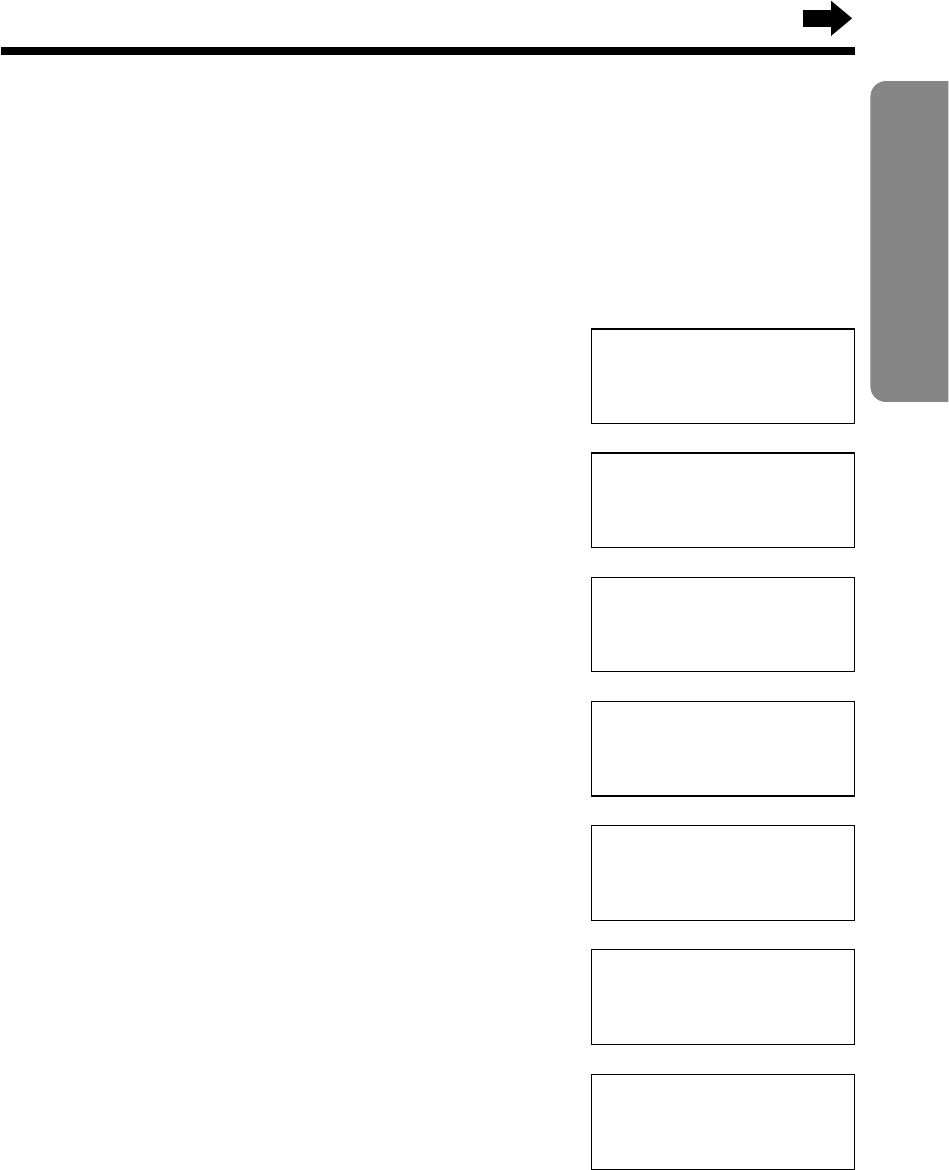
13
Preparation
Selecting the Dialing Mode
You can program the dialing mode using the handset near the base
unit.
If you have touch tone service, set to “Tone”. If rotary or pulse service is
used, set to “Pulse”. Your phone comes from the factory set to “Tone”.
Make sure the unit is in the standby mode initially.
1Press (FUNCTION/EXIT/CH).
2Press Öor Ñrepeatedly until the arrow
points to “Program”.
3Press FWD/EDIT á(Yes key).
4Press Öor Ñrepeatedly until the arrow
points to “Set dial mode”.
5Press FWD/EDIT á(Yes key).
6Press Öor Ñto select “Pulse” or
“Tone”.
7Press FWD/EDIT á(Save key).
•A beep sounds.
•To return to the standby mode, press
(FUNCTION/EXIT/CH).
•You can exit the programming mode any time by pressing (FUNCTION/EXIT/CH).
•If the handset has lost communication with the base unit, 3 beeps sound and “No
link to base. Place on cradle and try again.” is displayed.
H
Save directory
Ringer volume
GF H
=Yes
H
Program
Calling pager
GF H
=Yes
H
Save DIRECT#
Set flash time
GF H
=Yes
Set line mode
H
Set dial mode
GF H
=Yes
Dial mode
:Tone
GF H
=Save
Dial mode
:Pulse
Dial mode
:Pulse
GF H
=Save
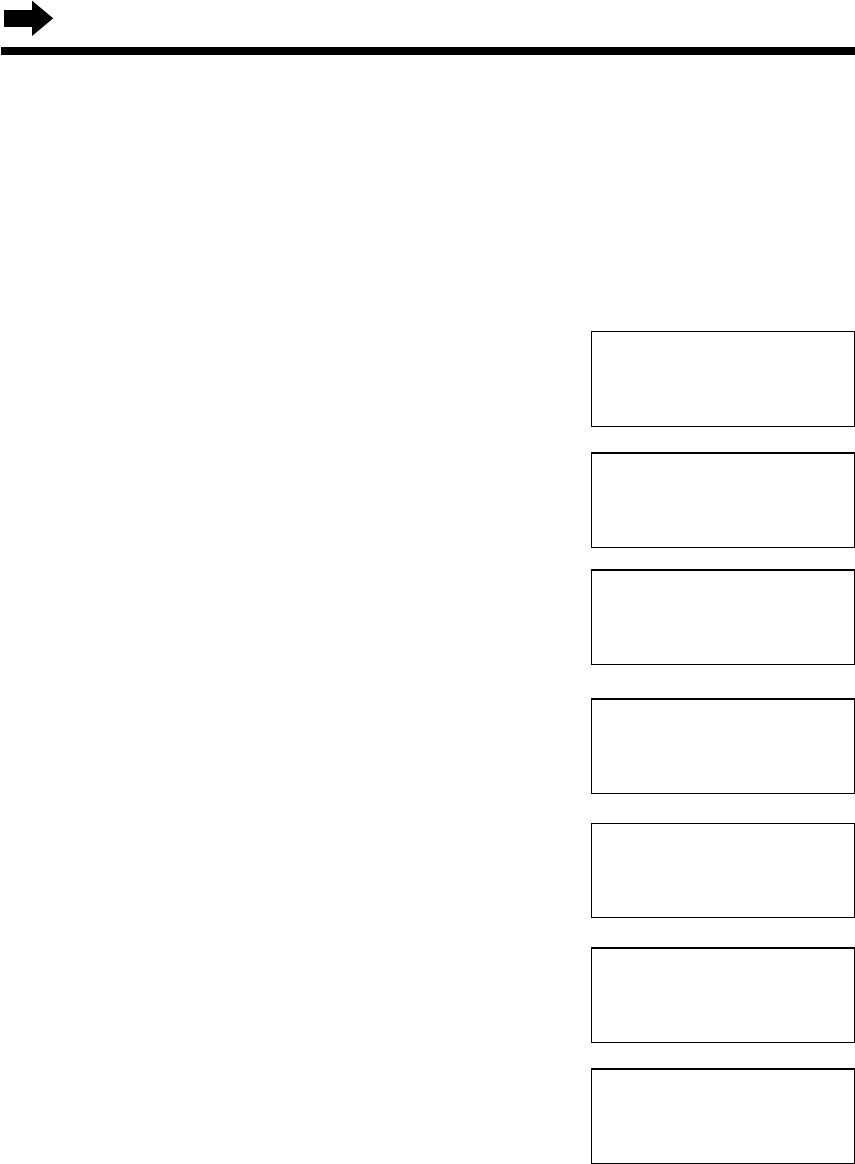
Settings
14
Selecting the Line Mode
If the line is connected to a low voltage system such as a PBX, set to “B”.
Otherwise the Call Waiting Caller ID Feature may not be used (p. 54).
Your phone comes from the factory set to “A”.
Use the handset near the base unit.
Make sure the unit is in the standby mode initially.
1Press (FUNCTION/EXIT/CH).
2Press Öor Ñrepeatedly until the arrow
points to “Program”.
3Press FWD/EDIT á(Yes key).
4Press Öor Ñrepeatedly until the arrow
points to “Set line mode”.
5Press FWD/EDIT á(Yes key).
6Press Öor Ñto select “B” or “A”.
7Press FWD/EDIT á(Save key).
•A beep sounds.
•To return to the standby mode, press
(FUNCTION/EXIT/CH).
•You can exit the programming mode any time by pressing (FUNCTION/EXIT/CH).
•If the handset has lost communication with the base unit, 3 beeps sound and “No
link to base. Place on cradle and try again.” is displayed.
H
Set line mode
Set dial mode
GF H
=Yes
Line mode
:A
GF H
=Save
Line mode
:B
H
Save directory
Ringer volume
GF H
=Yes
H
Program
GF H
=Yes
H
Save DIRECT#
Set flash time
GF H
=Yes
Line mode
:B
GF H
=Save
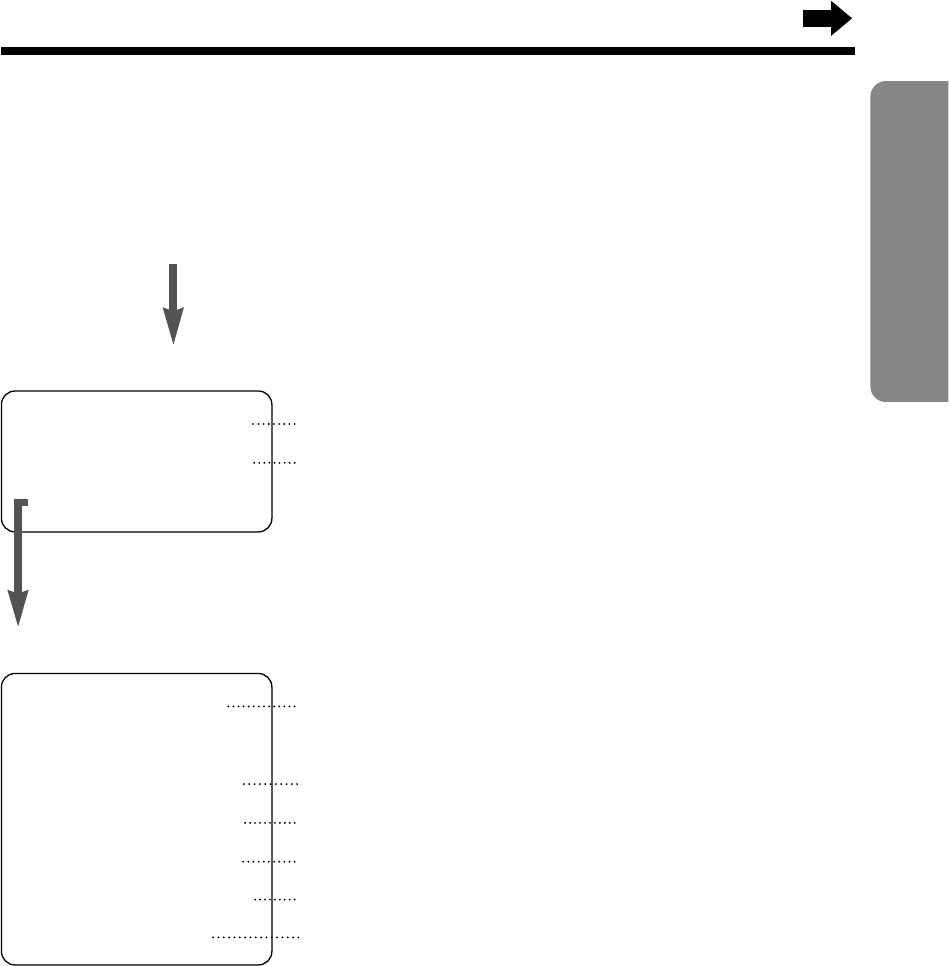
Programmable Functions
15
Preparation
H
Save DIRECT#
Set flash time
Set line mode
Set dial mode
Talk switching
TAD program
You can program the following function items using the handset near
the base unit. The display shows the programming instructions. See the
corresponding pages for function details.
Make sure the unit is in the standby mode initially.
During programming:
*To select a desired function item, press Öor Ñrepeatedly until the
arrow points to the item. Then press FWD/EDIT áto go to the next step.
•You can exit the programming mode any time by pressing (FUNCTION/EXIT/CH).
•If you do not press any buttons for 60 seconds, the unit will return to the standby
mode.
•If the handset has lost communication with the base unit, 3 beeps sound and “No
link to base. Place on cradle and try again.” is displayed.
Press (FUNCTION/EXIT/CH).
<Function menu>*
To store an item in the directory (p. 44).
To select the ringer volume (p. 17).
Press FWD/EDIT á.
To store a phone number in the DIRECT button
(p. 41).
To select the flash time (p. 55).
To select the line mode (p. 14).
To select the dial mode (p. 13).
To set the auto talk feature (p. 16).
To program answering system functions (p. 21).
H
Save directory
Ringer volume
Program
<Function menu>*
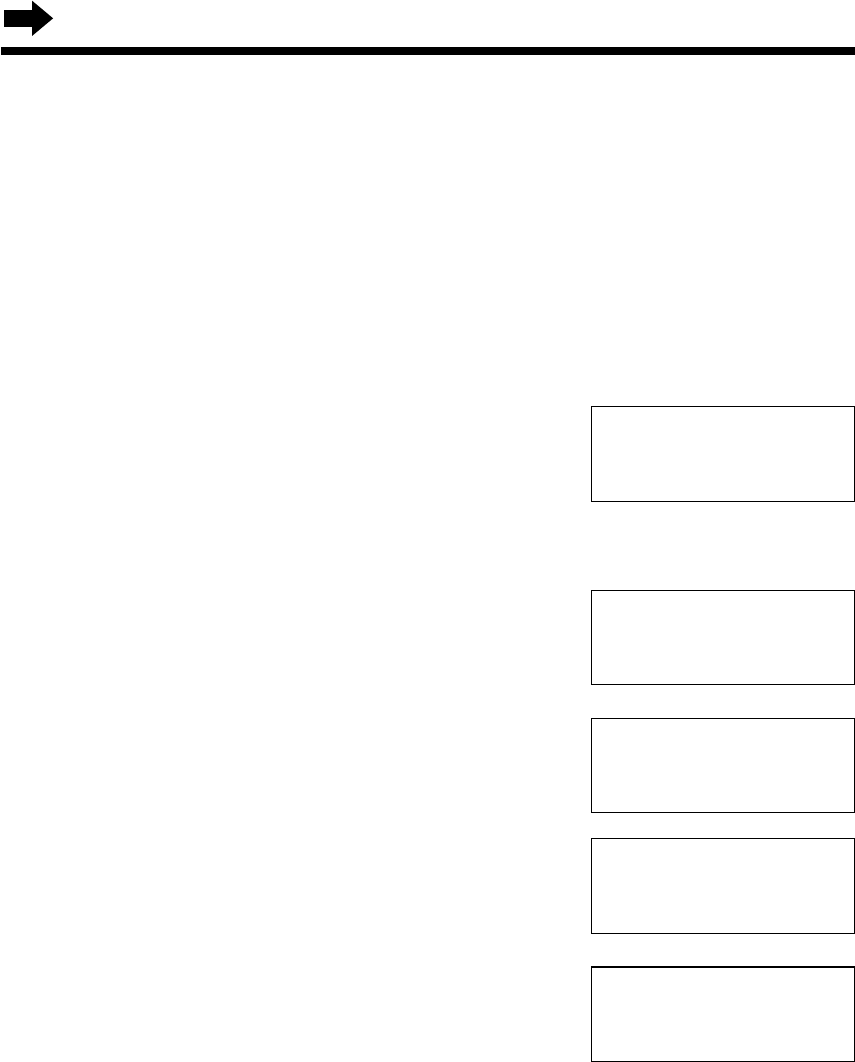
Programmable Functions
16
Setting the Auto Talk Feature
The Auto Talk feature allows you to answer a call by lifting the handset off
the base unit without pressing (TALK). If you want to use this feature, turn
the feature ON by programming. Your phone comes from the factory set
to OFF.
Make sure the unit is in the standby mode initially.
1Press (FUNCTION/EXIT/CH).
2Press Öor Ñrepeatedly until the arrow
points to “Program”.
3Press FWD/EDIT á(Yes key).
4Press Öor Ñrepeatedly until the arrow
points to “Talk switching”.
5Press FWD/EDIT á(Yes key).
6Press Öor Ñto select “On” or “Off”.
7Press FWD/EDIT á(Save key).
•A beep sounds.
•To return to the standby mode, press
(FUNCTION/EXIT/CH).
•You can exit the programming mode any time by pressing (FUNCTION/EXIT/CH).
•In order to view Caller ID information before answering a call, leave the Auto Talk
feature OFF.
Auto talk
:On
H
Program
GF H
=Yes
H
Talk switching
TAD program
GF H
=Yes
Auto talk
:Off
GF H
=Save
Auto talk
:On
GF H
=Save
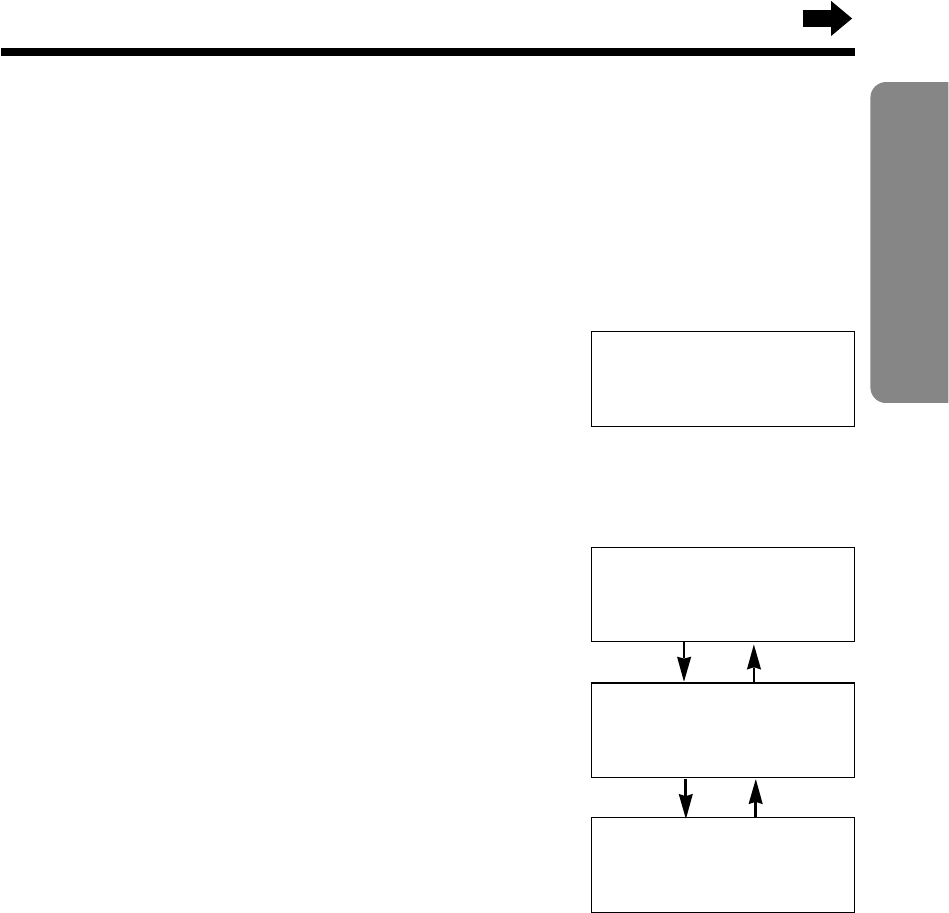
17
Preparation
Selecting the Ringer Volume
With the handset
You can set the handset ringer volume to HIGH, LOW or OFF. If set to
OFF, the handset will not ring. Your phone comes from the factory set to
HIGH.
Make sure the unit is in the standby mode initially.
1Press (FUNCTION/EXIT/CH).
2Press Öor Ñrepeatedly until the
arrow points to “Ringer volume”.
3Press FWD/EDIT á(Yes key).
4Press Öor Ñto select the
desired volume.
•The selected volume is displayed and
rings.
•To turn the ringer OFF, press and
hold Öuntil 2 beeps sound.
To turn the ringer ON, press Ñor Ö
in step 4.
•The ringer will sound at the LOW level.
•You can also select the ringer volume while a call is being received. Press Öor
Ñwhile the unit is ringing.
•When set to OFF, “Ringer off” will flash for about 45 seconds before the
handset returns to the standby mode.
•When you replace the battery, the selected ringer volume setting will return to the
factory set (HIGH). Reprogram if necessary.
Save directory
H
Ringer volume
GF H
=Yes
Ringer
Low ❚❚❚❚❚❚ High
GF
Ringer
Low ❚❚❚❚❚❚ High
GF
HIGH
LOW
Ringer off
OFF
ÖÑ
ÖÑ
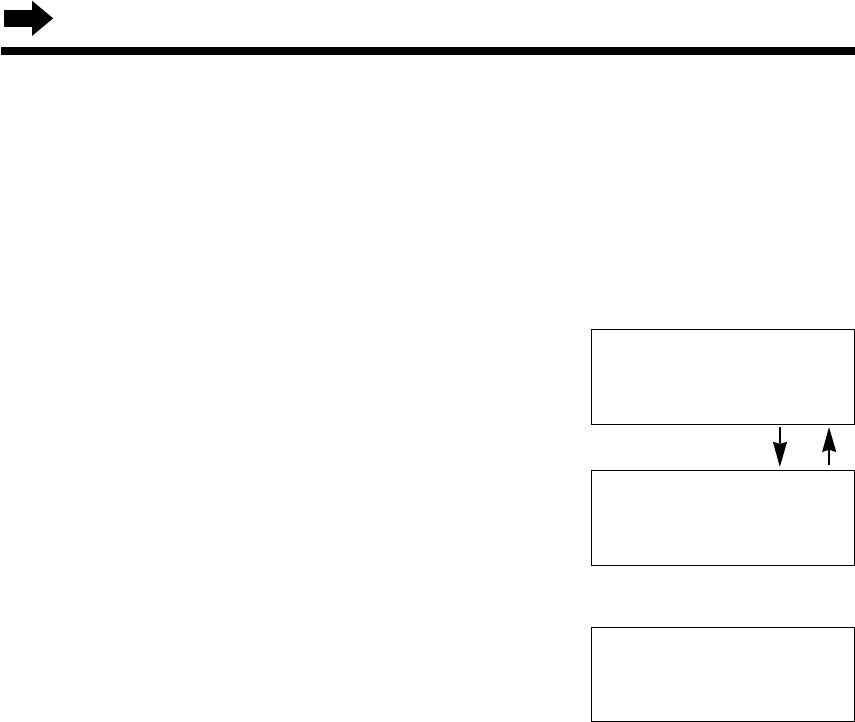
Programmable Functions
18
With the base unit
You can set the base unit ringer volume to HIGH, LOW or OFF. If set to
OFF, the base unit will not ring. Your phone comes from the factory set to
HIGH.
Make sure the unit is in the standby mode initially. (You can also select
the ringer volume while a call is being received.)
To select HIGH or LOW, press
(HOLD/RINGER).
•Each time you press the button, the selected
ringer volume will be displayed and ring.
To turn the ringer OFF, press and hold
(HOLD/RINGER) until 2 beeps sound.
•“Ringer off” will be displayed.
To turn the ringer ON, press
(HOLD/RINGER).
•The ringer will sound at the HIGH level.
Ringer
Low ❚❚❚❚❚❚ High
Ringer
Low ❚❚❚❚❚❚ High
HIGH
LOW
Ringer off
OFF
(HOLD/RINGER)
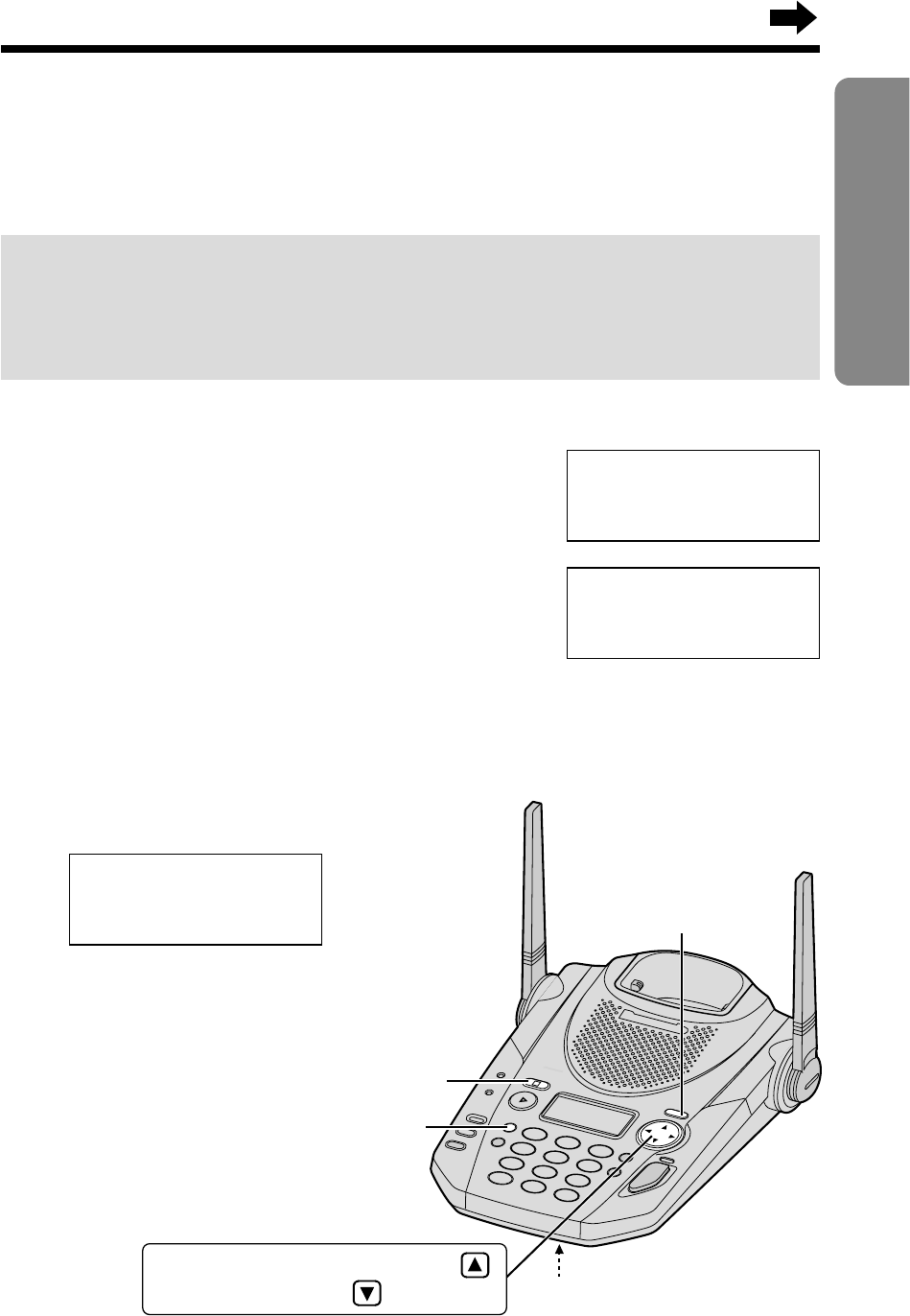
19
Preparation
Preparing the Answering System
Greeting Message
You can record a personal greeting message of up to 2 minutes. If a
greeting message is not recorded, one of two pre-recorded greetings will
be played when a call is received (p. 20).
All messages (greeting, incoming, etc.) are stored in digital memory
(p. 20). The total recording time is about 15 minutes.
We recommend you record a brief greeting message (see sample on
next page) in order to leave more time for recording new messages.
To record a greeting message
1Press and hold (GREETING/EDIT) until a
long beep is heard.
2Talk clearly, about 8 inches (20 cm) away
from the MIC (microphone).
•The base unit display shows the elapsed
recording time.
•If you record for over 2 minutes, the unit will
automatically stop recording.
3When finished, press (STOP/EXIT).
•To check the recorded greeting,
press (GREETING/EDIT).
•To change the message,
start again from step 1.
Greeting record
00-00
Greeting record
00-12
Greeting check
00-12
MIC
To increase the volume, press .
To decrease, press .
(GREETING/EDIT)
(STOP/EXIT)
(ERASE)
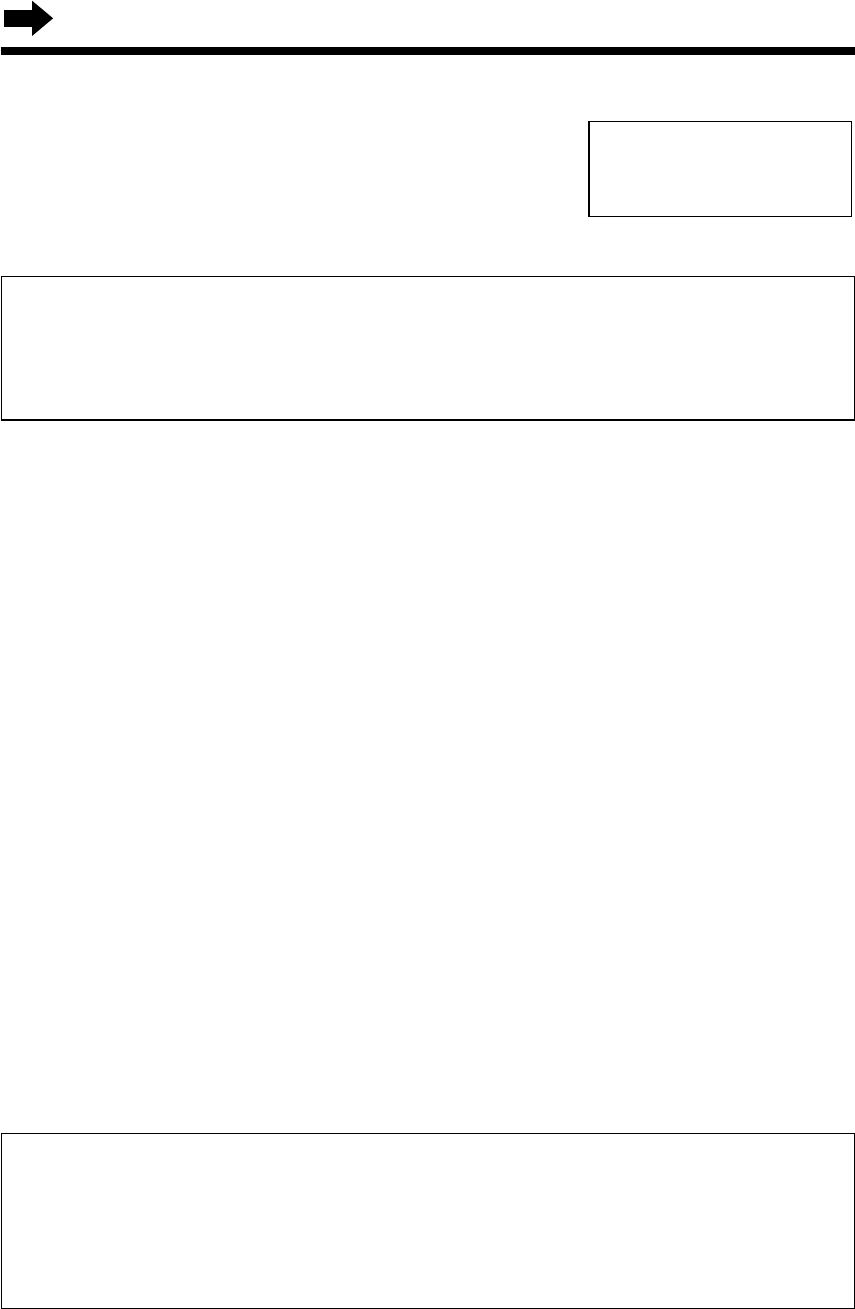
20
Preparing the Answering System
To erase the recorded greeting message
Press (GREETING/EDIT) \press (ERASE) while the message is being
played.
•The unit will answer a call with a pre-recorded greeting.
Pre-recorded greeting message
If you do not record a greeting message (p. 20), one of two messages will
be played when a call is received, depending on the caller’s recording
time (p. 24).
To check the pre-recorded greeting, press (GREETING/EDIT).
•A pre-recorded greeting will be played as follows:
■ When the recording time is set to “1 minute” or “3 minutes”:
“Hello, we are not available now. Please leave your name and phone number
after the beep. We will return your call.”
■ When the recording time is set to “Greeting only”:
“Hello, we are not available now. Please call again. Thank you for your call.”
Flash Memory Message Backup
Messages are stored on a “flash memory” IC chip and will not be
affected by power failures. All messages are saved until you erase
them.
Greeting message sample
“Hello, this is (your name and/or number). Sorry I cannot take your
call. Please leave a message after the beep. Thank you.”
To adjust the speaker volume:
9 levels (0–8) are available while using the
answering system. To increase, press Ñ.
To decrease, press Ö.
Loud
Low ❚❚❚❚❚❚❚❚High
Ex. Level 8
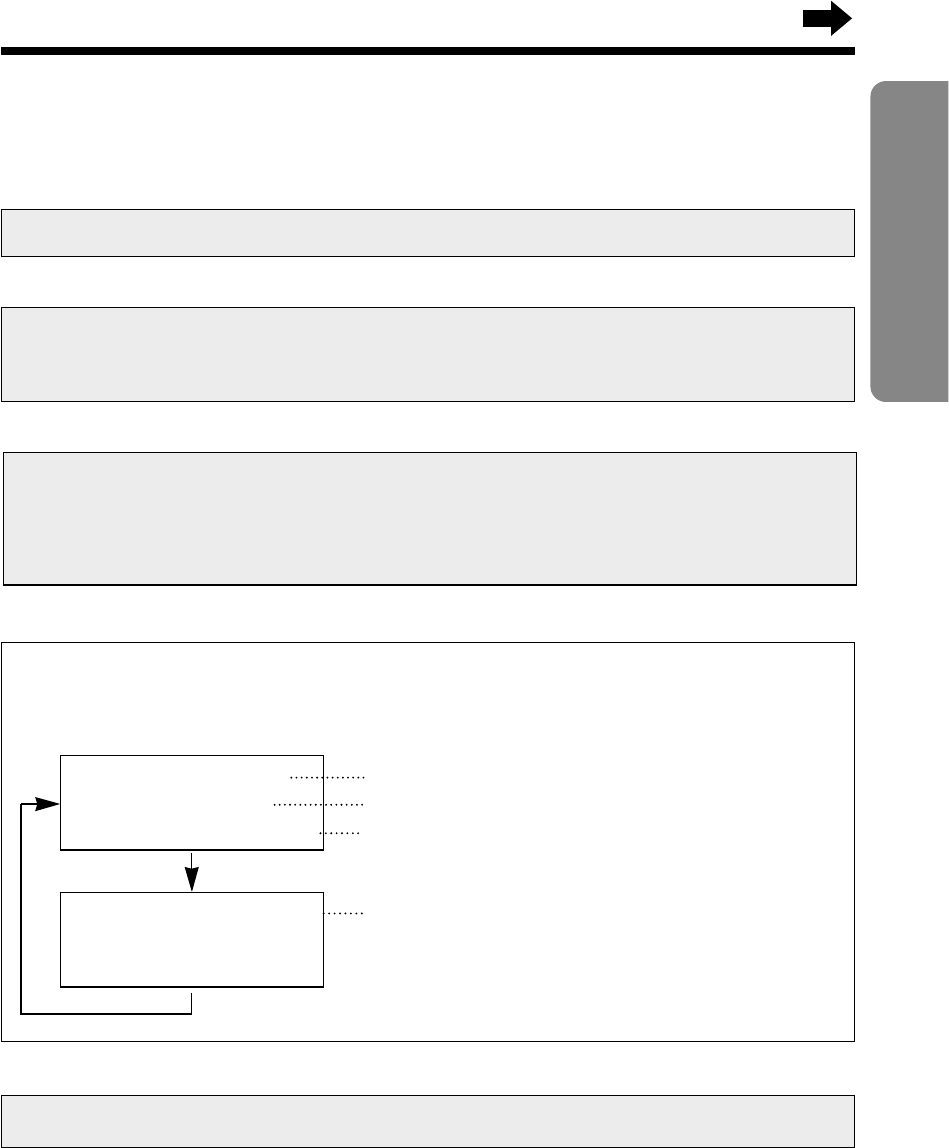
21
Preparation
The base unit display shows programming options. Enter a required
command on the display using the handset dialing buttons. See the
page numbers for details.
Programming Summary for the Answering System
You can program the following functions using the handset near the
base unit. Make sure the unit is in the standby mode initially.
•You can exit the programming mode any time by pressing (FUNCTION/EXIT/CH).
•If you do not press any buttons for 60 seconds, the unit will return to the standby
mode.
•If 6 beeps sound on the base unit during programming, a wrong key was
pressed. Enter the correct number.
•If the handset has lost communication with the base unit, 3 beeps sound and “No
link to base. Place on cradle and try again.” is displayed on the
handset.
0=Day and time
1=Remote code
2=Number of ring
5=Recording time
Press (FUNCTION/EXIT/CH).
Press FWD/EDIT á(Save key).
Press Öor Ñto select “TAD program”, and press FWD/EDIT á
(Yes key).
•“Answering system setting. See base unit.” is displayed on the
handset.
G
G
Adjusts the day and time (p. 22).
Sets the remote code (p. 61).
Selects the number of rings (p. 25).
Selects the caller’s recording time (p. 24).
G
*The display will change every 3 seconds.
*
*
Press Öor Ñto select “Program”, and press FWD/EDIT á(Yes
key).
G
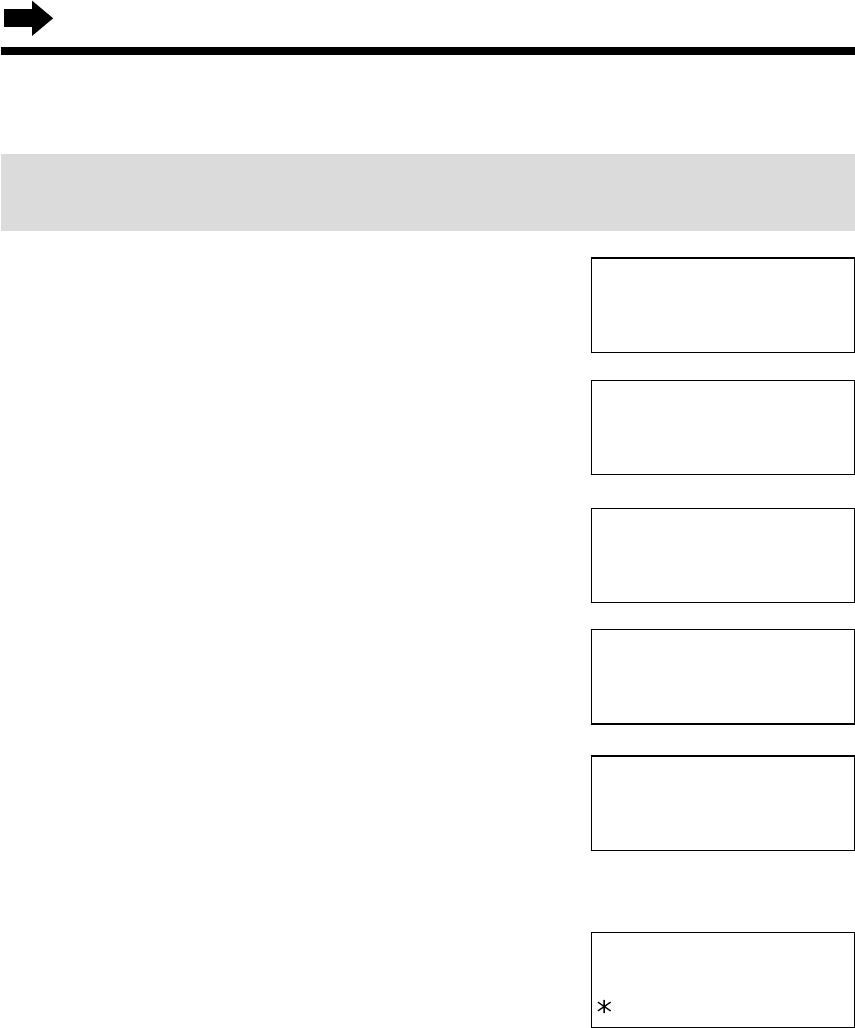
22
Preparing the Answering System
1Press (FUNCTION/EXIT/CH).
2Press Öor Ñrepeatedly until the arrow
points to “Program”.
3Press FWD/EDIT á(Yes key).
4Press Öor Ñrepeatedly until the arrow
points to “TAD program”.
5Press FWD/EDIT á(Yes key).
•The base unit display shows programming
options.
6Press (0).
•“Set time” is announced.
If previously adjusted, the day/time will be
heard.
7Enter the time (hour and minute) using a 4-digit number.
(Ex. To set 9:30, enter “0930”.)
8Press (*) to select “AM” or “PM”.
Press (#) repeatedly to set the day.
Day and Time Adjustment
Voice Time/Day Stamp: During playback, a synthesized voice will
announce the day and time that each message was recorded.
SUN 12:00 AM
=AM/PM #=Day
Base unit display
H
Program
GF H
=Yes
H
Save DIRECT#
Set flash time
GF H
=Yes
Talk switching
H
TAD program
GF H
=Yes
Answering
system setting.
See base unit.
H
Save directory
Ringer volume
GF H
=Yes
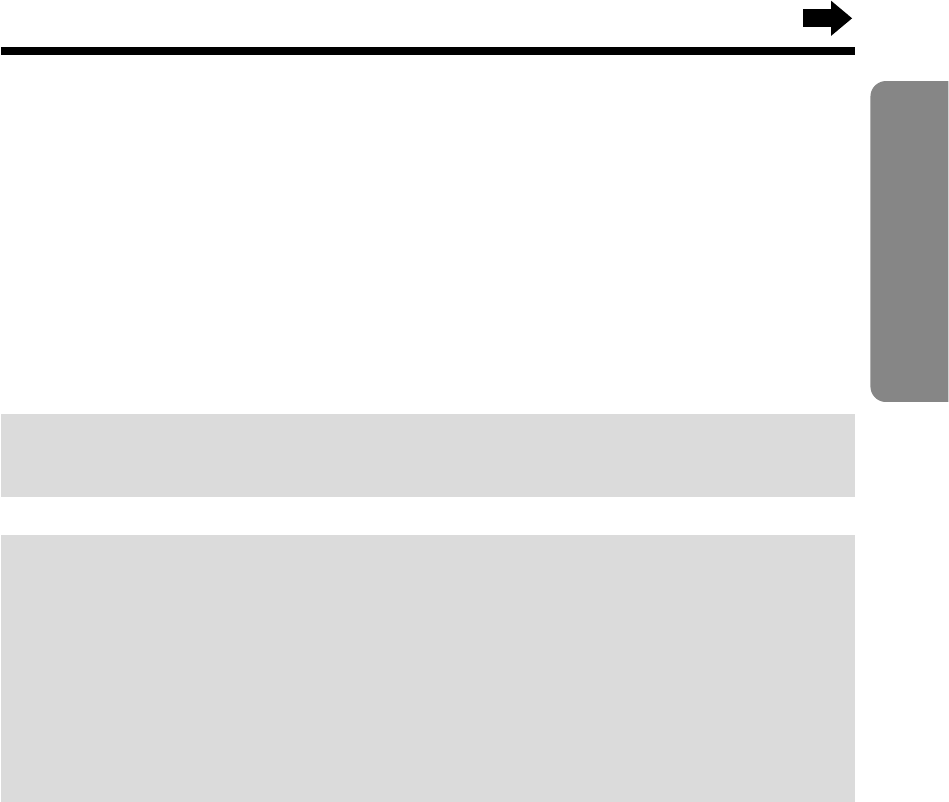
23
Preparation
9Press FWD/EDIT á(Save key).
•The unit announces the day/time. The clock starts working.
•If 6 beeps sound, the setting is not correct. Start again from step 5.
•To return to the standby mode, press (FUNCTION/EXIT/CH).
•In step 7, you cannot enter numbers greater than 12. Do not use military time.
(To set 13:00 hours, enter “0100”, and select “PM” by pressing (*).)
If a power failure occurs, the adjusted day/time will be erased. Readjust
the day/time.
For Caller ID service users (p. 32)
•The Caller ID information will re-set the clock after the first ring if the adjusted
time is incorrect. However, the day will not be re-set. Set the day following the
procedures on pages 22 and 23.
•If the time has not previously been set, the Caller ID information will not adjust
the clock.
•The Caller ID information will automatically adjust the clock for daylight saving
time.
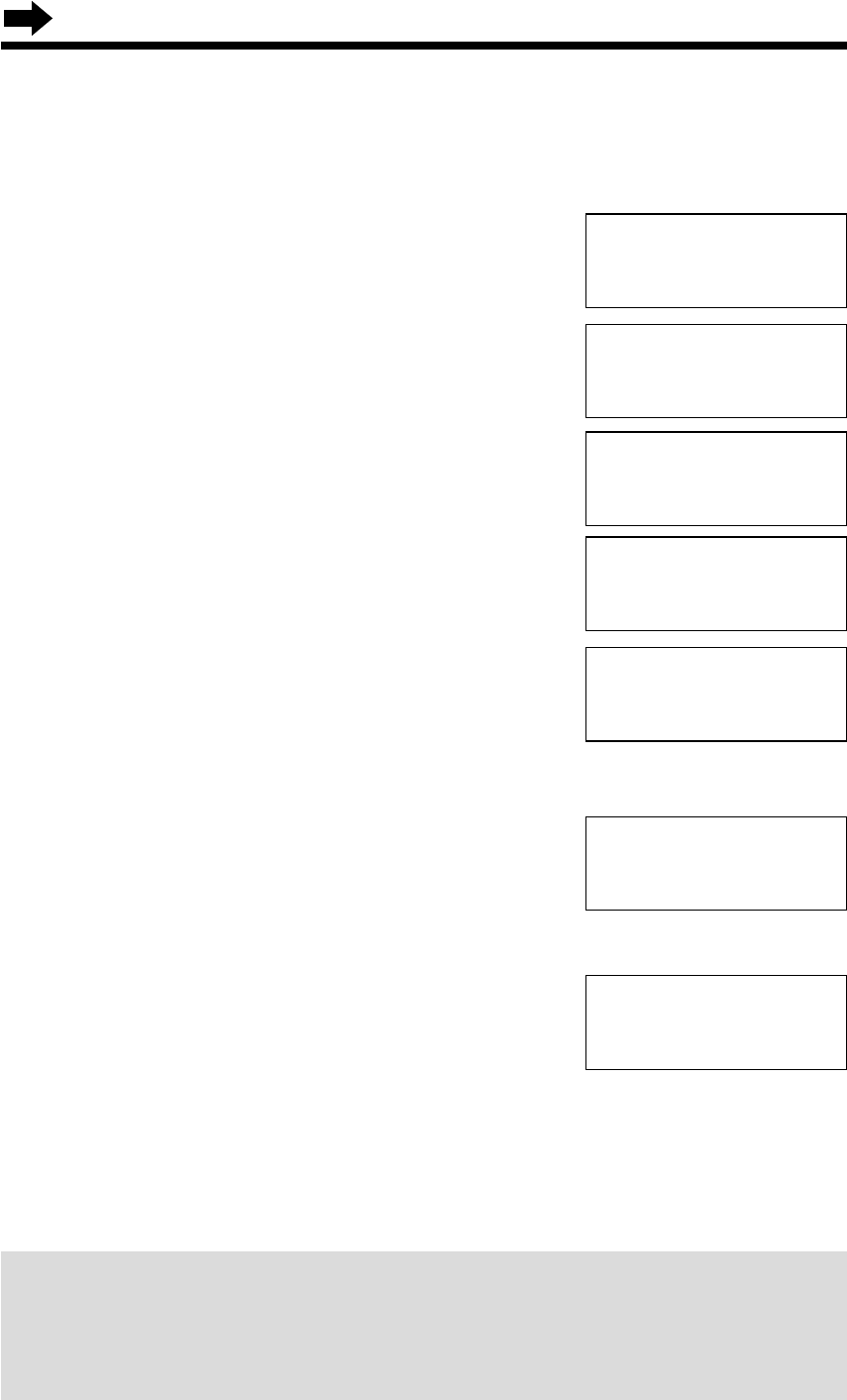
24
Selecting the Caller’s Recording Time
You can select “1 minute”, “3 minutes” or “Greeting only” for the caller’s
recording time. Your phone comes from the factory set to “3 minutes”.
1Press (FUNCTION/EXIT/CH).
2Press Öor Ñrepeatedly until the arrow
points to “Program”.
3Press FWD/EDIT á(Yes key).
4Press Öor Ñrepeatedly until the arrow
points to “TAD program”.
5Press FWD/EDIT á(Yes key).
•The base unit display shows programming
options.
6Press (5).
•The current setting is displayed on the base
unit.
7Press (1), (2) or (3) to select the recording
time.
1: 1 minute
2: 3 minutes
3: Greeting only
8Press FWD/EDIT á(Save key).
•A beep sounds.
•To return to the standby mode, press (FUNCTION/EXIT/CH).
If you select “Greeting only”, the unit will answer a call with the greeting
message, and then hang up. The unit will not record any incoming
messages. The base unit display will show “Greeting only” in the
standby mode.
H
Program
GF H
=Yes
H
Save DIRECT#
Set flash time
GF H
=Yes
Talk switching
H
TAD program
GF H
=Yes
Answering
system setting.
See base unit.
H
Save directory
Ringer volume
GF H
=Yes
Recording time
:3min
Base unit display
Recording time
:Greeting only
Base unit display
Preparing the Answering System
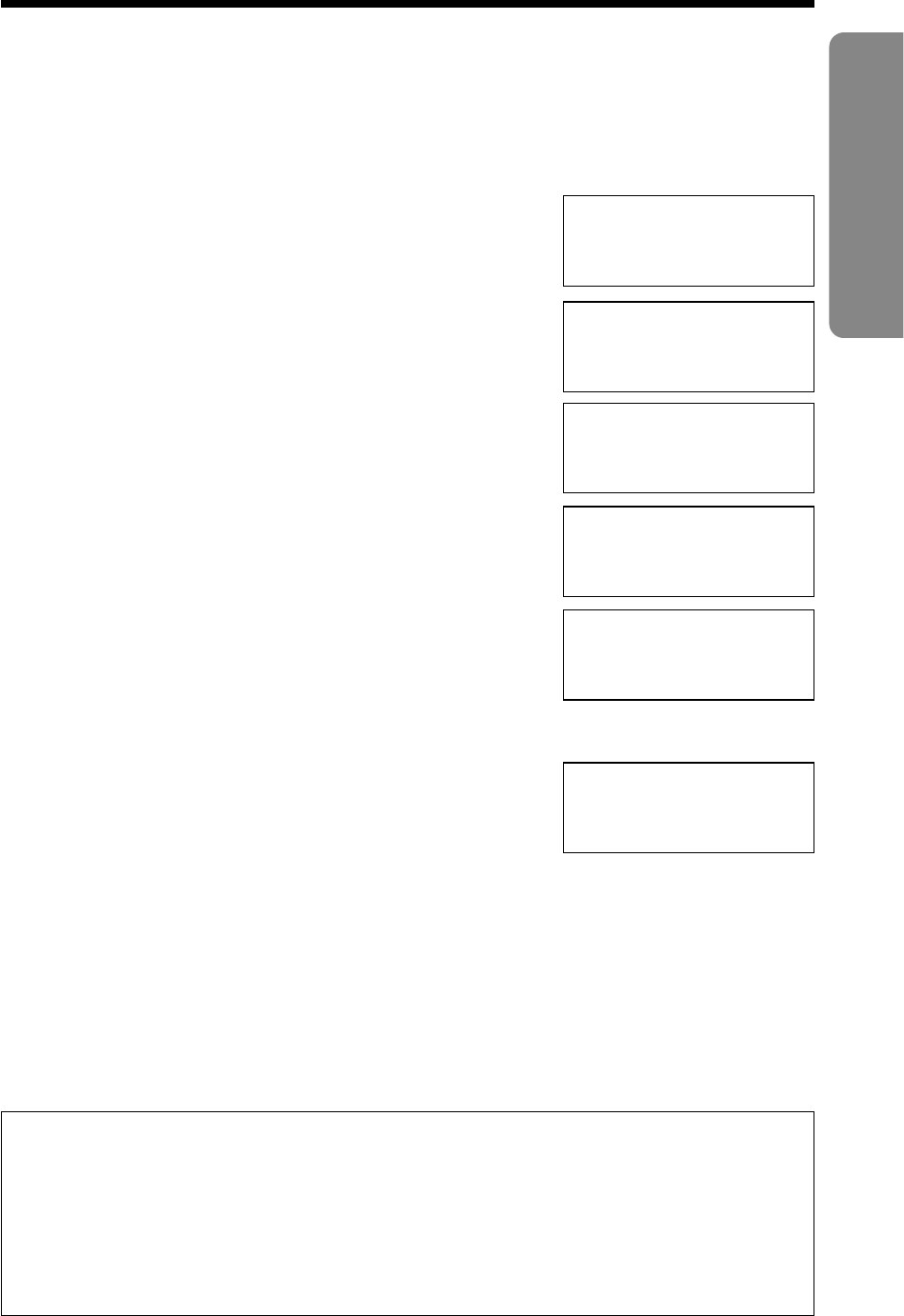
25
Preparation
Selecting the Number of Rings
You can select the number of times the unit rings before the answering
system answers a call, from “2” to “7” or “Toll saver”*.
Your phone comes from the factory set to “Toll saver”*.
1Press (FUNCTION/EXIT/CH).
2Press Öor Ñrepeatedly until the arrow
points to “Program”.
3Press FWD/EDIT á(Yes key).
4Press Öor Ñrepeatedly until the arrow
points to “TAD program”.
5Press FWD/EDIT á(Yes key).
•The base unit display shows programming
options.
6Press (2).
•The current setting is displayed on the base
unit.
7Press (0), or (2) to (7) to set the number of rings.
0: Selects “Toll saver”*.
2–7: The unit will answer after the selected number of rings.
8Press FWD/EDIT á(Save key).
•A beep sounds.
•To return to the standby mode, press (FUNCTION/EXIT/CH).
*Toll saver
When you call the unit from a touch tone telephone:
If the unit answers on the 2nd ring, there is at least one new message.
If the unit answers on the 4th ring, there are no new messages.
Hang up when you hear the 3rd ring. This will save you the toll
charge for the call.
H
Program
GF H
=Yes
H
Save DIRECT#
Set flash time
GF H
=Yes
Talk switching
H
TAD program
GF H
=Yes
Answering
system setting.
See base unit.
H
Save directory
Ringer volume
GF H
=Yes
Number of rings
:Toll saver
Base unit display
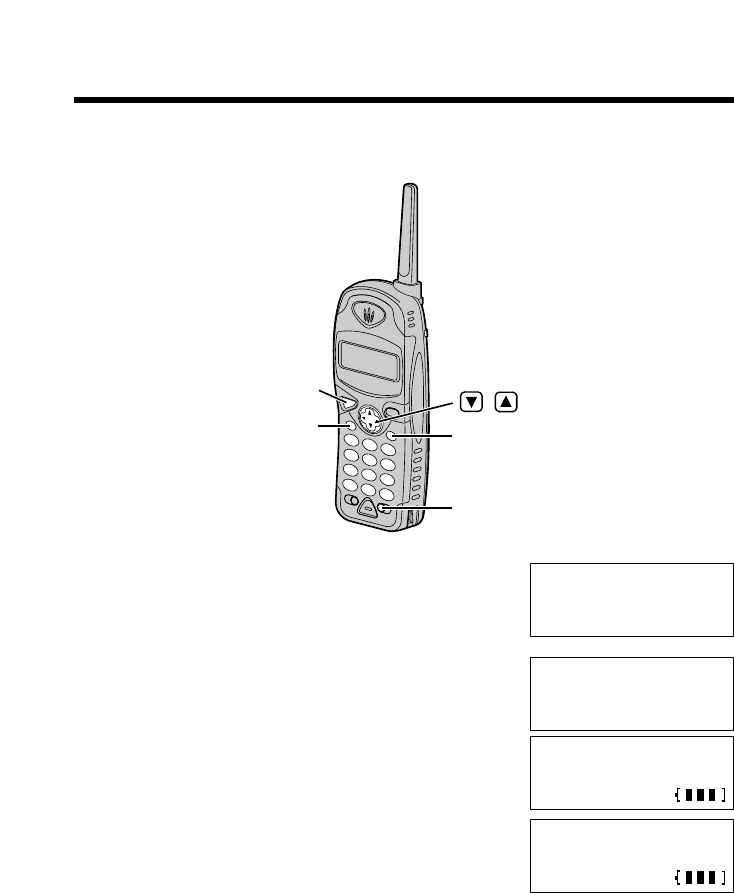
Making Calls
26
1Press (TALK).
2Dial a phone number.
•The dialed number is displayed.
•After a few seconds, the display will show the
length of the call and the battery strength.
3To hang up, press (TALK) or place the
handset on the base unit.
•If the handset has lost communication with the base unit, 3 beeps sound and “No
link to base. Place on cradle and try again.” is displayed.
If noise interferes with the conversation
Press (FUNCTION/EXIT/CH) to select a clearer channel or move closer to
the base unit.
To redial the last number dialed on the handset
Press (TALK) and press (REDIAL/PAUSE).
Talk
1112222
Talk
00-00-00
Talk
With the Handset
Off
00-01-08
(TALK)
(FUNCTION/EXIT/CH) (INTERCOM/CLEAR)
(REDIAL/PAUSE)
,
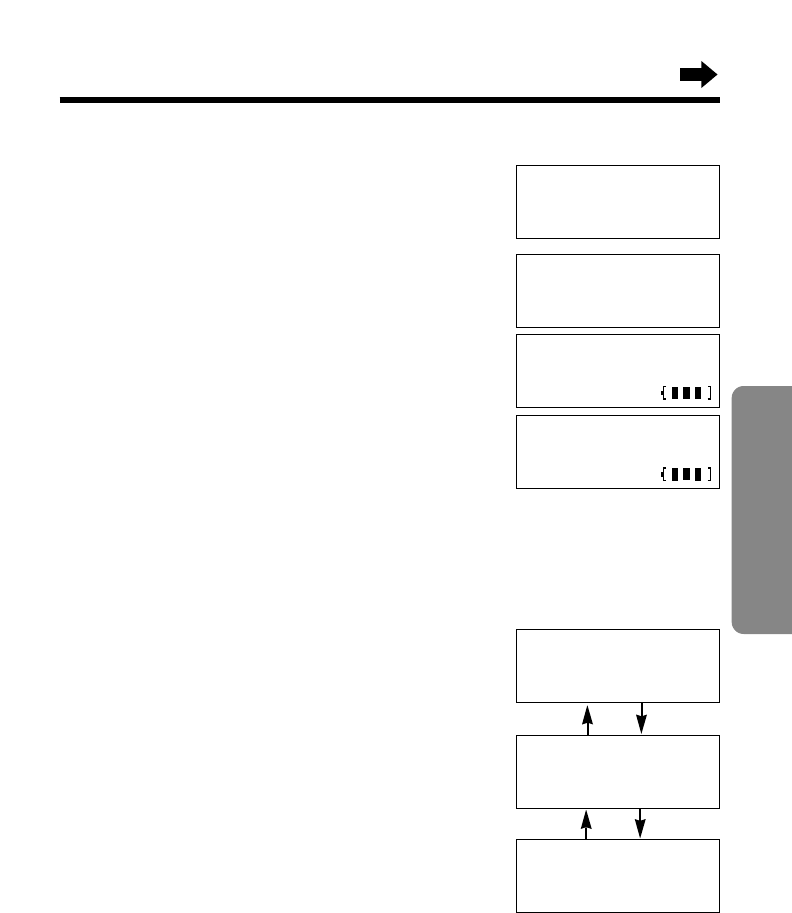
27
Cordless Telephone
To dial after confirming the entered number
1Dial a phone number.
•If you misdial, press (INTERCOM/CLEAR) and
dial again.
2Press (TALK).
•After a few seconds, the display will show the
length of the call and the battery strength.
3To hang up, press (TALK) or place the
handset on the base unit.
To redial after confirming the last number dialed
Press (REDIAL/PAUSE) and press (TALK).
To adjust the receiver volume while talking
To increase, press Ñ.
To decrease press Ö.
•Each time you press Öor Ñ, the
volume level will change.
•The display will return to the length of
the call.
Lighted handset keypad
The handset dialing buttons will light when you press a button or lift the
handset off the base unit, and flash when a call is received. The lights will
go out a few seconds after pressing a button, lifting the handset or
answering a call.
Backlight LCD display
The lighted handset display will stay on for a few seconds after pressing a
handset button or lifting the handset off the base unit.
Talk
3334444
Talk
00-00-00
Loud
Low ❚❚❚❚❚❚ High
3334444
MEDIUM
HIGH
LOW
Loud
Low ❚❚❚❚ High
Loud
Low ❚❚ High
Off
00-01-08
ÖÑ
ÖÑ
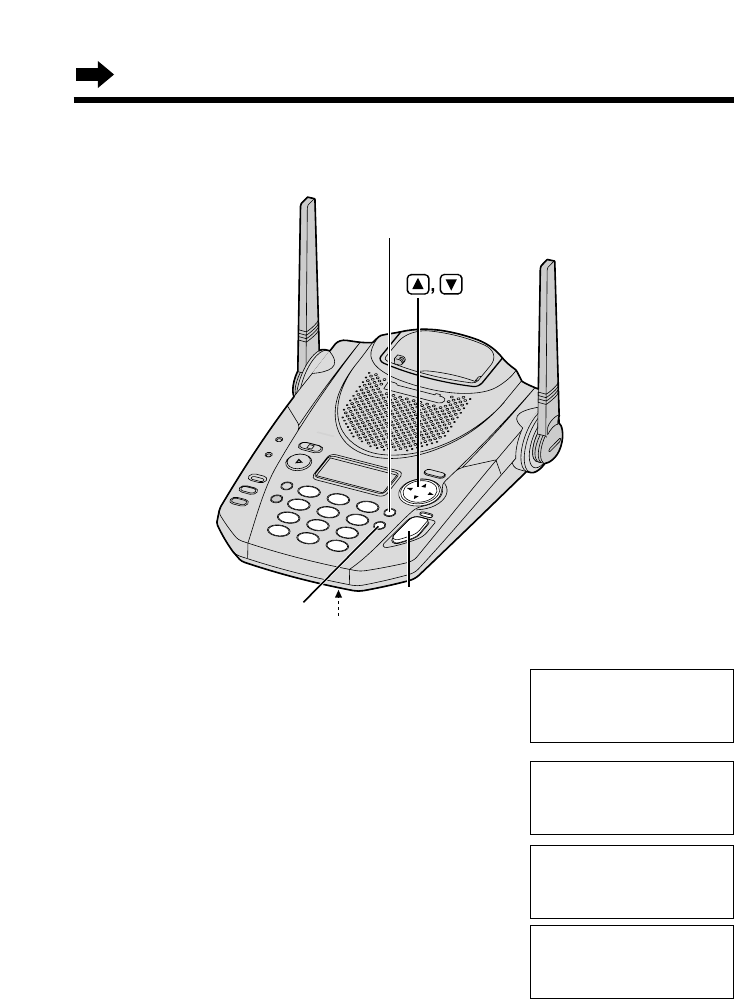
28
Making Calls
1Press (DIGITAL!SP-PHONE).
•The DIGITAL SP-PHONE indicator
lights.
2Dial a telephone number.
3When the other party answers,
talk into the MIC (microphone).
4To hang up, press (DIGITAL!SP-PHONE).
•The indicator light goes out.
•To switch to the handset while using the base unit speakerphone:
—If the handset is off the base unit, press (TALK).
—If on the base unit, just lift up.
•During a call using the handset, the call can be switched to the speakerphone by
pressing (DIGITAL!SP-PHONE).
Talk
1112222
Talk
00-00-00
Talk
With the Base Unit (Digital Duplex Speakerphone)
MIC
(DIGITAL!SP-PHONE)
and Indicator
(HOLD/RINGER)
(REDIAL/PAUSE)
Off
00-00-00
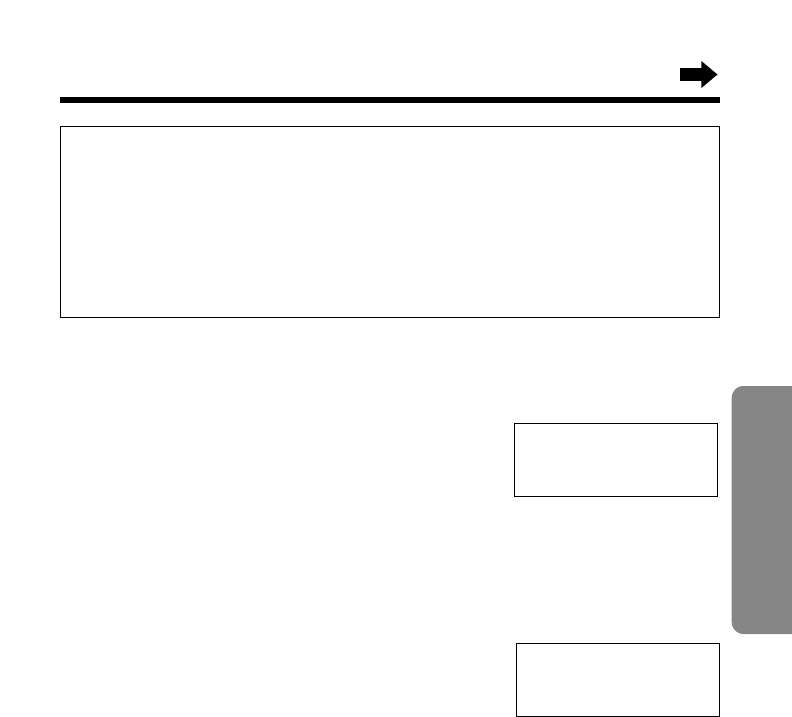
29
Cordless Telephone
Hands-free Digital Duplex Speakerphone
For best performance, please note the following:
•Talk alternately with the caller in a quiet room.
•If the other party has difficulty hearing you, press Öto decrease the
speaker volume.
•If the other party’s voice from the speaker cuts in/out during a
conversation, press Öto decrease the speaker volume.
To adjust the speaker volume (8 levels) while talking
To increase, press Ñ.
To decrease, press Ö.
To redial the last number dialed on the base unit
Press (DIGITAL!SP-PHONE) and press (REDIAL/PAUSE).
To put a call on hold
Press (HOLD/RINGER).
•The DIGITAL SP-PHONE indicator flashes.
To release the hold
From the base unit, press (DIGITAL!SP-PHONE).
From the handset, press (TALK) or lift the handset off the base unit.
•If another phone is connected on the same line (p. 79), you can also release the
hold by lifting its handset.
Loud
Low ❚❚❚❚❚❚❚❚High
Hold
Ex. Level 8
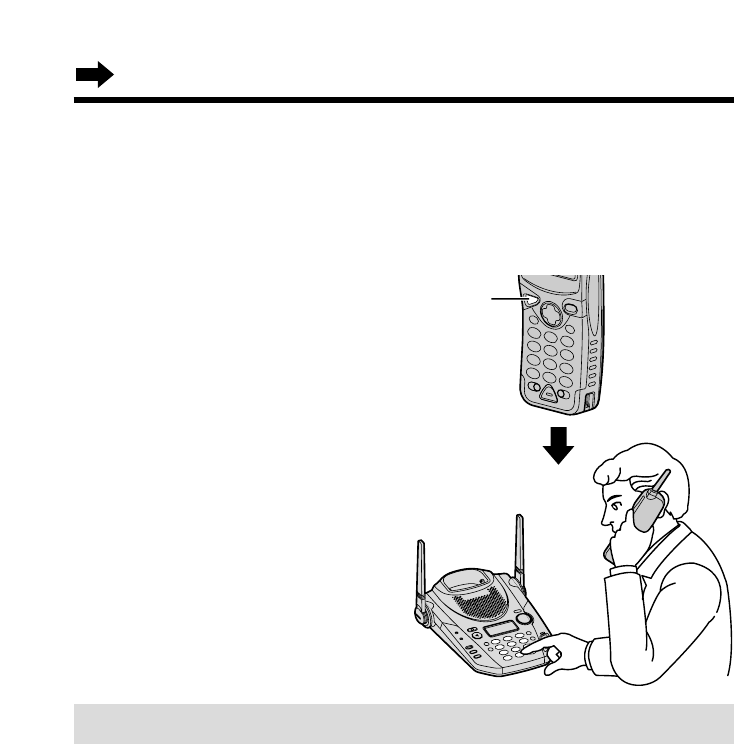
30
Making Calls
Simultaneous Keypad Dialing
You can use the base unit like a standard telephone. After pressing
(TALK) to make a call with the handset near the base unit, you can also
dial using the base unit keypad.
1Handset:
Press (TALK).
2Base unit:
Dial a telephone number while
hearing a dial tone on the
handset.
•When the other party answers, talk
using the handset.
3Handset:
To hang up, press (TALK) or
place the handset on the base
unit.
Useful information
You can enter numbers using the base unit keypad during a call with the
handset. For example, to access an answering service, electronic banking
service, etc.
1. Handset:
Press (TALK).
2. Handset:
Dial a telephone number.
•You can also dial with the base unit keypad.
3. Base unit:
Enter the required numbers while listening to the pre-recorded
instructions.
4. Handset:
To hang up, press (TALK) or place the handset on the base unit.
Simultaneous Keypad Dialing is only possible after pressing (TALK).
(TALK)
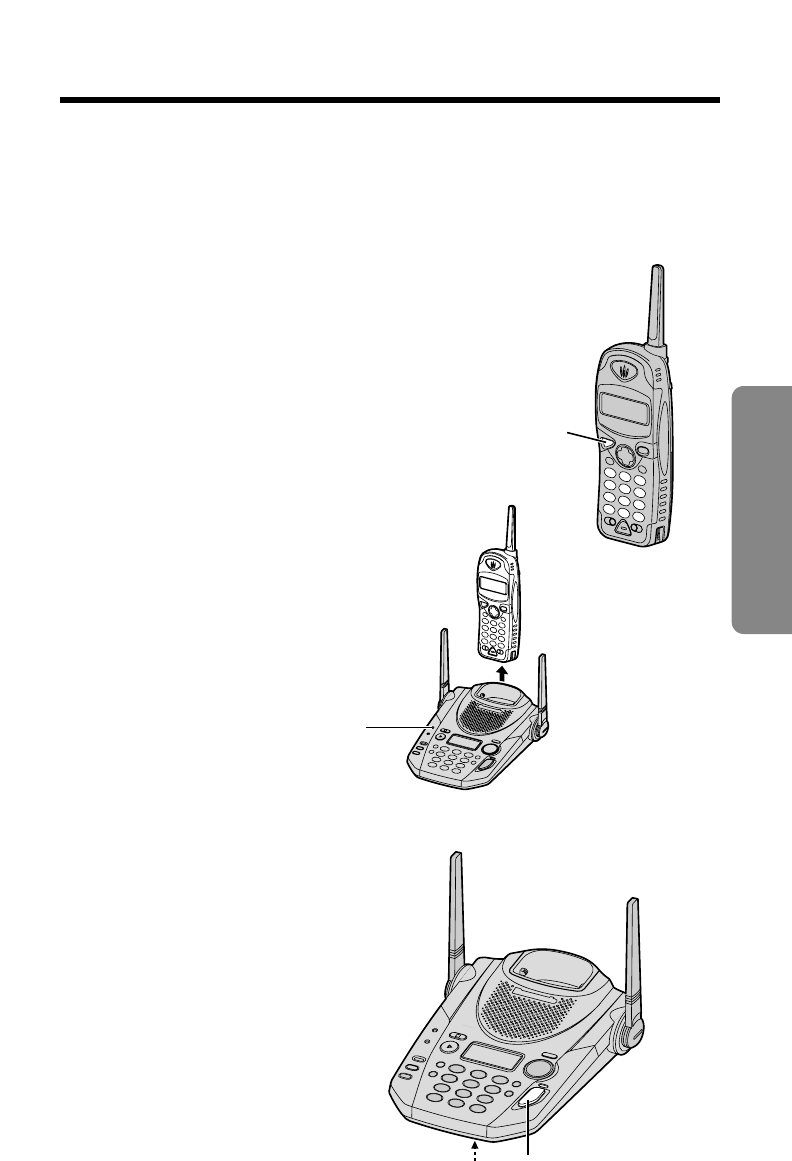
With the Base Unit (Digital Duplex Speakerphone)
1Press (DIGITAL!SP-PHONE).
2Talk into the MIC.
3To hang up, press
(DIGITAL!SP-PHONE).
31
Cordless Telephone
Answering Calls
When a call is received, the unit rings, “Incoming call” is displayed
and the CALLER ID indicator flashes quickly.
If you subscribe to a Caller ID service, the calling party information will be
displayed after the first ring (p. 32). In order to view the Caller ID
information, please wait until the second ring to answer a call.
With the Handset
If the handset is off the base unit,
press (TALK).
•You can also answer a call by pressing any dialing
button (0) to (9), (*) or (#) (—Any Key Talk).
Auto Talk
If you set the Auto Talk feature to ON
(p. 16), you can answer a call by lifting
the handset off the base unit without
pressing (TALK).
(TALK)
CALLLER ID
Indicator
MIC (DIGITAL!SP-PHONE)
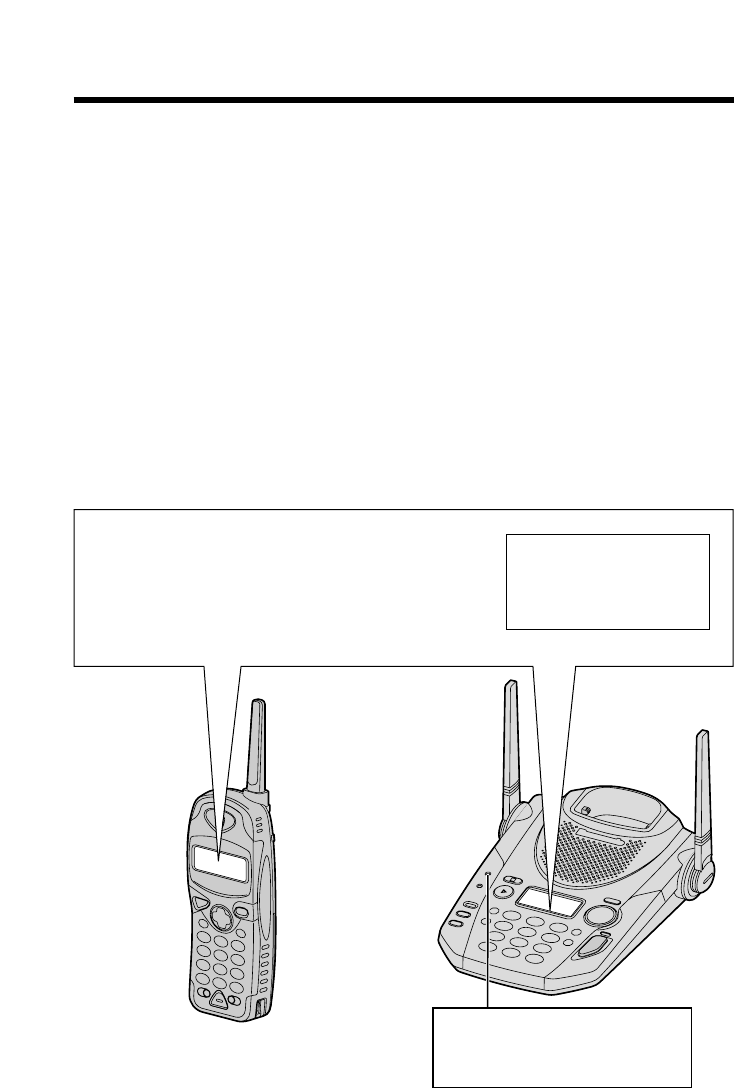
32
Caller ID Service
This unit is compatible with a Caller ID service offered by your telephone
company. If you subscribe to a Caller ID service, the calling party’s
information will be shown on the handset and base unit displays after the
first ring.
The unit can record information of up to 50 different callers in the Caller
List. The Caller List information is sorted by the most recent to the oldest
call. When the 51st call is received, the first call is deleted.
Using the list, you can automatically call back a caller. You can store the
callers’ names and numbers from the Caller List into the directory.
If you subscribe to both Caller ID and Call Waiting services, when a
second call is received while talking, the new caller’s name and phone
number will be displayed (p. 54).
How caller information is displayed when a call is
received
The CALLER ID indicator
light will flash quickly when a
call is being received
The handset and base unit displays
show the caller’s name and number after
the first ring.
•After you answer the call, the display will show
the length of the call.
TINA ROBINSON
1-000-222-3333
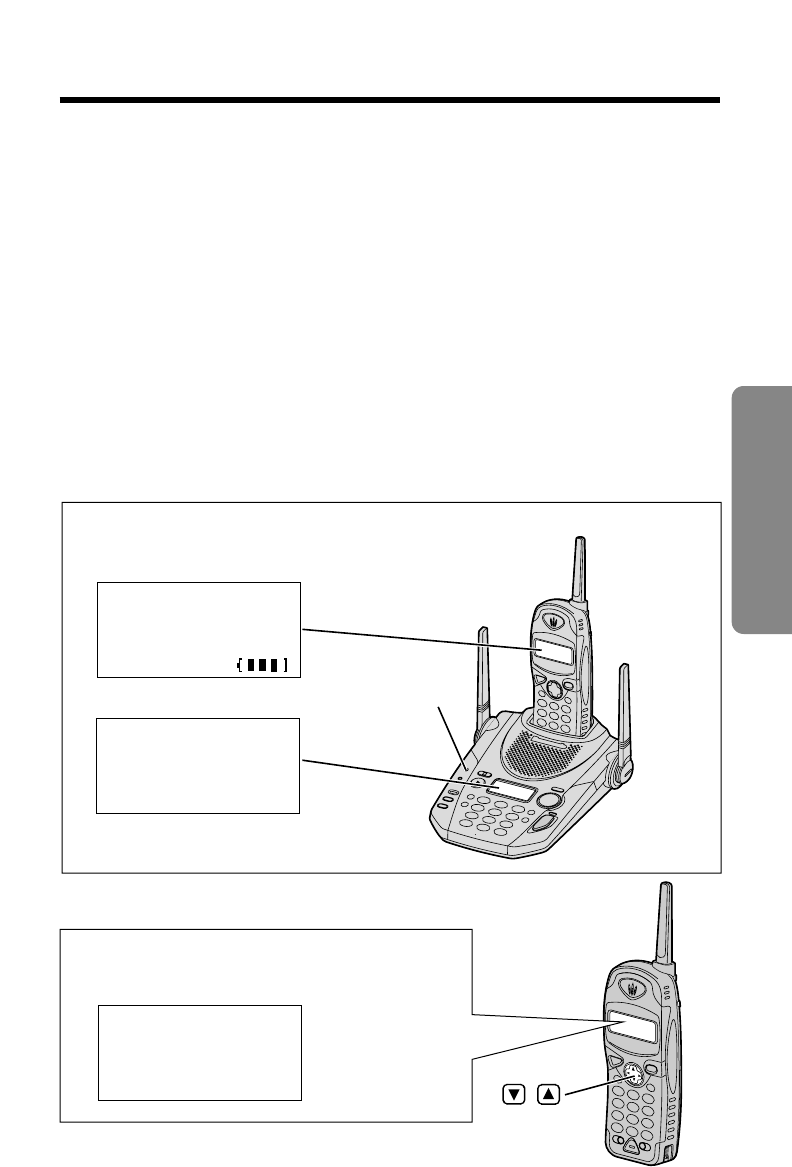
33
Cordless Telephone
,
While the handset is off the base unit:
Press Ñor Öto turn the display on.
To check the number of new calls
When new calls have been received, the CALLER ID indicator flashes
slowly on the base unit. The handset and base unit displays show the
number of new calls.
Ex. You have received 10 new calls.
While the handset is on the base unit:
Handset display
Base unit display
SUN 12:00AM
10 new calls
0 message
10 new calls
GF H
=Directory
CALLLER ID
Indicator
•If “No items stored” is displayed, the Caller List is empty.
10 new calls
•Caller information cannot be displayed in the following cases:
•—If the caller dialed from an area which does not provide a Caller ID service, the
display will show “Out of area”.
•—If the caller has requested not to display his/her information, the display will
show “Private caller”.
•If your unit is connected to a PBX which does not support Caller ID services, you
cannot access those services.
•The name display service may not be available in some areas. For further
information, please contact your telephone company.
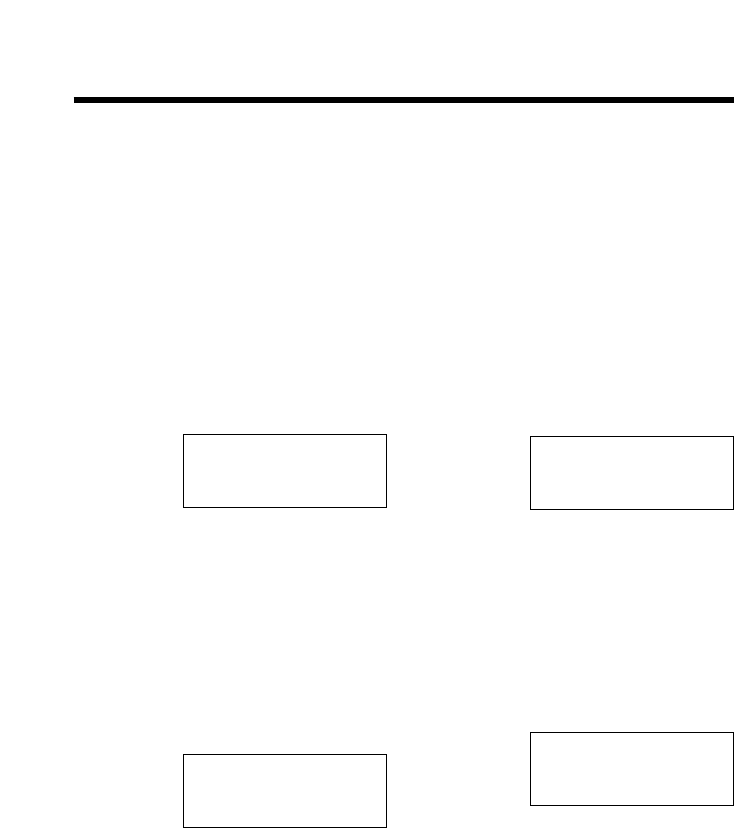
34
With the handset
1Press Öor Ñto enter the
Caller List.
•The display will show, for
example, the following.
•You can go to the directory list
by pressing FWD/EDIT á
(p. 47).
2To search from the most
recent call, press Ö.
To search from the oldest call,
press Ñ.
•To scroll between callers, press
Öor Ñ.
3To exit the list, press
(FUNCTION/EXIT/CH).
•The handset will return to the
standby mode.
Using the Caller List
2 new calls
GF H
=Directory
•If “No items stored” is displayed, the Caller List is empty.
•If there is no name information for a caller, the display will only show the phone
number.
•While you are viewing the Caller List with the handset, another person cannot
access the list using the base unit, and vice versa.
Viewing the Caller List
You can view the caller list with the handset or the base unit. Caller List
information includes the caller’s name and phone number, the time and
date the call was received, and the number of times that caller called.
Make sure the unit is in the standby mode initially.
JACK SMITH
1-222-333-4444
3:10P JUN.10
With the base unit
1Press Öor Ñto enter the
Caller List.
•The display will show, for
example, the following.
•You can go to the directory list
by pressing á(p. 48).
2To search from the most
recent call, press Ö.
To search from the oldest call,
press Ñ.
•To scroll between callers, press
Öor Ñ.
3To exit the list, press
(STOP/EXIT).
•The base unit will return to the
standby mode.
2 new calls
GF H
=Directory
JACK SMITH
1-222-333-4444
3:10P JUN.10
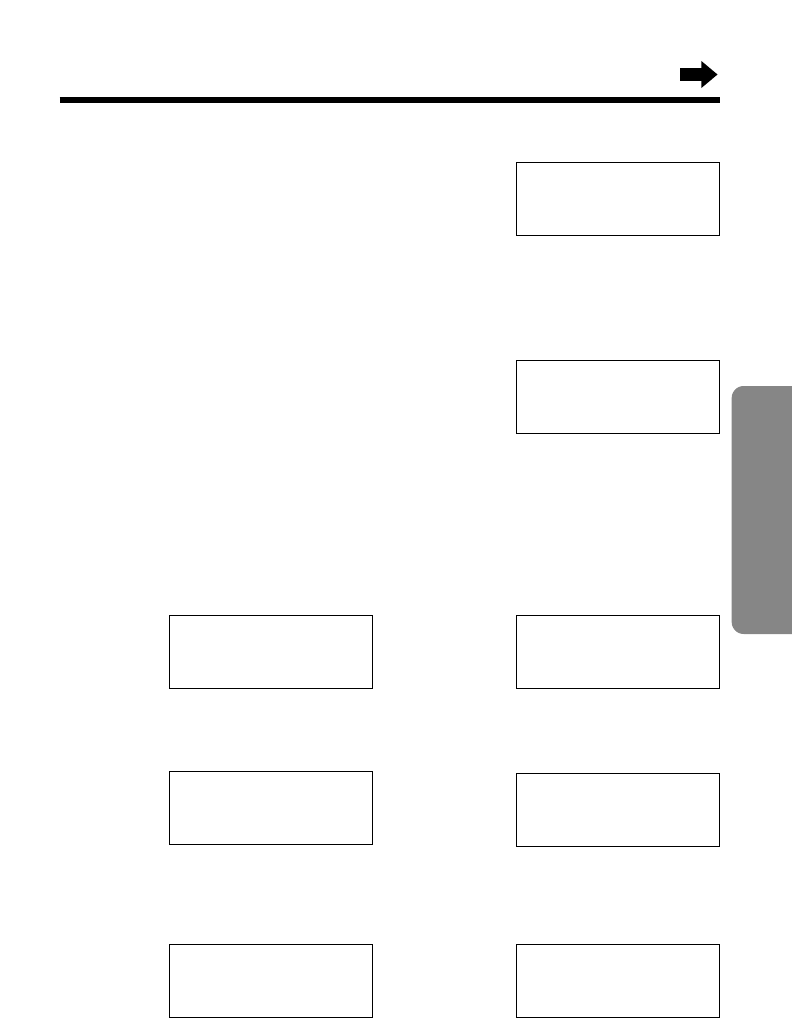
35
Cordless Telephone
With the handset
1Press Öor Ñto enter the
Caller List.
2Press Öor Ñrepeatedly to
find the desired caller.
3Press (TALK).
•The displayed phone number is
dialed automatically.
What “√” means
When the display shows “√”, you have already
viewed this calling information, answered the
call, called back the caller or played back the
message (p. 57). If the same caller calls again,
the call entry with “√” will be replaced with the
new call entry.
If a caller calls more than once
The number of times the same caller called is
displayed (✕2 to ✕9). The date and time of the
most recent call will be recorded. After
checking, ✕2 to ✕9 will be replaced with “√”.
JACK SMITH
1-222-333-4444
3:10P JUN.10 √
JACK SMITH
1-222-333-4444
3:10P JUN.10
✕
3
CINDY TURNER
1-234-456-7890
11:20A JAN.12
✕
3
Talk
12344567890
Calling Back from the Caller List
•In some cases, you may have to edit the number before dialing (p. 36, 37).
(Ex. You may have to delete “1” and the area code.)
•If a phone number is not displayed in the caller information, you cannot call back
that caller.
3 new calls
GF H
=Directory
With the base unit
1Press Öor Ñto enter the
Caller List.
2Press Öor Ñrepeatedly to
find the desired caller.
3Press (DIGITAL!SP-PHONE).
•The displayed phone number is
dialed automatically.
CINDY TURNER
1-234-456-7890
11:20A JAN.12
✕
3
Talk
12344567890
3 new calls
GF H
=Directory
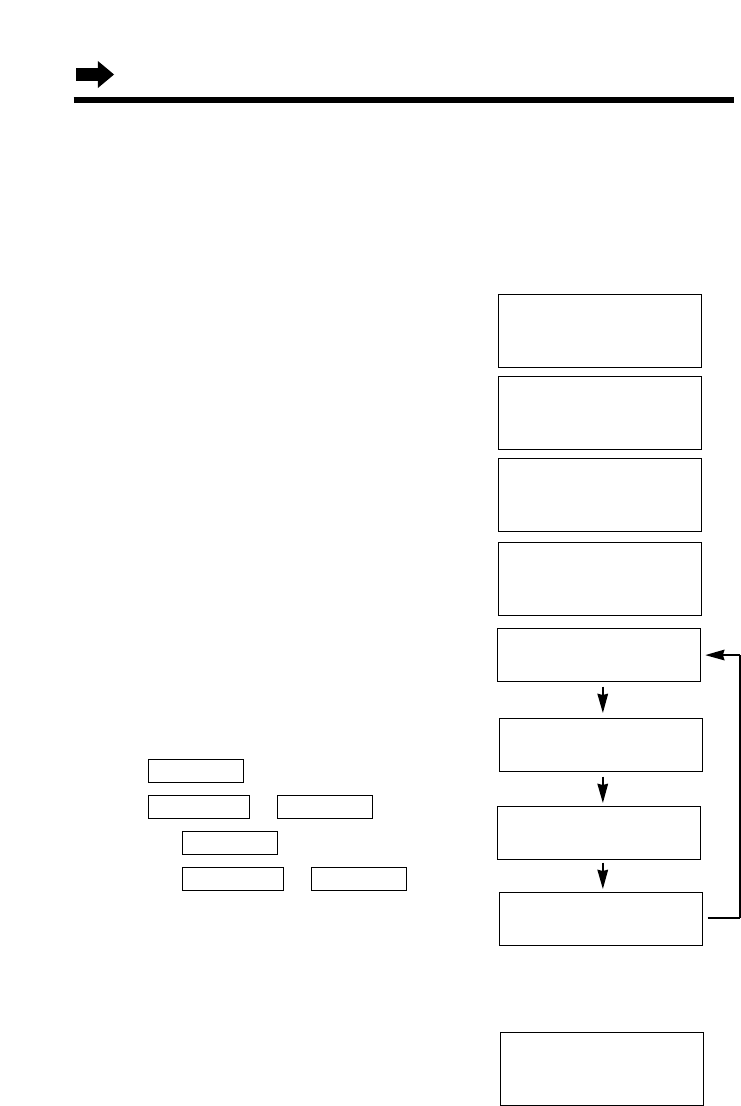
36
Using the Caller List
Editing the Caller’s Phone Number
You can edit a phone number into one of 4 patterns using the handset or
the base unit.
Make sure the unit is in the standby mode initially.
With the handset
1Press Öor Ñto enter the Caller List.
2Press Öor Ñrepeatedly to find the
desired caller, and press FWD/EDIT á.
3While the arrow points to “Edit”,
press FWD/EDIT á(Yes key).
4Press FWD/EDIT á(Edit key) to
select a pattern.
•Each time you press FWD/EDIT á, the
number is rearranged into one of
4 different patterns.
a
b–
c1 –
d1 – –
•The order in which patterns a–dare
displayed depends on how the telephone
number is displayed in step 3.
5After editing the number, you can continue with calling back or
storing procedures. To call back, press (TALK) (p. 35).
To store the number in the directory,
press Ö(Next key), and follow the
instructions on the display (p. 38).
•The number edited in step 4 will not be maintained in the Caller List.
Phone no.
Area code
Phone no.
Phone no.Area code
Phone no.
FRED PARKER
1-234-321-5555
11:20A JAN.12 √
a
H
Edit
Save directory
GF H
=Yes
FRED PARKER
1-234-321-5555
G
=Next
H
=Edit
321-5555
G
=Next
H
=Edit
5 new calls
GF H
=Directory
b234-321-5555
G
=Next
H
=Edit
c1-321-5555
G
=Next
H
=Edit
d1-234-321-5555
G
=Next
H
=Edit
FRED PARKER
321-5555
G
=Edit
H
=Save
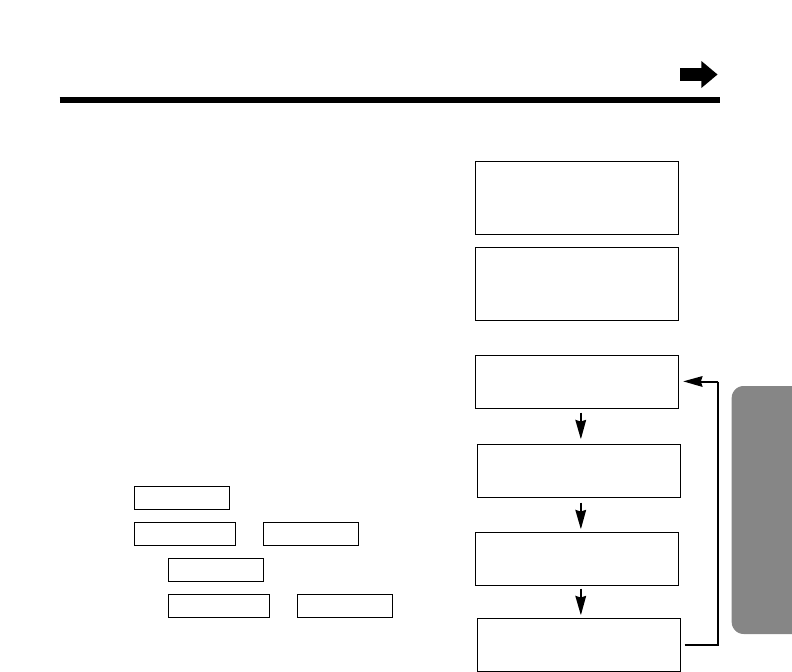
37
Cordless Telephone
With the base unit
1Press Öor Ñto enter the Caller
List.
2Press Öor Ñrepeatedly to find
the desired caller.
3Press (GREETING/EDIT) to select
a pattern.
•Each time you press (GREETING/EDIT),
the number is rearranged into one of
4 different patterns.
a
b–
c1 –
d1 – –
•The order in which patterns a–d
are displayed depends on how the
telephone number is displayed in
step 2.
4After editing the number, you can continue with calling back.
Press (DIGITAL!SP-PHONE) (p. 35).
•The number edited in step 3 will not be maintained in the Caller List.
Phone no.
Area code
Phone no.
Phone no.Area code
Phone no.
FRED PARKER
1-234-321-5555
11:20A JAN.12 √
5 new calls
GF H
=Directory
aFRED PARKER
321-5555
bFRED PARKER
234-321-5555
cFRED PARKER
1-321-5555
dFRED PARKER
1-234-321-5555
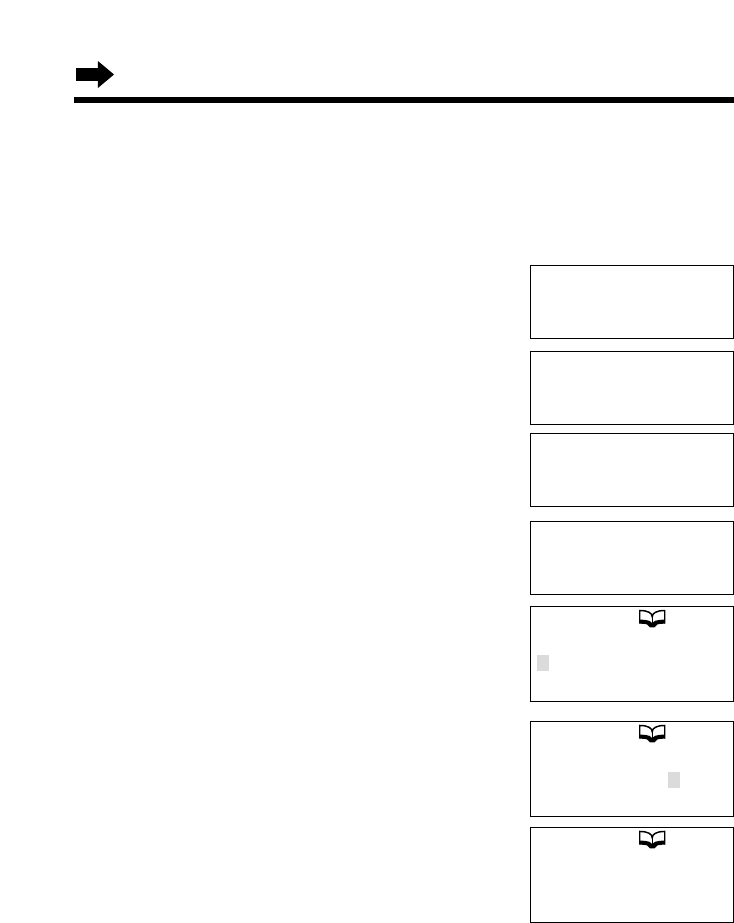
38
Using the Caller List
Storing Caller List Information in the Directory
You can store names and phone numbers that are in the Caller List into
the directory. Storing must be carried out with the handset.
Make sure the unit is in the standby mode initially.
1Press Öor Ñto enter the Caller List.
2Press Öor Ñrepeatedly to find the
caller you want to store in the directory,
and press FWD/EDIT á(Yes key).
•If the number requires editing, see page 36.
3Press Öor Ñto select “Save
directory”, and press FWD/EDIT á
(Yes key).
If there is no name information for the
caller, “Enter name” will be
displayed.
a) If a name is not required, press Ö
(Next key) and press FWD/EDIT á.
b) If a name is required, enter the name
(p. 45). When finished, press Ö
(Next key) and press FWD/EDIT á
(Save key).
•A beep sounds.
•
To continue storing other items, repeat from
step 2.
•To return to the standby mode, press
(FUNCTION/EXIT/CH).
•You can exit the programming mode any time by pressing (FUNCTION/EXIT/CH).
•If the display shows “Directory full” in step 3, press (FUNCTION/EXIT/CH)
to exit the list. To erase other stored items from the directory, see page 51.
•You cannot store caller information in the directory if a phone number is not
displayed.
•If 3 beeps sound and the display shows “Save error”, move closer to the base
unit and start again from step 1.
CINDY TURNER
1-234-456-7890
11:20A JAN.12
✕
3
10 new calls
GF H
=Directory
H
Edit
Save directory
GF H
=Yes
Edit
H
Save directory
GF H
=Yes
Enter name
IH G
=Next
Enter name
CINDY TURNER
IH G
=Next
CINDY TURNER
1234567890
F
=Edit
H
=Save
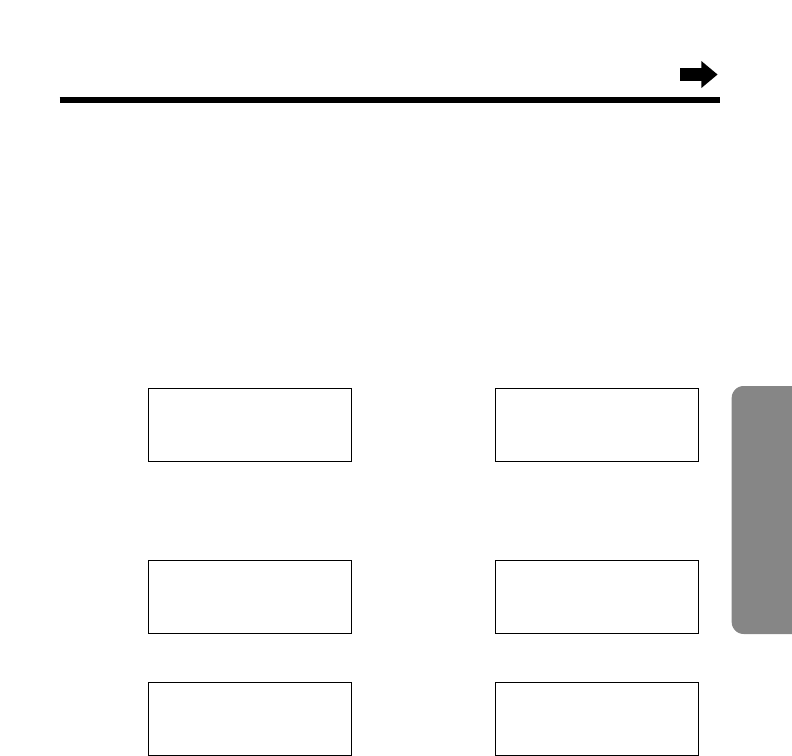
39
Cordless Telephone
With the handset:
1Press Öor Ñto enter the
Caller List.
2Press Öor Ñrepeatedly to
find the caller you want to
erase from the Caller List.
3Press (INTERCOM/CLEAR).
•A beep sounds and the
information is erased.
•To erase other items, repeat
from step 2.
•To return to the standby mode,
press (FUNCTION/EXIT/CH).
Erasing Caller List Information
After checking the Caller List, you can erase some or all of the entries
with the handset or the base unit.
Make sure the unit is in the standby mode initially.
To erase a specific caller from the Caller List
TOM REAGAN
1-888-777-6666
12:20A JAN.12 √
Clear
10 new calls
GF H
=Directory
With the base unit:
1Press Öor Ñto enter the
Caller List.
2Press Öor Ñrepeatedly to
find the caller you want to
erase from the Caller List.
3Press (ERASE).
•A beep sounds and the
information is erased.
•To erase other items, repeat
from step 2.
•To return to the standby mode,
press (STOP/EXIT).
TOM REAGAN
1-888-777-6666
12:20A JAN.12 √
Clear
10 new calls
GF H
=Directory
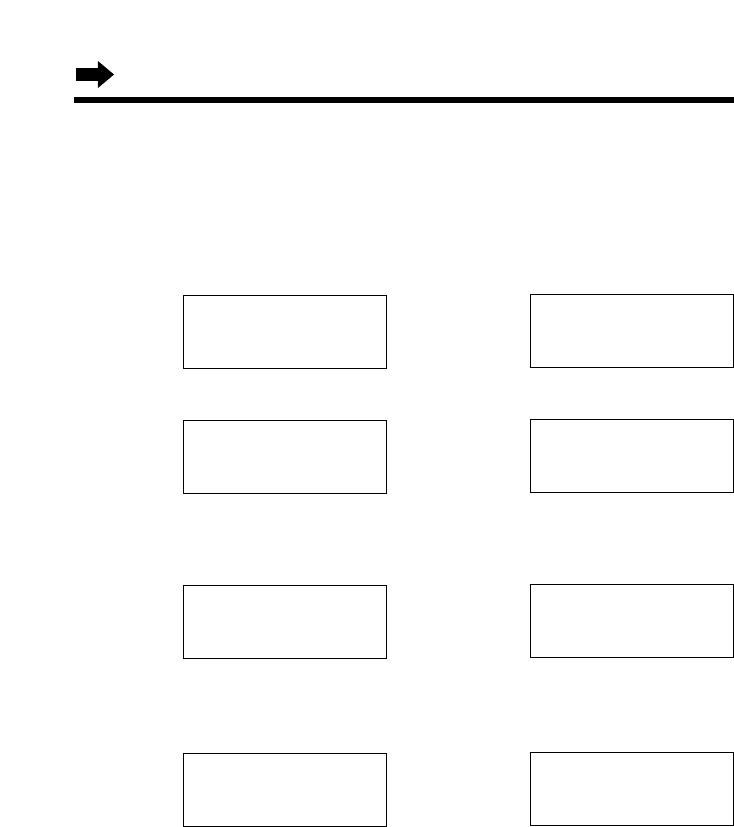
40
With the handset:
1Press Öor Ñto enter the
Caller List.
2Press (INTERCOM/CLEAR).
3Press Öor Ñto select “All
clear”.
4Press FWD/EDIT á(Yes key)
or (INTERCOM/CLEAR).
•A beep sounds and all entries
are erased.
Exit
H
All clear
GF H
=Yes
All clear
0 new call
GF H
=Directory
H
Exit
All clear
GF H
=Yes
To erase all entries in the Caller List
Before erasing all entries, make sure that “0 new call” is displayed.
With the base unit:
1Press Öor Ñto enter the
Caller List.
2Press (ERASE).
3Press Öor Ñto select “All
clear”.
4Press á(Yes key) or
(ERASE).
•A beep sounds and all entries
are erased.
Exit
H
All clear
GF H
=Yes
All clear
0 new call
GF H
=Directory
H
Exit
All clear
GF H
=Yes
Using the Caller List
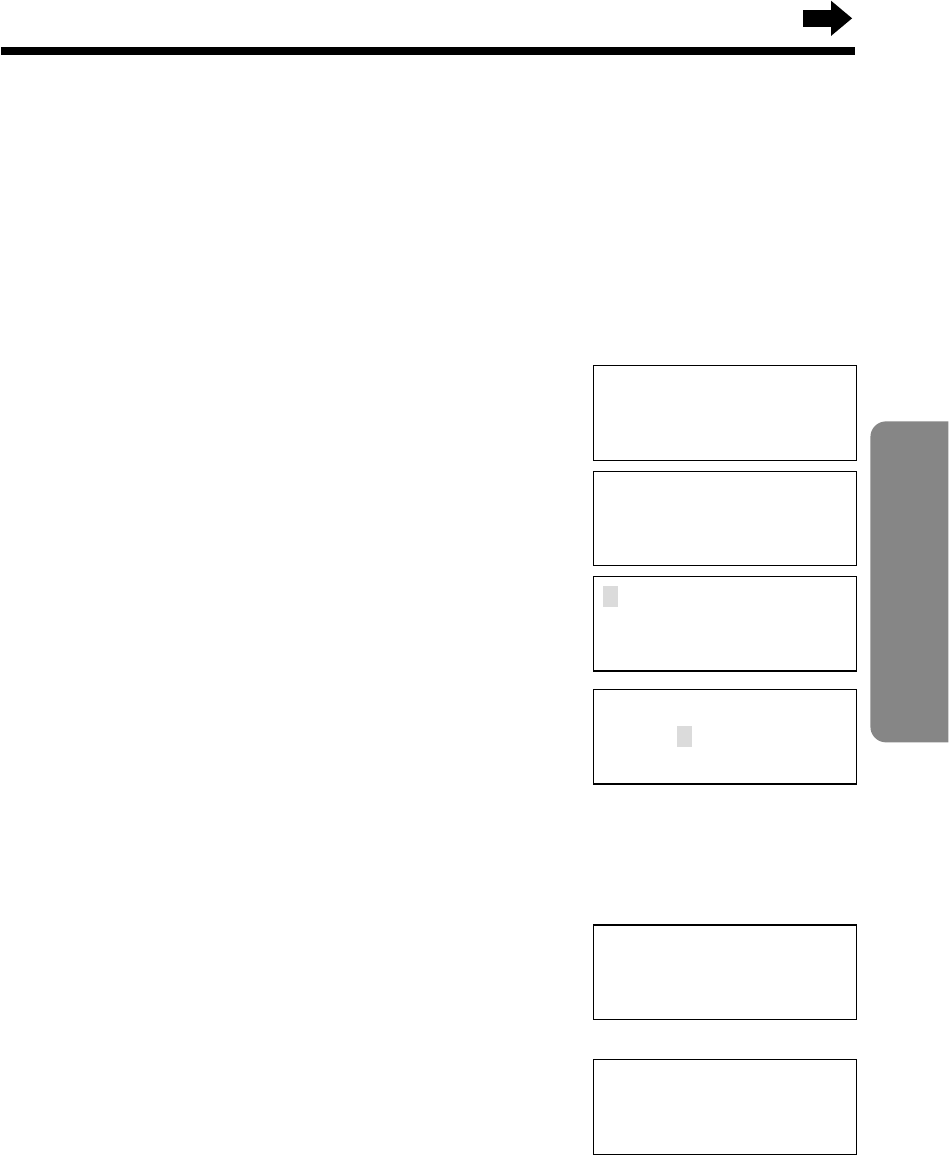
One-Touch Dialer
41
Cordless Telephone
You can store a phone number in the (DIRECT) button of the handset. The
stored number is dialed with a one-touch operation.
Storing a Phone Number in the DIRECT Button
Make sure the unit is in the standby mode initially.
1Press (FUNCTION/EXIT/CH).
2Press Öor Ñrepeatedly until the arrow
points to “Program”.
3Press FWD/EDIT á(Yes key).
4While the arrow points to “Save
DIRECT#”, press FWD/EDIT á(Yes key).
5Enter a phone number, up to 48 digits.
•Each time you press (INTERCOM/CLEAR) the
digit to the left of the cursor is erased. To erase
all digits, press and hold (INTERCOM/CLEAR).
•The last 32 digits number you entered will be
displayed. To confirm the remaining number, press
BACK Üor FWD/EDIT á.
6Press Ö(Next key).
•If you want to edit the entered number, press
Ñ(Edit key) and return to step 5.
7Press FWD/EDIT á(Save key).
•A beep sounds.
•To return to the standby mode, press
(FUNCTION/EXIT/CH).
•You can exit the programming mode any time by pressing (FUNCTION/EXIT/CH).
•If a pause is required for dialing, (REDIAL/PAUSE) can be stored in a phone
number in step 5. This counts as one digit (p. 54).
IH G
=Next
1234567890123456
7890123456789012
F
=Edit
H
=Save
1234567890123456
7890123456789012
Save DIRECT#
H
Program
Calling pager
GF H
=Yes
H
Save DIRECT#
Set flash time
GF H
=Yes
1234567890123456
7890123456789012
IH G
=Next
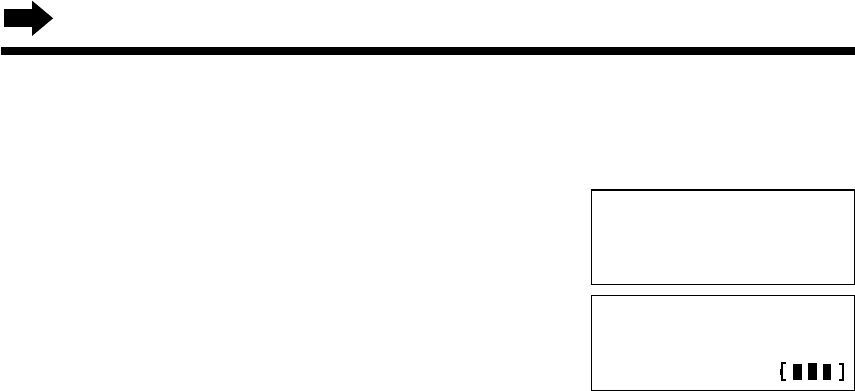
42
Dialing the Stored Number in the DIRECT
Button
1Press (DIRECT).
•The stored number is dialed automatically.
2To hang up, press (TALK) or place the
handset on the base unit.
•You can also dial the stored number by pressing (TALK) then pressing
(DIRECT).
Talk Direct
D
Talk
00-00-00
One Touch Dialer
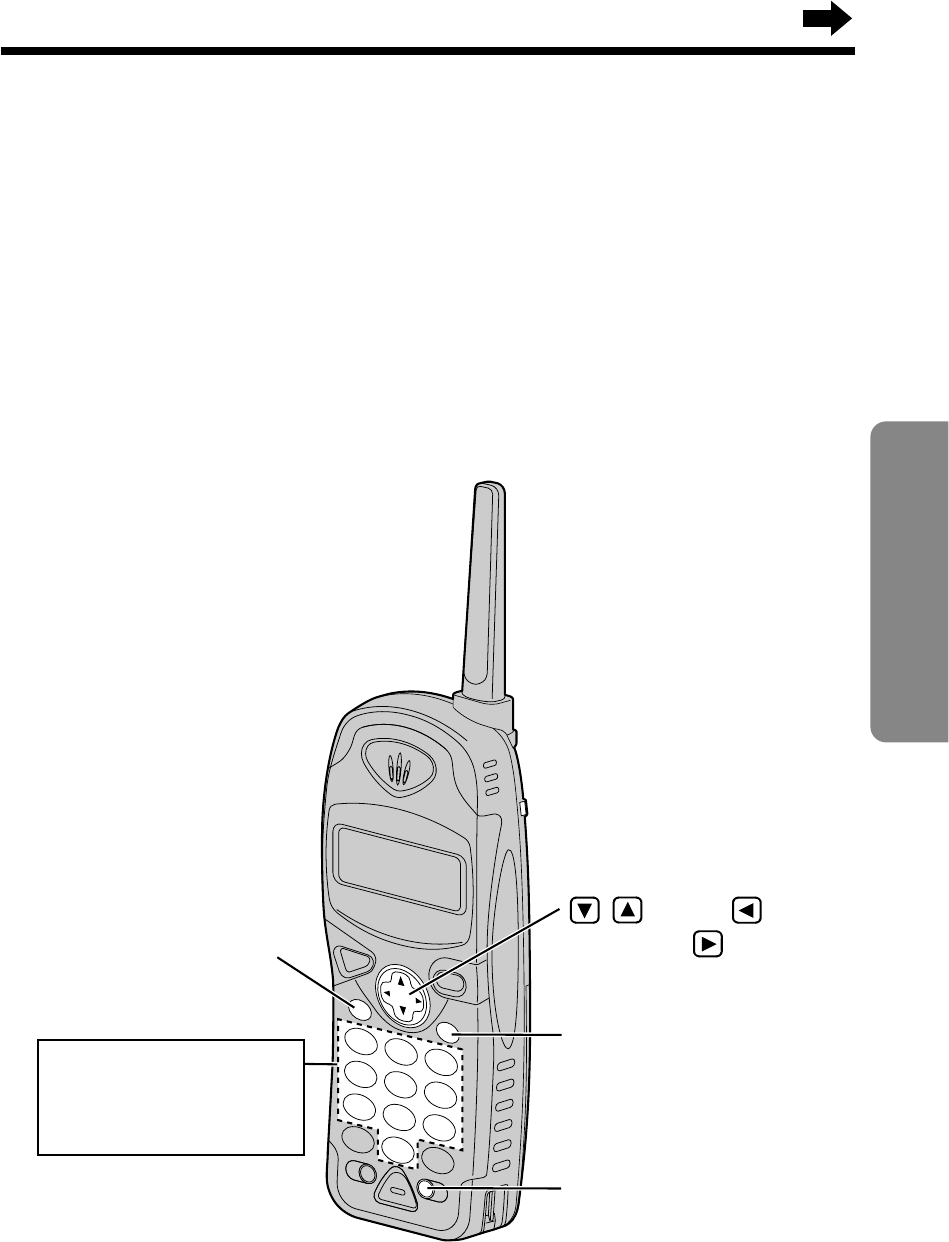
43
Cordless Telephone
You can store up to 50 names and phone numbers in the directory using
the handset. All directory items are sorted by the first word in alphabetical
order. Using the directory, you can make a call by selecting a name on
the handset or base unit display.
Using the Directory
Storing Names and Numbers in the
Directory
Storing must be carried out with the handset.
Make sure the unit is in the standby mode initially.
(Continued \)
(INTERCOM/CLEAR)
(REDIAL/PAUSE)
, , BACK ,
FWD/EDIT
(FUNCTION/EXIT/CH)
The dialing buttons can
be used to enter letters
and symbols.
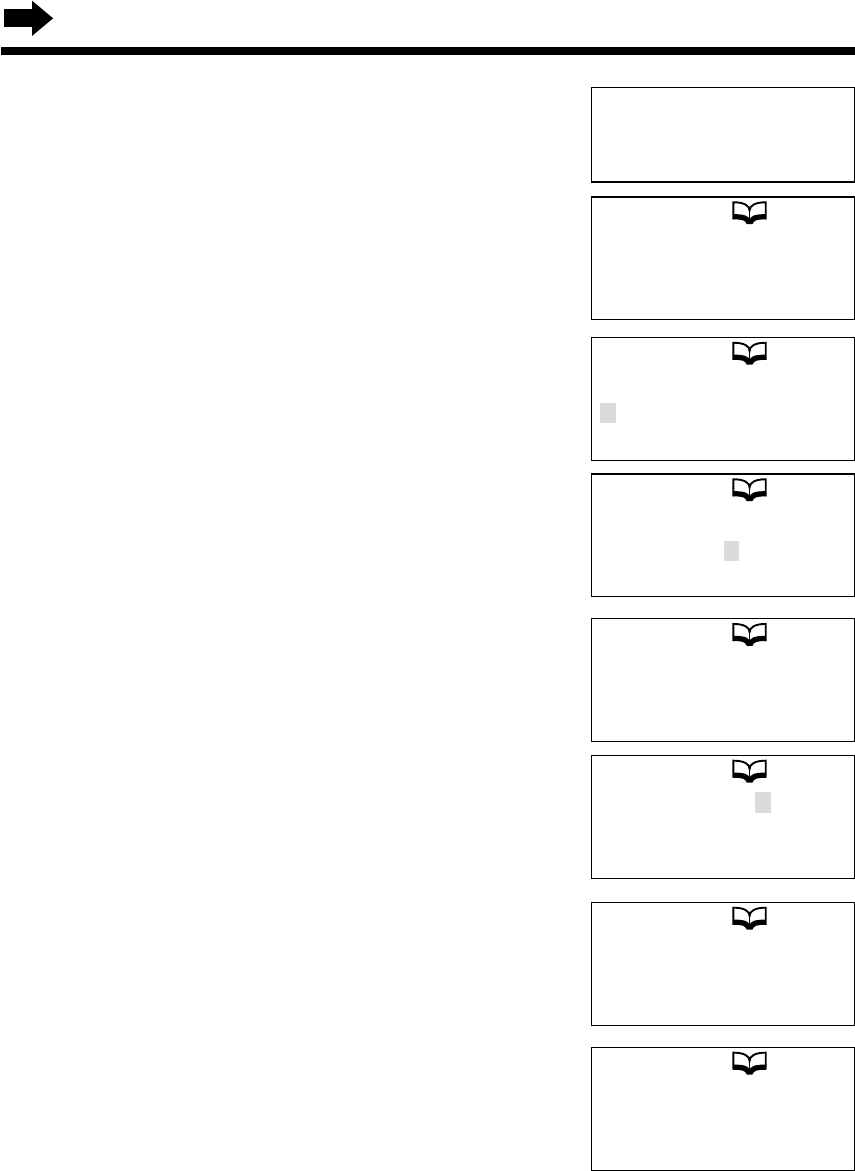
44
Tom Jones
0987654321
F
=Edit
H
=Save
Tom Jones
0987654321
Using the Directory
1Press (FUNCTION/EXIT/CH).
2While the arrow points to “Save
directory”, press FWD/EDIT á(Yes key).
•The display shows the number of stored items
in the directory.
3Enter a name, up to 15 characters using
the dialing buttons (p. 45).
•To move the cursor, press BACK Üor
FWD/EDIT á.
•If a name is not required, press Ö(Next key)
and go to step 5.
4Press Ö(Next key).
5Enter a phone number, up to 22 digits.
•If you misdial, press (INTERCOM/CLEAR).
Digits are erased from the right. To erase all
digits, press and hold (INTERCOM/CLEAR).
6Press Ö(Next key).
•If you want to change the storing name or
number, press Ñ(Edit key) repeatedly to
reach the desired display and change it.
7Press FWD/EDIT á(Save key).
•A beep sounds.
•
To continue storing other items, repeat from step 2.
•To return to the standby mode, press
(FUNCTION/EXIT/CH).
•If a pause is required for dialing, (REDIAL/PAUSE) can be stored in a phone
number in step 5. This counts as one digit (p. 54).
•You can exit the programming mode any time by pressing (FUNCTION/EXIT/CH).
•If the display shows “Directory full” in step 2, press (FUNCTION/EXIT/CH).
To erase other stored items from the directory, see page 51.
•
After the maximum of 50 items has been stored, “Directory full” is also displayed.
•If 3 beeps sound and the display shows “Save error”, move closer to the base
unit and start again from step 1.
H
Save directory
Ringer volume
GF H
=Yes
Directory=
20 items
Enter name
IH G
=Next
Enter name
Tom Jones
IH G
=Next
Enter phone no.
0987654321
IH G
=Next
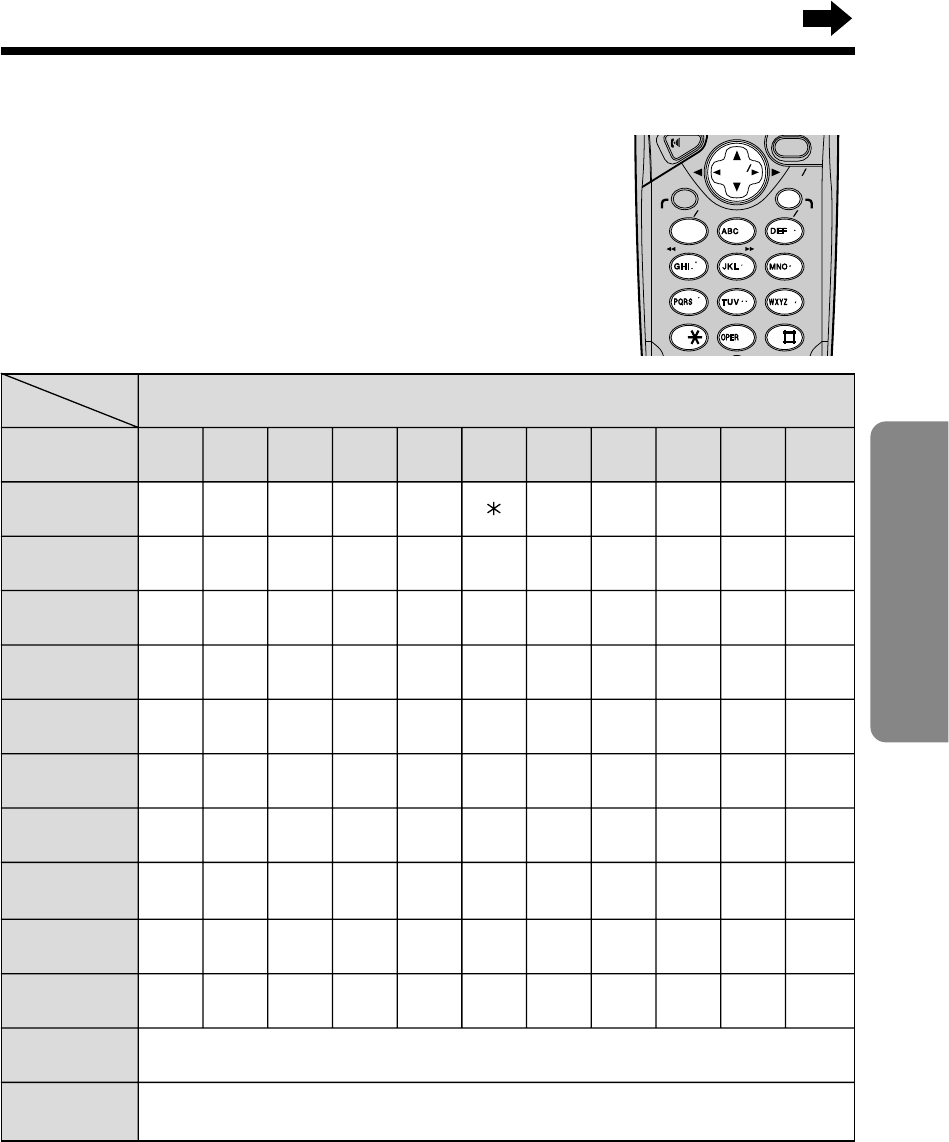
45
Cordless Telephone
#&’ () ,–./1
ABCabc2
DEFdef3
GHIghi4
JKLjkl5
MNOmno6
PQRSp q r s 7
TUVtuv8
WXYZwxyz9
0Blank
To move the cursor to the left
To move the cursor to the right
(1)
(2)
(3)
(4)
(5)
(6)
(7)
(8)
(9)
(0)
BACK
Ü
FWD/EDIT
á
1234567891011
Number of times key is pressed
Selecting Characters to Enter Names
The handset dialing buttons ((0) to (9)) can be
used to enter letters and symbols. The letters
are printed on the dialing buttons.
Pressing each button selects a character as
shown below.
Keys
•To enter another character using the same dialing button, press FWD/EDIT á
to move the cursor to the next space.
If you make a mistake while entering a name
Use BACK Üor FWD/EDIT áto move the cursor to the incorrect
character, press (INTERCOM/CLEAR) to delete and enter the correct
character. Each time you press (INTERCOM/CLEAR), a character is erased
from the right. To erase all characters, press and hold
(INTERCOM/CLEAR).
CH
CH
TALK
BACK
FWD EDIT
EDIT
FUNCTION EXIT
FUNCTION EXIT
INT
INT
ERCOM
ERCOM
CLEAR
CLEAR
DIRECT
TONE
TONE
STOP
PAGER
ALL
L
MSG
ANS
S
ON
SKIP
KIP
NEW
W
MSG
REPE
PE
AT
LOUD
LOUD
SE
SE
ARC
RC
H
1
2
3
4
5
6
78
9
0
FLASH
REDIAL
CALL WAIT
ANS
OFFOFF
PAUSE
PLAYBACK
ON
OFF
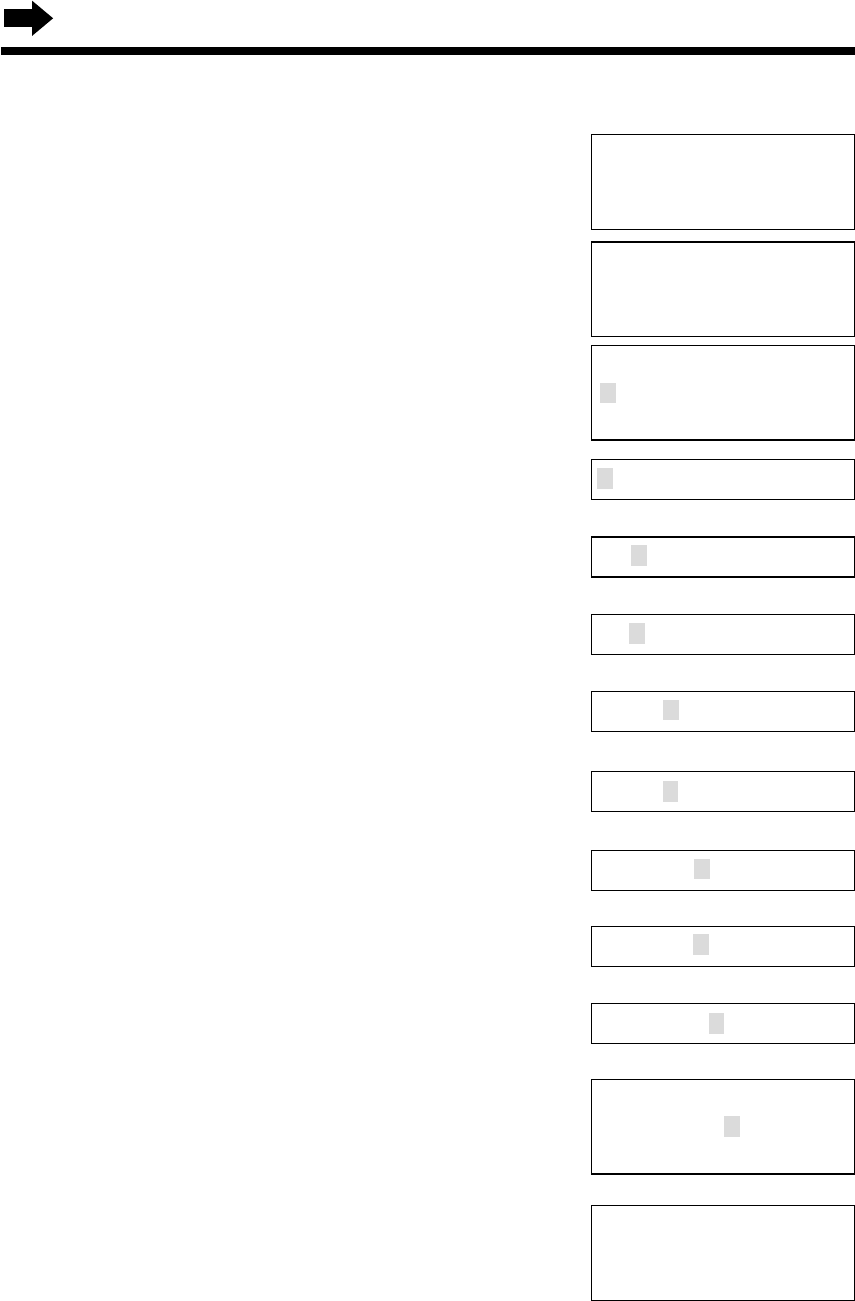
46
For example, to enter “Tom Jones”:
1Press (FUNCTION/EXIT/CH).
2While the arrow points to “Save
directory”, press FWD/EDIT á
(Yes key).
3Press (8).
4Press (6) six times, then press FWD/EDIT
áto move the cursor to the right.
5Press (6) four times.
6Press FWD/EDIT átwice to enter a blank.
7Press (5).
8Press (6) six times, then press FWD/EDIT
áto move the cursor to the right.
9Press (6) five times.
10Press (3) five times.
11Press (7) eight times.
12When finished, press Ö(Next key).
•To enter a phone number and continue
storing, see page 44, from step 5.
Enter name
Tom Jones
IH G
=Next
T
To
Tom
Tom
Tom J
Tom Jo
Tom Jon
Tom Jone
Directory=
20 items
Enter name
IH G
=Next
Enter phone no.
H
Save directory
Ringer volume
GF H
=Yes
Using the Directory
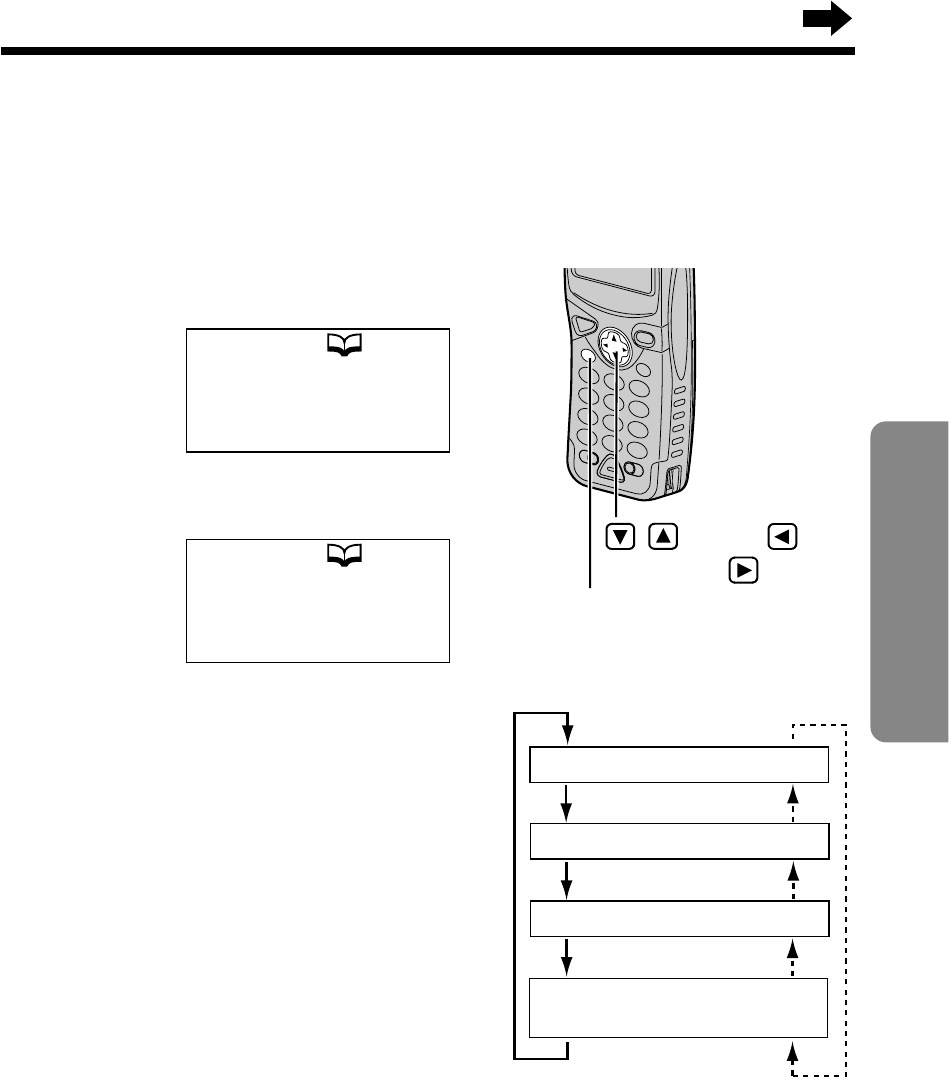
47
Cordless Telephone
Finding Items in the Directory
You can search the directory using the handset or the base unit.
Make sure the unit is in the standby mode initially.
With the handset
1Press BACK Üor FWD/EDIT áto
enter the directory list.
2Press Öor Ñ.
•The first item is displayed.
3Press Öor Ñrepeatedly until the
desired item is displayed.
.
•All directory items are stored in the
order shown on the right.
To search for a name by initial
#Press the dialing button for the
first letter of the desired name
until any name with the same
initial is displayed (see the
Index table on page 49).
Ex. To find “Frank”, press (3)
repeatedly until the first item
under “F” is displayed.
$Press Örepeatedly until the
name is displayed.
Alphabet letter
Symbol
Telephone number
Number
(If no name is stored)
Press Ö.Press Ñ.
Directory list
GF
H
=Caller’s list
Ann
1234567890
•You can leave the directory list any time by pressing (FUNCTION/EXIT/CH).
•If “No items stored” is displayed in step 2, the directory is empty.
•In step 1, you can go to the Caller List by pressing FWD/EDIT á(p. 34).
•If you are viewing the directory with the handset, another person cannot access
the directory using the base unit.
, , BACK ,
FWD/EDIT
(FUNCTION/EXIT/CH)
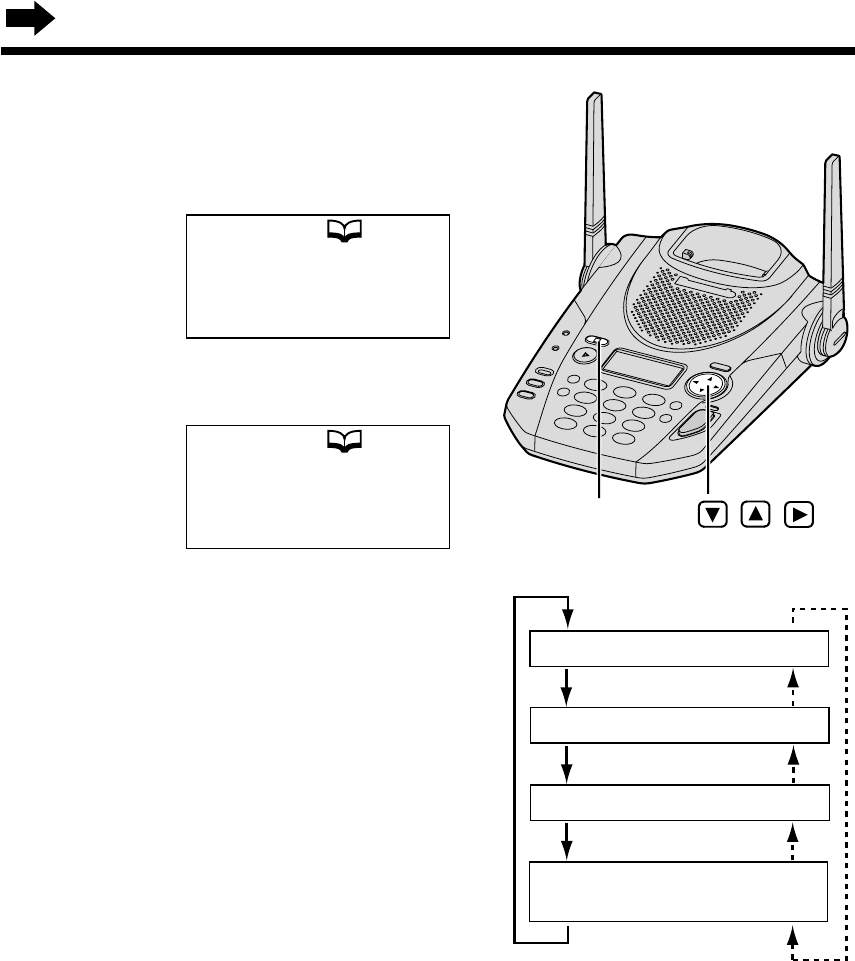
48
Using the Directory
With the base unit
1Press Üor áto
enter the directory list.
2Press Öor Ñ.
•The first item is displayed.
3Press Öor Ñrepeatedly until the
desired item is displayed.
.
•All directory items are stored in the
order shown on the right.
To search for a name by initial
#Press the dialing button for the
first letter of the desired name
until any name with the same
initial is displayed (see the
Index table on page 49).
Ex. To find “Frank”, press (3)
repeatedly until the first item
under “F” is displayed.
$Press Örepeatedly until the
name is displayed.
Alphabet letter
Symbol
Telephone number
Number
(If no name is stored)
Press Ö.Press Ñ.
Directory list
GF
H
=Caller’s list
Ann
1234567890
•You can leave the directory list any time by pressing (STOP/EXIT).
•If “No items stored” is displayed in step 2, the directory is empty.
•In step 1, you can go to the Caller List by pressing á(p. 34).
•If you are viewing the directory with the base unit, another person cannot access
the directory using the handset.
, ,
(SYOP/EXIT)
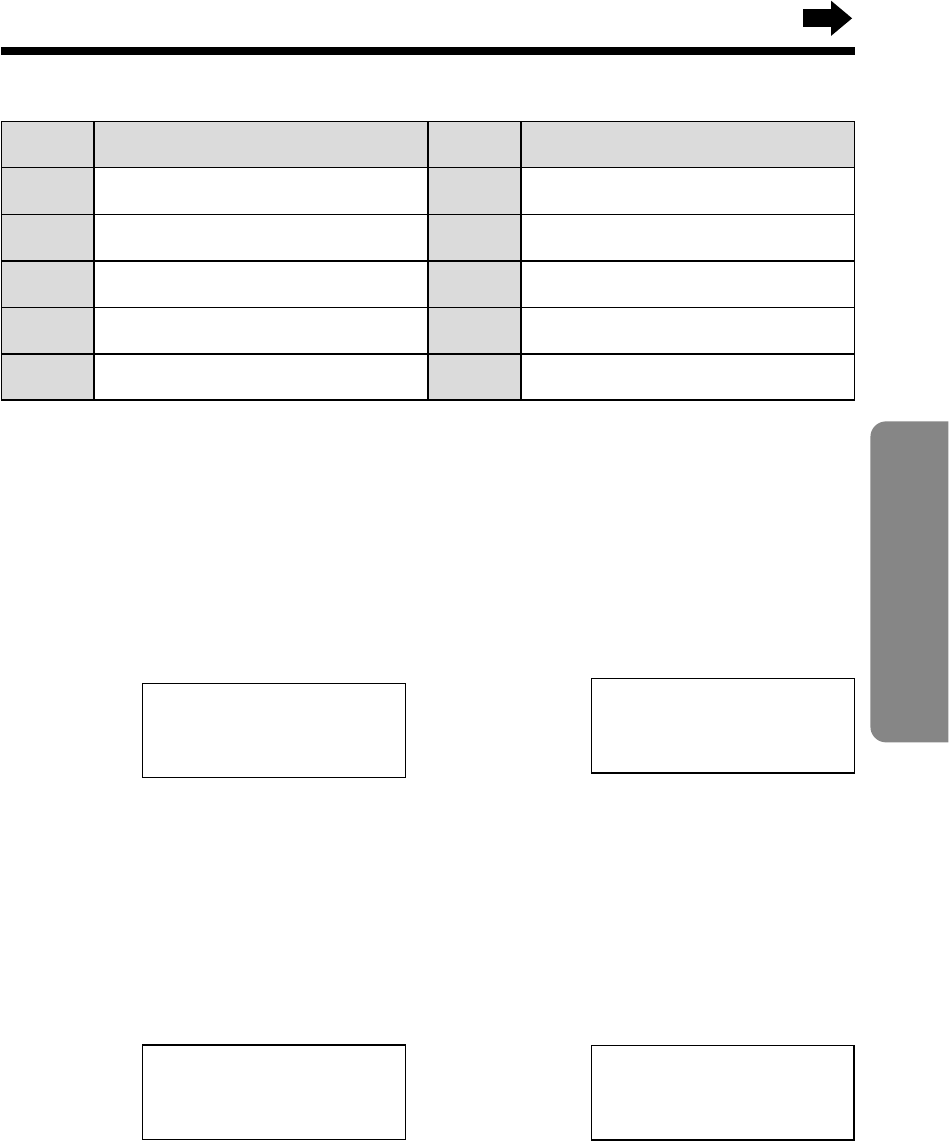
49
Cordless Telephone
1Press BACK Üor FWD/EDIT
áto enter the directory list.
2Press Öor Ñ.
•The first item is displayed.
3Press Öor Ñrepeatedly to
find the directory item that
you want to dial.
•To search for the item by initial,
see page 47.
•To exit the directory, press
(FUNCTION/EXIT/CH).
4Press (TALK).
•The number is dialed
automatically.
Other symbols, 1
A, B, C, 2
D, E, F, 3
G, H, I, 4
J, K, L, 5
Directory list
GF
H
=Caller’s list
Dialing from the Directory
Make sure the unit is in the standby mode initially.
With the handset With the base unit
1Press Üor áto enter the
directory list.
2Press Öor Ñ.
•The first item is displayed.
3Press Öor Ñrepeatedly to
find the directory item that
you want to dial.
•To search for the item by initial,
see page 48.
•To exit the directory, press or
(STOP/EXIT).
4Press (DIGITAL!SP-PHONE).
•The number is dialed
automatically.
(1)
(2)
(3)
(4)
(5)
(6)
(7)
(8)
(9)
(0)
IndexKeys IndexKeys
M, N, O, 6
P, Q, R, S, 7
T, U, V, 8
W, X, Y, Z, 9
0
Index table
Directory list
GF
H
=Caller’s list
Frank
4567890 Frank
4567890
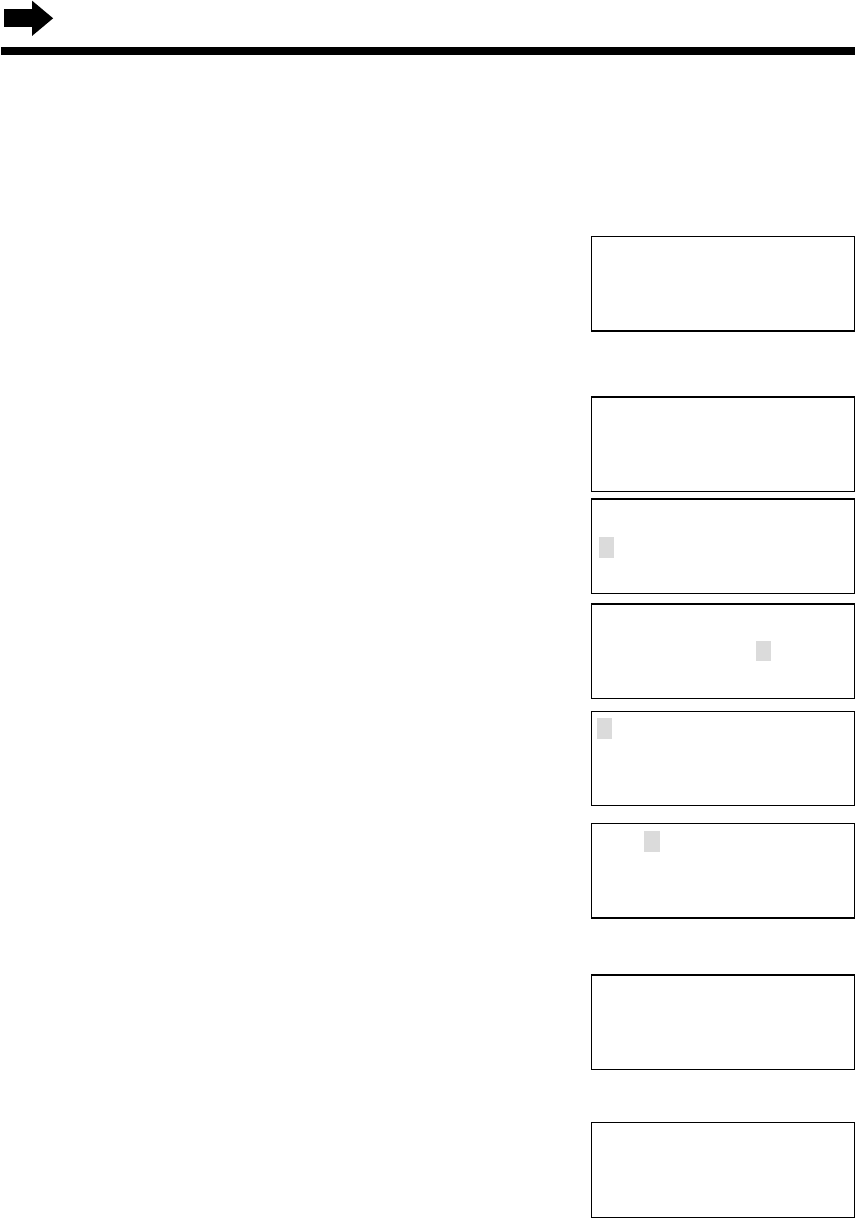
50
Jane Walker
0981234567
F
=Edit
H
=Save
Jane Walker
0981234567
Using the Directory
Editing an Item in the Directory
Programming must be carried out with the handset.
Make sure the unit is in the standby mode initially.
1Press BACK Üor FWD/EDIT áto enter
the directory list.
2Press Öor Ñ.
•The first item is displayed.
3Press Öor Ñrepeatedly to find the
directory item you want to change, and
press FWD/EDIT á.
•To search for the item by initial, see page 47.
•If you do not need to change the name, go to
step 5.
4Edit the name using the dialing buttons,
BACK Üor FWD/EDIT á(p. 45), up to 15
characters.
5Press Ö(Next key).
•If you do not need to change the number, go to
step 7.
6Add a number to the current number.
•Pressing (INTERCOM/CLEAR) erases the digit
to the left of the cursor. To erase all digits,
press and hold (INTERCOM/CLEAR).
7Press Ö(Next key).
•If you want to change the storing name or
number, press Ñ(Edit key) repeatedly to
reach the desired display and change it.
8Press FWD/EDIT á(Save key).
•A beep sounds.
•To continue editing other items, repeat from
step 3.
•To return to the standby mode, press
(FUNCTION/EXIT/CH).
•You can exit the programming mode any time by pressing (FUNCTION/EXIT/CH).
Jane
1234567
Enter name
Jane Walker
IH G
=Next
1234567
IH G
=Next
0981234567
IH G
=Next
Enter name
Jane
IH G
=Next
Directory list
GF
H
=Caller’s list
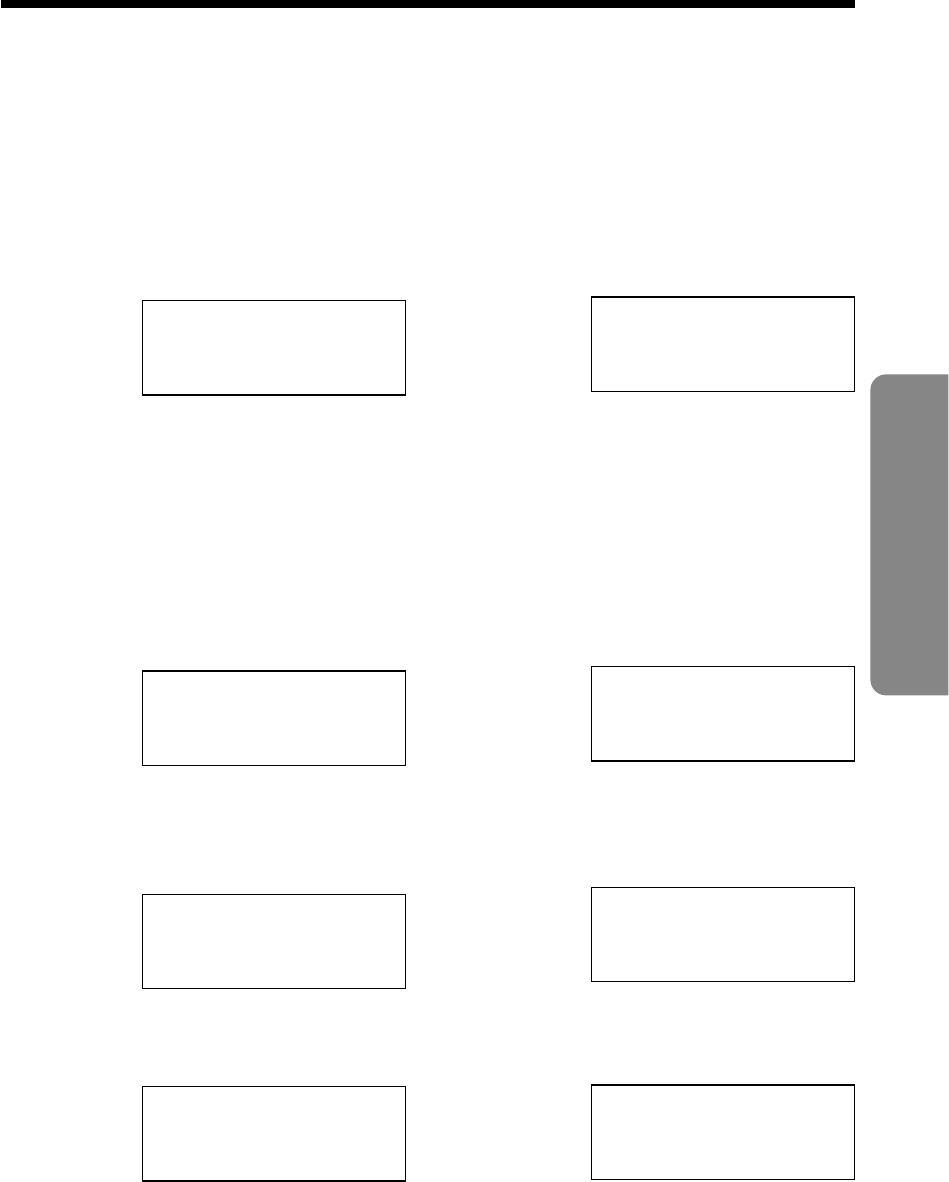
51
Cordless Telephone
Erasing an Item from the Directory
You can erase an item using the handset or the base unit.
Make sure the unit is in the standby mode initially.
With the handset
1Press BACK Üor FWD/EDIT
áto enter the directory list.
2Press Öor Ñ.
•The first item is displayed.
3Press Öor Ñrepeatedly to
find the directory item you
want to erase.
•To search for the item by initial,
see page 47.
4Press (INTERCOM/CLEAR).
•To stop erasing, press BACK
Ü(No key).
5Press FWD/EDIT á(Yes key)
or (INTERCOM/CLEAR).
•A beep sounds and the item is
erased.
•To erase other items, repeat
from step 3.
•To return to the standby mode,
press (FUNCTION/EXIT/CH).
Helen
1234567890
Clear?
I
=No
H
=Yes
Clear
Directory list
GF
H
=Caller’s list
With the base unit
1Press Üor áto enter the
directory list.
2Press Öor Ñ.
•The first item is displayed.
3Press Öor Ñrepeatedly to
find the directory item you
want to erase.
•To search for the item by initial,
see page 48.
4Press (ERASE).
•To stop erasing, press Ü(No
key).
5Press á(Yes key) or
(ERASE).
•A beep sounds and the item is
erased.
•To erase other items, repeat
from step 3.
•To return to the standby mode,
press (STOP/EXIT).
Helen
1234567890
Clear?
I
=No
H
=Yes
Clear
Directory list
GF
H
=Caller’s list
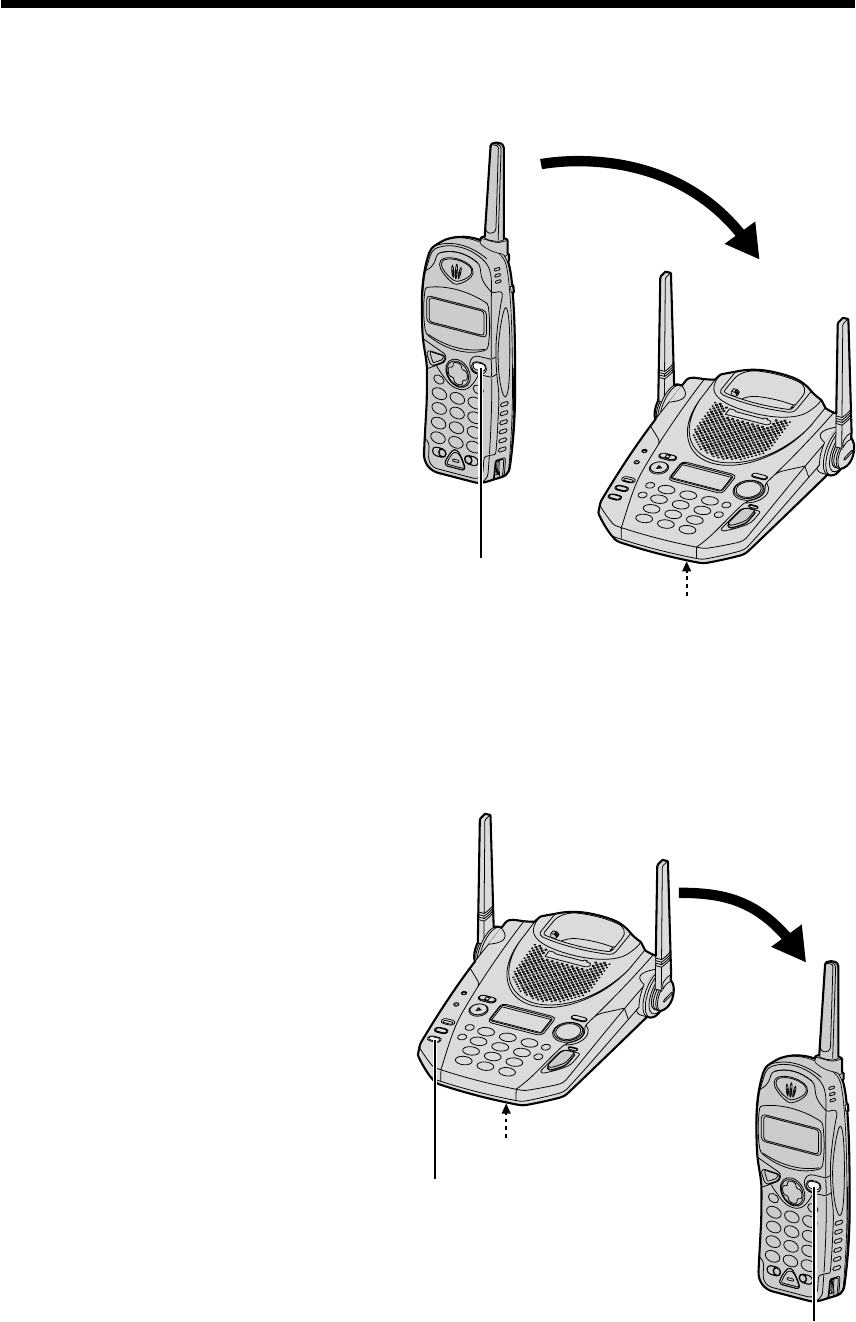
52
Intercom
A 2-way intercom is possible between the handset and the base unit.
Paging the base unit from the handset
1Handset:
Press (INTERCOM/CLEAR). Talk
to the paged party after the
beeps.
•“Intercom” is displayed.
2Base unit:
When the other party’s voice is
heard, answer using the MIC.
3Handset:
To end the intercom, press
(INTERCOM/CLEAR).
Paging the handset from the base unit (Handset locator)
Using this feature, you can locate a misplaced handset.
1Base unit:
Press (LOCATOR/INTERCOM).
•“Paging” is displayed on the
base unit.
•The handset beeps for 1 minute
and “Paging Press
INTERCOM” is displayed.
•To stop paging, press
(LOCATOR/INTERCOM) again.
2Handset:
Press (INTERCOM/CLEAR) to
answer.
•“Intercom” is displayed.
3Base unit:
Talk into the MIC.
4Handset:
To end the intercom, press
(INTERCOM/CLEAR).
(INTERCOM/CLEAR)
MIC
(INTERCOM/CLEAR)
(LOCATOR/INTERCOM)
MIC
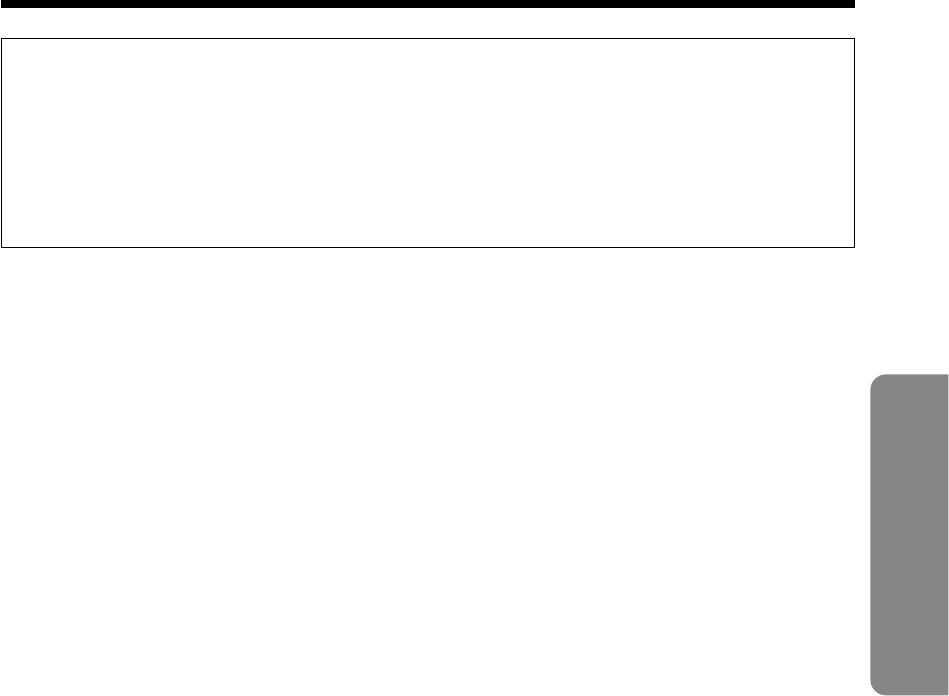
53
Cordless Telephone
During an intercom call:
•Intercom calls can only be ended with the handset.
•If the handset user has difficulty hearing the base unit user, decrease the
base unit speaker volume by pressing Öon the base unit.
•If an incoming call is received, the intercom call stops and the unit starts to
ring. To answer, press (TALK) or (DIGITAL!SP-PHONE).
Transferring a Call Using the Intercom
The intercom can be used during a call. This feature enables you to
transfer a call between the handset and the base unit.
From the handset to the
base unit
1Handset:
During a call, press
(INTERCOM/CLEAR). Talk to
the paged party after the
beeps.
•The call is put on hold and
“Intercom hold” is displayed.
•If the base unit user does not
answer, press (TALK).
2Base unit:
When the paging party’s
voice is heard, answer using
the MIC.
3Base unit:
To answer the call, press
(DIGITAL!SP-PHONE).
•The transfer is complete.
From the base unit to the
handset
1Base unit:
During a call, press
(LOCATOR/INTERCOM).
•The call is put on hold and
“Paging” is displayed.
•If the handset user does not
answer, press
(DIGITAL!SP-PHONE).
2Handset:
Press (INTERCOM/CLEAR) to
answer the page.
•“Intercom hold” is displayed.
3Handset:
To answer the call, press
(TALK).
•The transfer is complete.
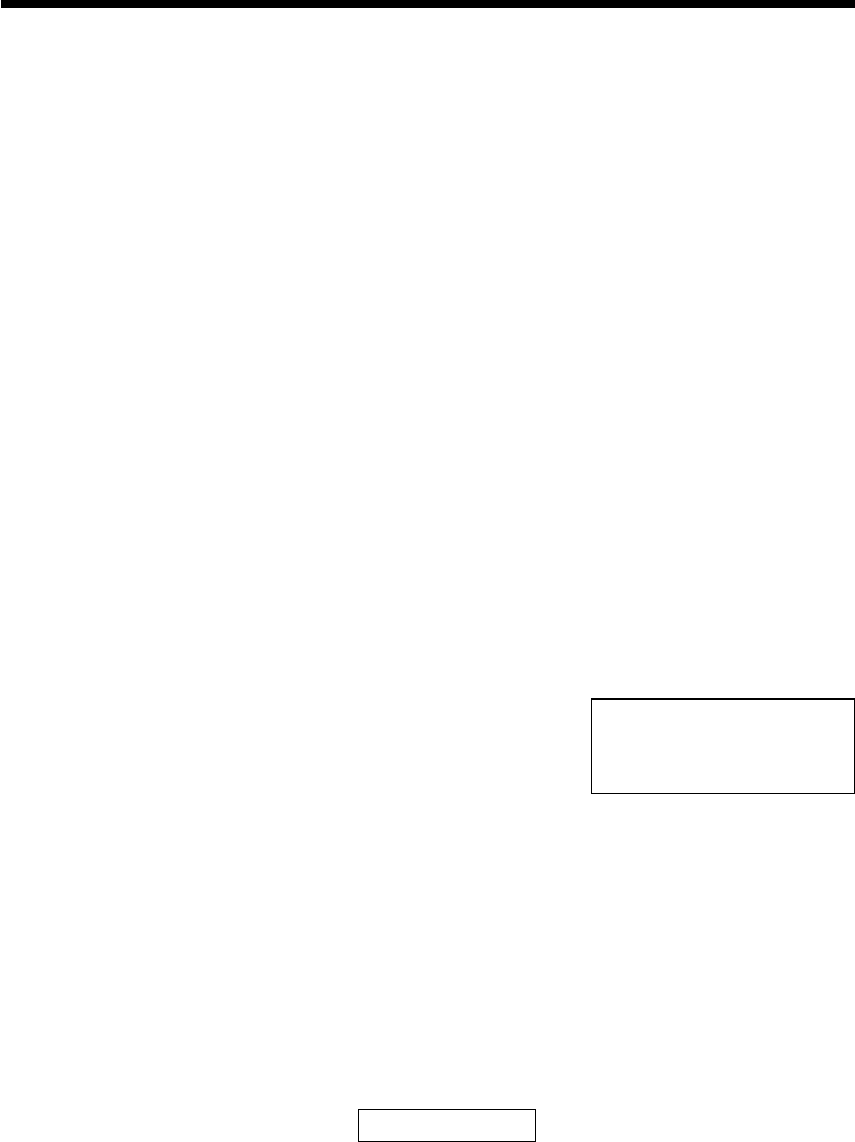
54
Special Features
Automatic Security Code Setting
Each time you place the handset on the base unit, the unit automatically
selects one of more than a million security codes. These codes help
prevent the unauthorized use of your telephone line by another cordless
telephone user.
For Call Waiting Service Users
Press (FLASH/CALL!WAIT/PLAYBACK) or (CALL!WAIT/FLASH) if you hear
a call-waiting tone while talking.
•The first call is put on hold and you can answer the second call.
•To return to the first caller, press (FLASH/CALL!WAIT/PLAYBACK) or
(CALL!WAIT/FLASH) again.
•The call waiting service cannot be used when:
—the answering system is recording someone’s message, or
—a parallel connected telephone is in use.
•If this function does not operate properly, consult your telephone company for
details.
Call Waiting Caller ID Feature
Call Waiting Caller ID Feature allows your unit
to display the second caller’s information. After
you hear a call-waiting tone while talking, the
unit will display the caller’s name with the phone
number and “----Waiting-----”.
•Please contact your telephone company for details and availability in your area.
How to Use the PAUSE Button
(For Analog PBX Line/Long Distance Service Users)
We recommend you press (REDIAL/PAUSE) if a pause is required for
dialing with a PBX or to access a long distance service.
Ex. Line access number (9) (PBX)
(9) \(REDIAL/PAUSE) \
•Pressing (REDIAL/PAUSE) once creates a 3.5 second pause. This prevents
misdialing when you redial or dial a stored number.
•Pressing (REDIAL/PAUSE) more than once increases the length of the pause
between numbers.
Phone number
NANCY BROWN
1-000-222-3333
----Waiting-----
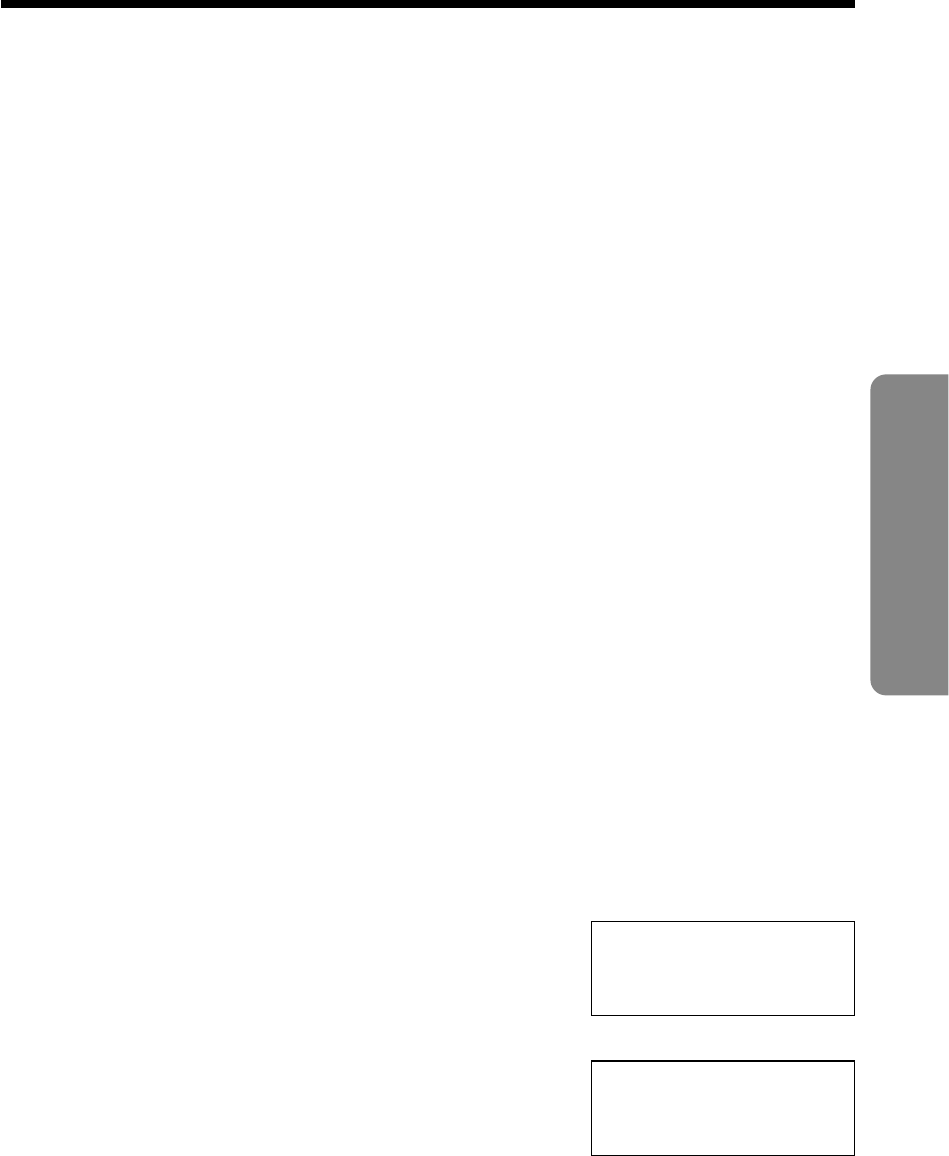
55
Cordless Telephone
Temporary Tone Dialing
(For Rotary or Pulse Service Users)
Press (TONE) before entering access numbers which require tone dialing.
•The dialing mode changes to tone. You can enter numbers to access an
answering service, electronic banking service, etc. When you hang up, the mode
will return to pulse.
•Access numbers entered after pressing (TONE) will not be included when
redialing.
FLASH Button
Pressing (FLASH/CALL!WAIT/PLAYBACK) or (CALL!WAIT/FLASH) allows
you to use special features of your host PBX such as transferring an
extension call or accessing special telephone services (optional) such as
call waiting.
Selecting the flash time
The flash time depends on your telephone exchange or host PBX.
You can select the following flash times: “700, 600, 400, 300, 250, 110,
100 or 90 ms (milliseconds)”. Your phone comes from the factory set to
“700 ms”. Make sure the unit is in the standby mode initially.
1Press (FUNCTION/EXIT/CH).
2Press Öor Ñrepeatedly until the arrow points to “Program”, and
press FWD/EDIT á(Yes key).
3Press Öor Ñrepeatedly until the arrow
points to “Set flash time”, and press
FWD/EDIT á(Yes key).
4Press Öor Ñrepeatedly until the
desired time is displayed, and press
FWD/EDIT á(Save key).
•A beep sounds.
•To return to the standby mode, press (FUNCTION/EXIT/CH).
•You can exit the programming mode any time by pressing
(FUNCTION/EXIT/CH).
•If you are connected via a PBX, a longer flash time may be necessary to use
PBX functions (transferring a call etc.). Consult your PBX supplier for the correct
setting.
Flash time
:700ms
GF H
=Save
Save DIRECT#
H
Set flash time
GF H
=Yes
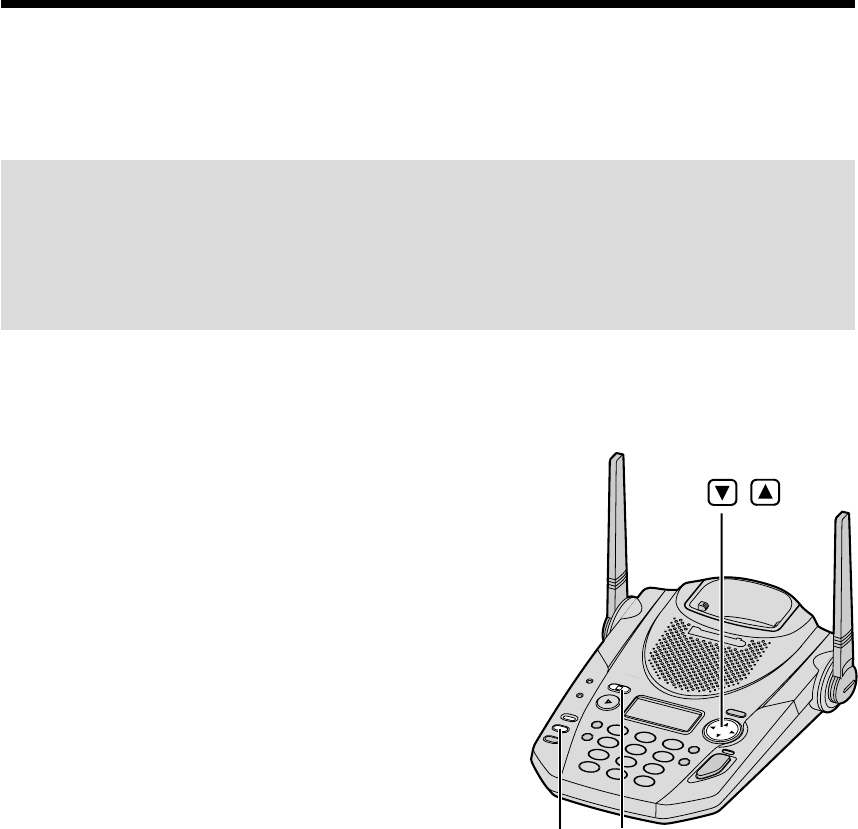
56
Automatic Answering Operation
When the unit answers a call, a greeting message is played and the
caller’s message is recorded. While recording, “- Answering -” will
flash on the base unit display.
•The total recording time (including greeting message) is about
15 minutes. If messages are recorded in noisy rooms, the time may
be shortened by up to 3 minutes.
•A maximum of 64 messages (including greeting message) can be
recorded.
Setting the Unit to Answer Calls
Press (ANSWER!ON) to turn on the answering
system.
•The indicator lights and “Answer set” is
heard.
•The unit will announce the remaining
recording time if it is less than 5 minutes.
•If you hear “Memory full”, “Message
full” is displayed on the base unit and
the ANSWER ON indicator flashes
rapidly, erase some, or all, of the
messages (p. 59).
•If you do not want the unit to answer calls, press (ANSWER!ON) again to turn off
the answering system. The indicator light goes out and “Answer off” is heard.
•You can also turn on the answering system remotely using any other phone
(p. 65).
Monitoring incoming calls
While a call is being recorded, you can monitor it through the base unit
speaker.
To answer the call with the base unit, press (DIGITAL!SP-PHONE). For the
handset, press (TALK). The unit stops recording.
If the call monitoring feature is not required, turn it off by pressing and
holding (STOP/EXIT) in the standby mode. Each time you press and hold
(STOP/EXIT) in the standby mode, the feature will turn on or off.
While monitoring a call, you can turn the feature ON by pressing
Ö
or
Ñ
.
(STOP/EXIT)
(ANSWERÒON)
and Indicator
,
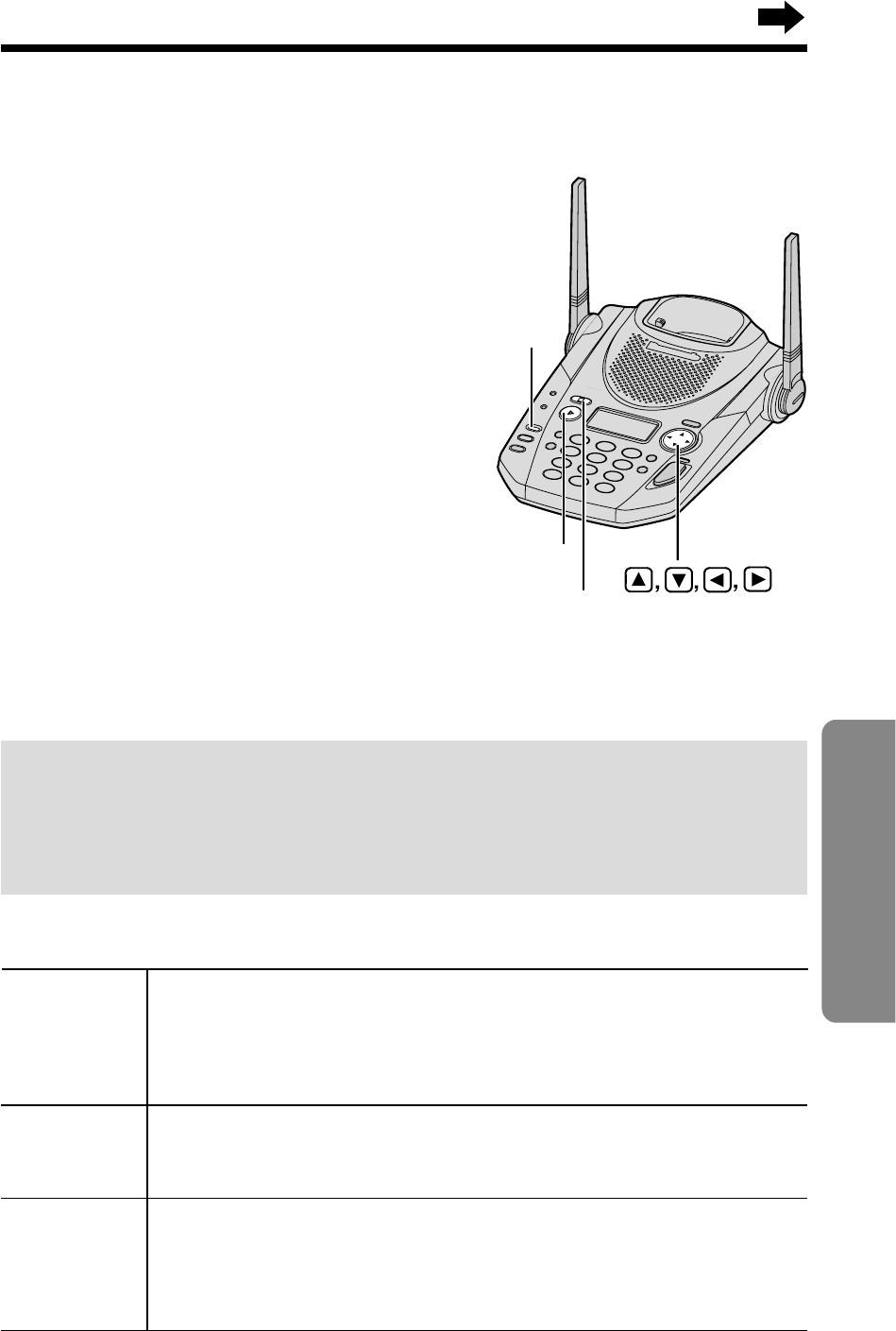
To stop
operation Press (STOP/EXIT).
•To resume playback, press (NEW!MESSAGE).
•If you do not press any button for 60 seconds or if you press
(STOP/EXIT) again, the unit will return to the standby mode.
57
Answering System
Listening to Messages
You can see the total number of recorded messages on the base unit
display. If the ANSWER ON indicator flashes, new messages have been
recorded.
Listening to only new
messages
Press (NEW!MESSAGE) briefly.
•The unit announces the number of new
messages and plays them back.
Listening to all recorded
messages
Press and hold (NEW!MESSAGE)
until playback starts.
•During each message playback, the message number is displayed.
(Ex. While the first message is being played back, “- Message 1 -” is
displayed.)
•At the end of the last message, “End of final message” is heard. The unit will
announce the remaining recording time if it is less than 5 minutes.
To repeat from the beginning of the message
Press Ü.
•If you press within 5 seconds of playback, the previous
message will be played.
To skip to the next message
Press á.
During playback
To repeat
message
To skip
message
(NEW!MESSAGE)
ANSWER ON
Indicator
(STOP/EXIT)
To adjust the speaker volume:
9 levels (0–8) are available while using the
answering system. To increase, press Ñ.
To decrease, press Ö.
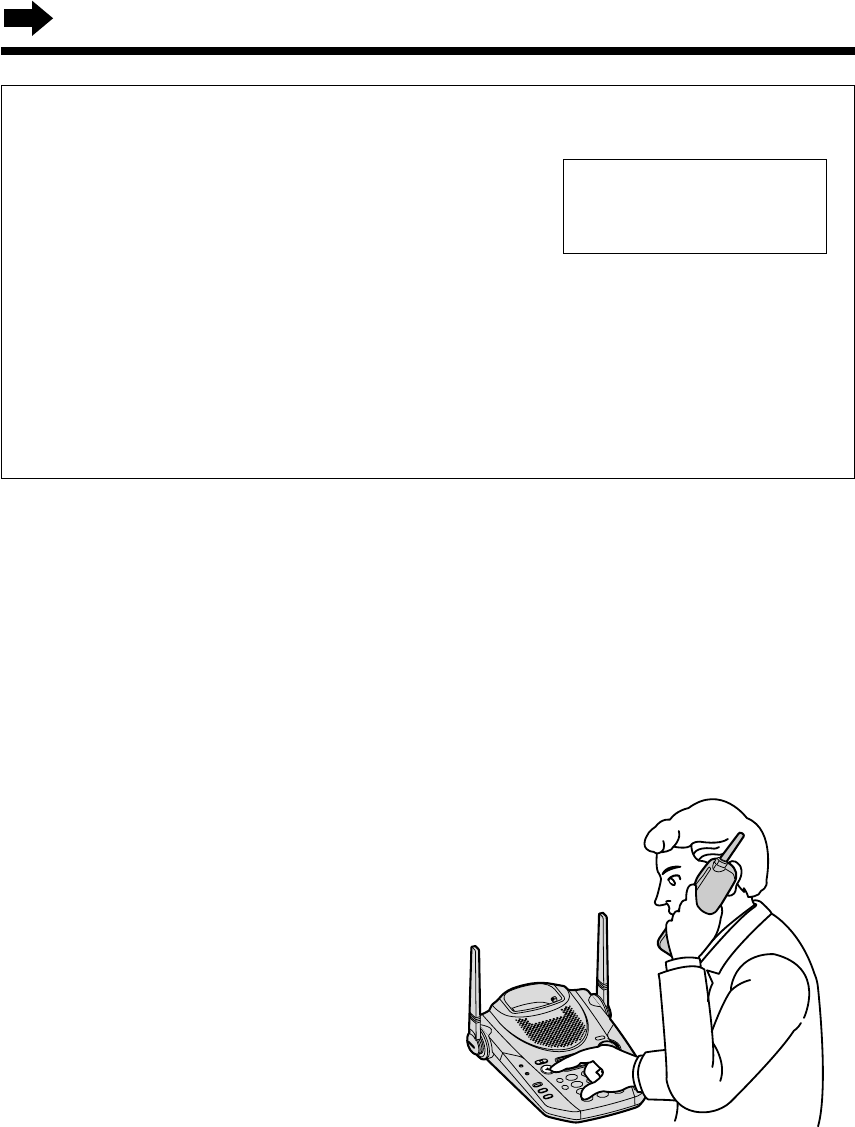
58
Listening to Messages
From the Handset
If someone else is in the room and you want to listen to the recorded
messages privately, you can use the handset.
1Handset:
Press (FLASH/CALL!WAIT/PLAYBACK).
•The number of new messages is heard on the handset.
2Base unit:
To listen to new messages, press
(NEW!MESSAGE) briefly. To listen
to all messages, press and hold
(NEW!MESSAGE) until playback
starts.
•The messages will be heard
on the handset.
•Ü, áand (STOP/EXIT)
can also be used during
playback (p. 57).
3When finished, press
(FLASH/CALL!WAIT/PLAYBACK)
or place the handset on the
base unit.
•You can also listen to messages without using the base unit. See page 66.
For Caller ID service users (p. 32)
During playback, the base unit display will
show the name and/or number of the caller
whose message is being played.
To call back the displayed number:
During playback, lift the handset and press (TALK) within 10 seconds,
or press (DIGITAL!SP-PHONE).
•The unit stops playback and automatically dials the displayed phone number.
•After listening to new incoming messages, “√” will be added to the call entries
in the Caller ID Caller List (p. 35).
JACK SMITH
1-222-333-4444
- Message 3 -
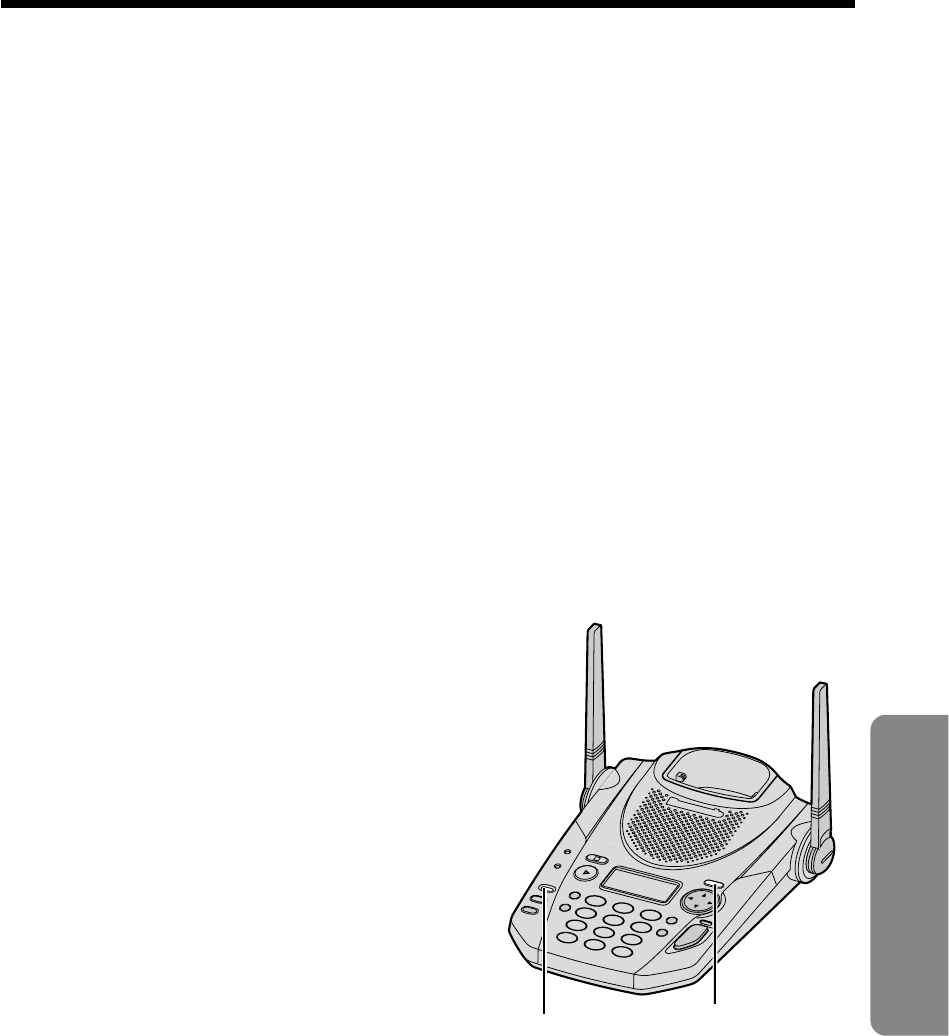
59
Answering System
Erasing Messages
The unit will announce the remaining recording time after playback, if it is
less than 5 minutes. New messages cannot be recorded when:
—“Memory full” is heard.
—“Message full” flashes on the base unit display.
—the ANSWER ON indicator flashes rapidly.
Erase some, or all, of the messages. We recommend you erase
unnecessary messages after each playback.
Erasing a specific message
Press (ERASE) while the message you want to erase is being played.
•The unit erases the message.
•A short beep will sound and the unit will continue to play the next message.
Erasing all messages
All recorded messages, except the greeting message, can be erased at
one time.
1Press (ERASE).
•“Press ERASE again to erase all
messages” is heard.
2Within 5 seconds, press (ERASE)
again.
•A beep sounds and “No messages” is
heard.
•The base unit display shows
“0 message”.
•The information in the Caller List will not be erased. To erase Caller List
information, see page 39.
ANSWER ON
Indicator
(ERASE)
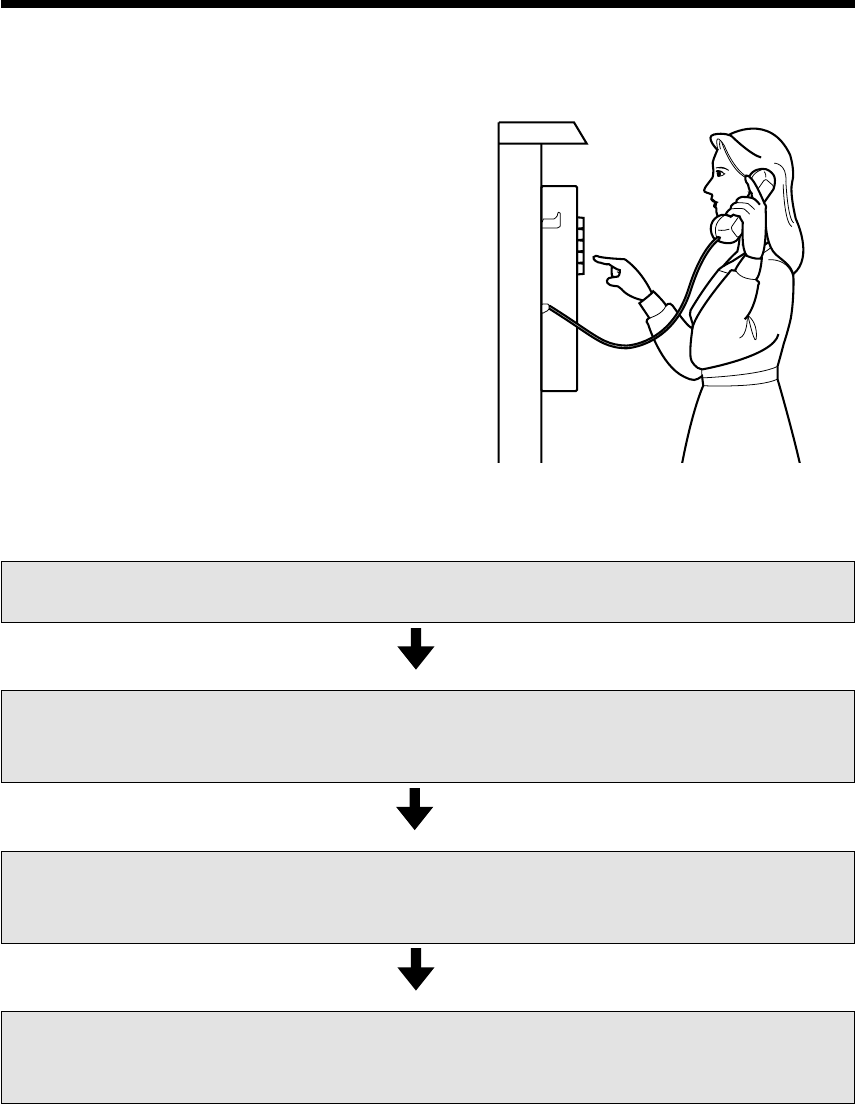
60
Remote Operation from a Touch Tone Phone
You can operate the answering system from any touch tone phone.
A synthesized voice menu will guide you on how to operate the unit
(p. 62).
•To skip the voice menu and operate the
unit directly, see page 64.
Summary of remote operation
Call your unit from a touch tone phone.
Enter your remote code (p. 61) during or after the greeting message.
•The number of new messages is heard.
After 3 seconds, the voice menu will start (p. 62).
Follow the menu or enter the direct commands (p. 64).
To end remote operation, hang up.
•The messages are saved.
•The unit will announce the remaining recording time after playback, if it is less
than 5 minutes.
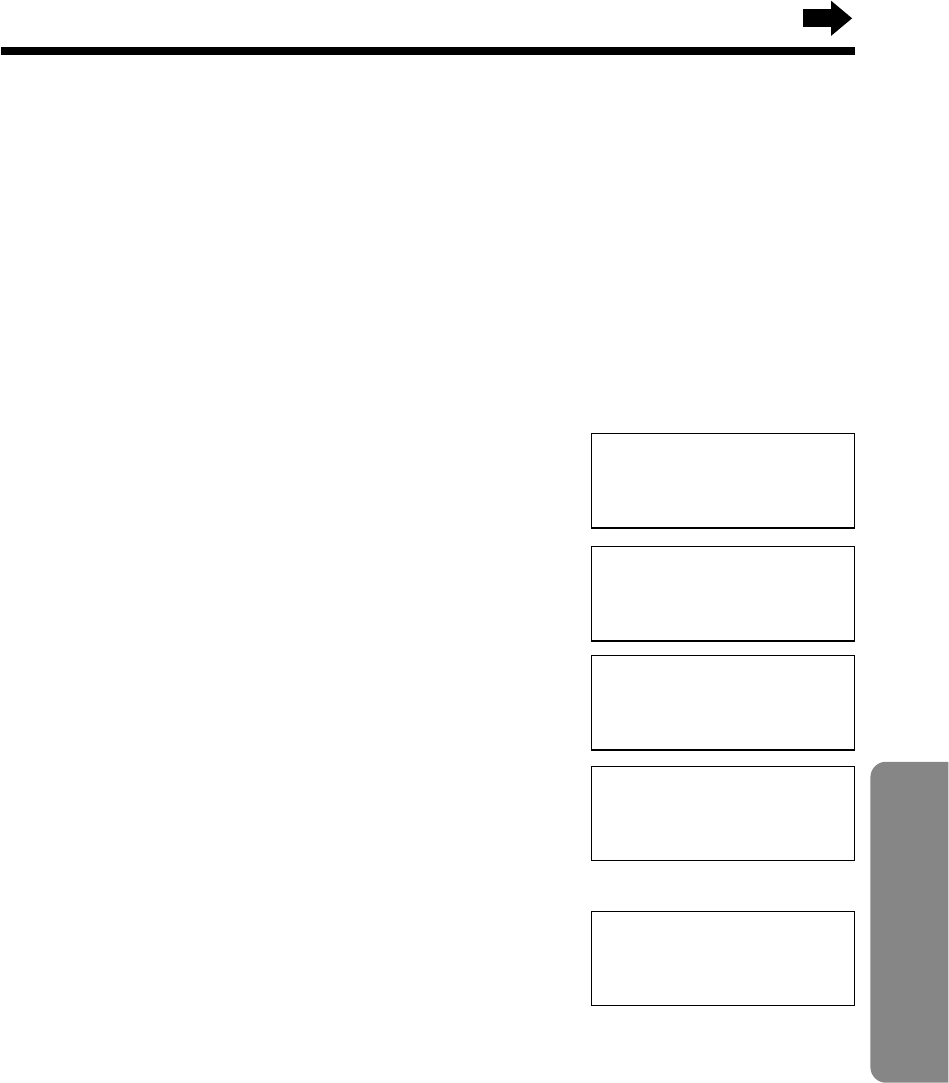
61
Answering System
Setting the Remote Code
The remote code prevents unauthorized people from accessing your unit
and listening to your messages. Choose any 2-digit number (00–99).
The factory preset remote code is “11”. If you do not program your own
remote code, you can use “11”.
Use the handset near the base unit. Make sure the unit is in the
standby mode initially.
1Press (FUNCTION/EXIT/CH).
2Press Öor Ñrepeatedly until the arrow
points to “Program”.
3Press FWD/EDIT á(Yes key).
4Press Öor Ñrepeatedly until the arrow
points to “TAD program”.
5Press FWD/EDIT á(Yes key).
•The base unit display shows programming
options.
6Press (1).
•The current remote code is displayed on the
base unit.
7Enter a remote code using a 2-digit
number (00–99).
8Press FWD/EDIT á(Save key).
•A beep sounds.
•To return to the standby mode, press (FUNCTION/EXIT/CH).
•If 6 beeps sound during programming, a wrong key was pressed. Enter the
correct number.
To check the remote code
Repeat steps 1 to 6.
•The current remote code is displayed on the base unit. When finished, press
(FUNCTION/EXIT/CH).
Answering
system setting.
See base unit.
Remote code
:11
Base unit display
Talk switching
H
TAD program
GF H
=Yes
H
Program
GF H
=Yes
H
Save DIRECT#
Set flash time
GF H
=Yes
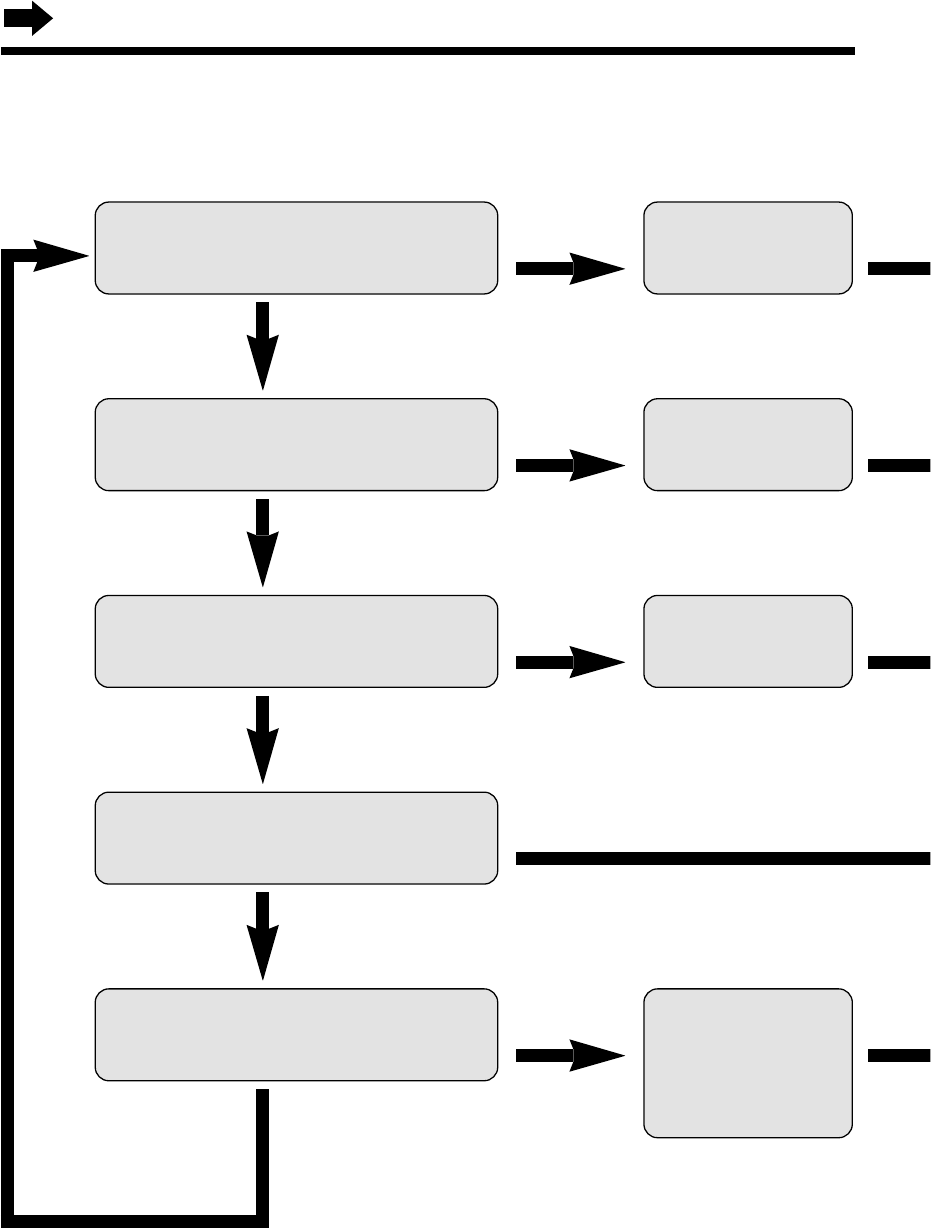
62
Remote Operation from a Touch Tone Phone
Voice Menu
The shaded boxes are voice prompts.
Press 1 to play back all messages.
Press 2 for other functions.
Press 1 to play back new messages.
Press 2 for other functions.
Press 1 to record your message.
Press 2 for other functions.
Press 1 to erase all messages.
Press 2 for other functions.
Press 1 to record your greeting.
Press 2 for other functions.
All message
playback.
New message
playback.
Please leave
your message.
Press 7 to record
your greeting.
Press 9 to end
recording.
Press (2).
Press (2).
Press (2).
Press (2).
Press (2).
Press (1).
Press (1).
Press (1).
Press (1).
Press (1).
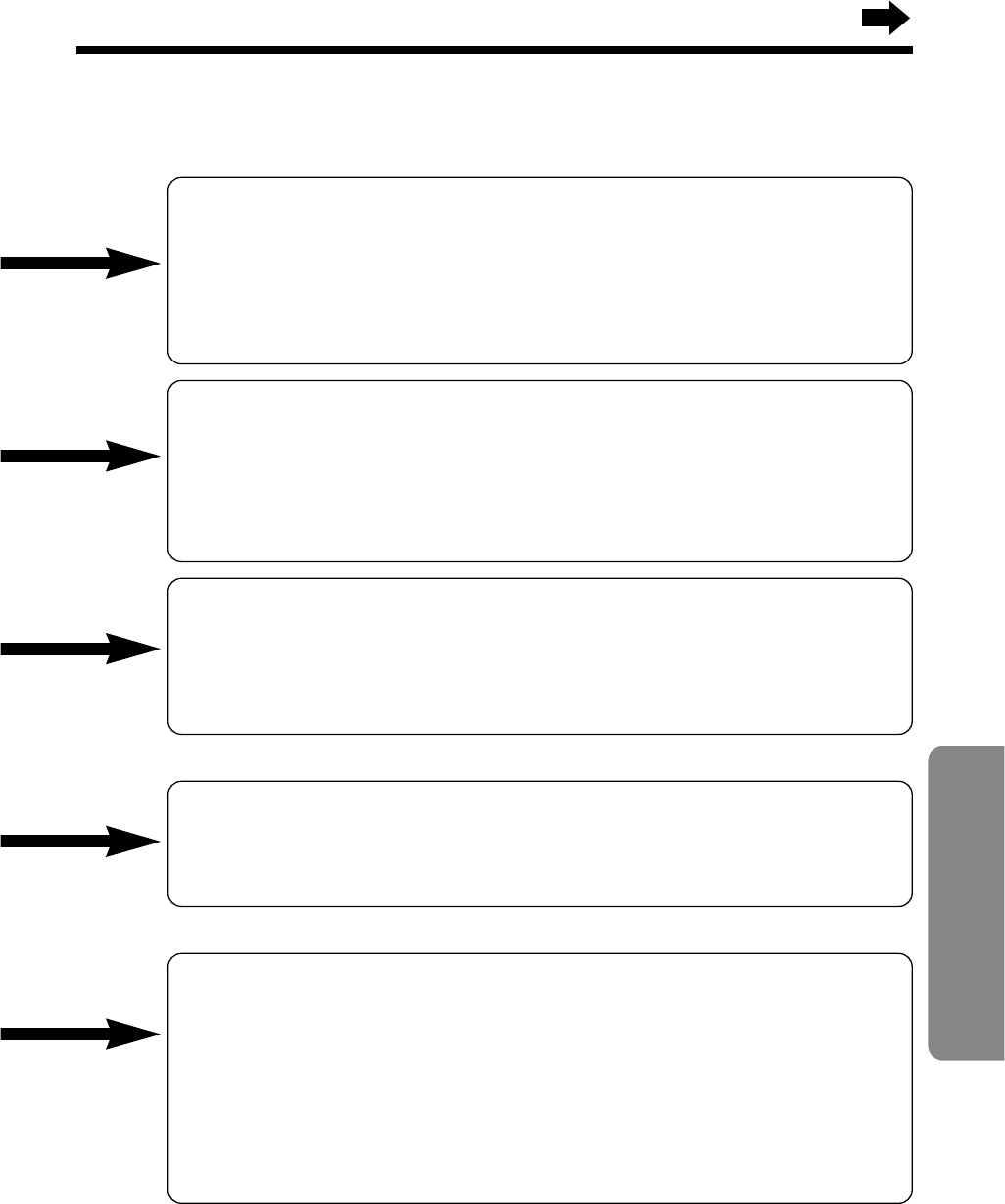
63
Answering System
All Message Playback
All recorded messages are played back. At the end of the last
message, “End of final message” is heard. The unit will
announce the remaining recording time if it is less than
5 minutes.
New Message Playback
Only new messages are played back. At the end of the last
message, “End of final message” is heard. The unit will
announce the remaining recording time if it is less than
5 minutes.
Recording a Memo Message
You can leave a personal message.
1. Talk after you hear “Please leave your message”.
2. When you finish recording, hang up.
Erasing All Messages
All recorded messages (except greeting message) are
erased.
Recording a Greeting Message
You can re-record your greeting message.
1. Press (7).
You will hear a voice prompt followed by a long beep.
2. After the beep, talk for up to 2 minutes.
3. When you finish recording, press (9).
4. Your greeting will be played back for confirmation.
•3 seconds after playback, the voice menu will start again from the beginning.
•If you hear “Memory full” after playback, erase some, or all, of the messages
(p. 64).
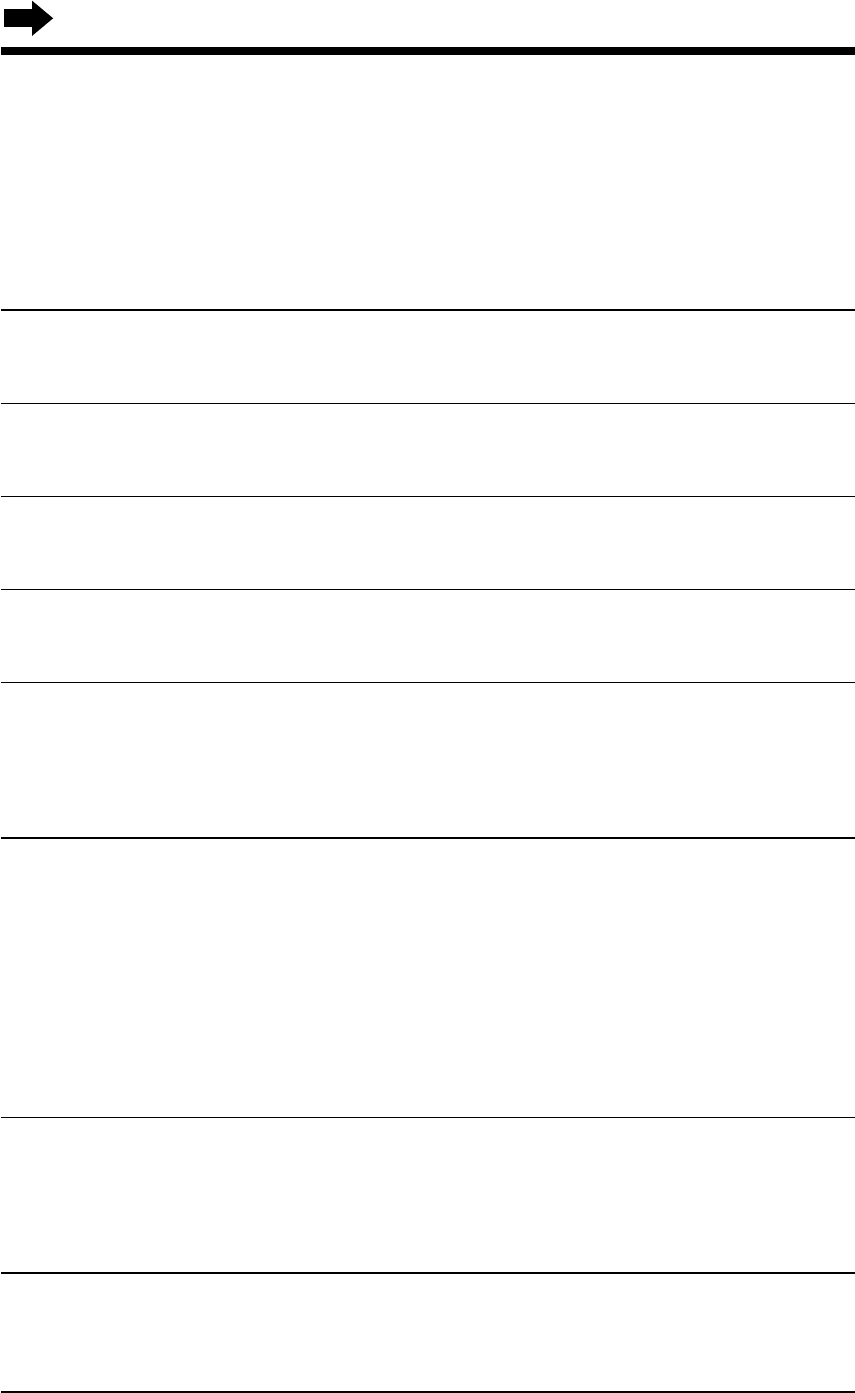
64
[
Remote Operation from a Touch Tone Phone
Direct Remote Operation
Once you have entered the remote code, you can also control your unit
by direct commands instead of using the voice menu. To end the remote
operation, hang up anytime.
Direct commands
NEW MESSAGE
PLAYBACK
ALL MESSAGE
PLAYBACK
REPEAT
(During playback)
SKIP
(During playback)
STOP
GREETING
MESSAGE
RECORDING
ERASING A
SPECIFIC
MESSAGE
(During playback)
ERASING ALL
MESSAGES
(4)
(5)
(1)
(2)
(9)
(7)
(9)
(*) (4)
(*) (5)
•Only new messages are played back.
•All messages are played back.
•The current message is repeated.
•The current message is skipped.
The next message is played.
•Operation is stopped temporarily.
•To resume operation, enter a direct
command within 15 seconds, or the
voice menu will start.
•A long beep sounds.
•After the beep, talk immediately for up to
2 minutes.
•The recording is stopped.
•The recorded message is played.
•The current message is erased.
•A short beep will sound and the next
message will be played.
•All recorded messages are erased.
•A long beep sounds and “No messages” is
heard.
RECORD
[

65
Answering System
ANSWERING
SYSTEM OFF (0) •The unit hangs up and will not answer
calls until turned on again.
Turning on the answering system
Call your unit and wait for 15 rings.
•The unit will answer and the greeting message will be played.
•The answering system will turn on. Hang up or enter the remote code for other
options.
•When turning on the answering system using a rotary or pulse service telephone,
you cannot enter the remote code for other options.
Skipping the greeting message
After calling your unit, press (*) during the greeting message.
•The unit skips the rest of the greeting message and you can start recording your
message after the long beep.
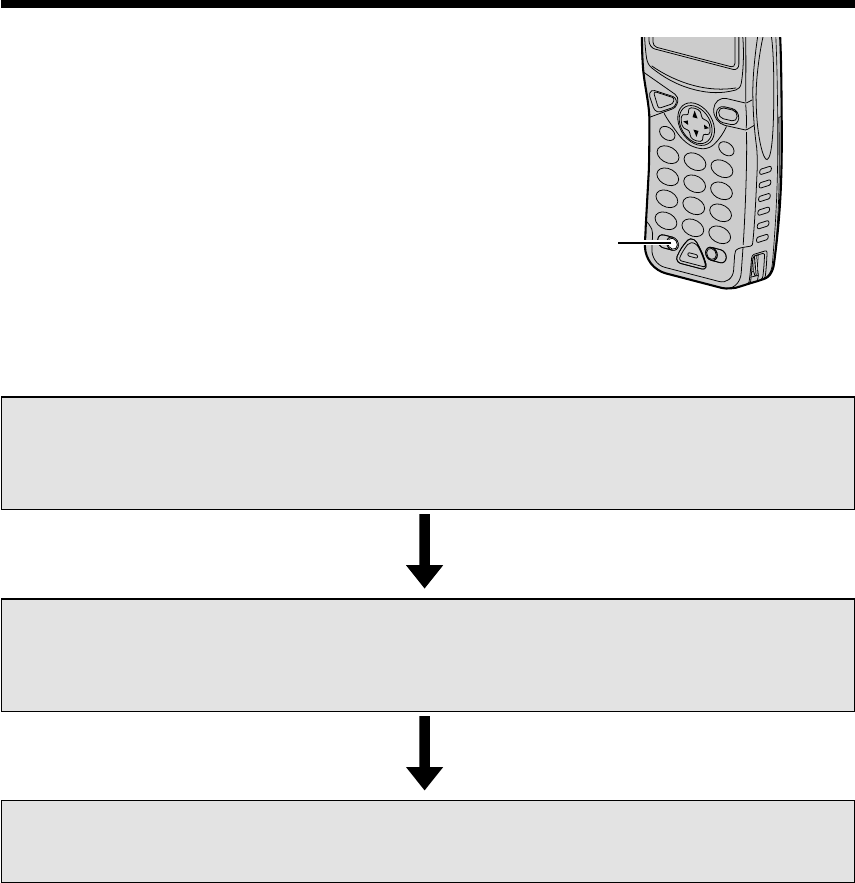
66
Remote Operation with the Handset
Voice menu
If no commands are entered after you press
(FLASH/CALL!WAIT/PLAYBACK), the unit will start the following voice
menu.
“Press 4 to play back new messages. Press 5 to play back all messages.”
•You can enter direct commands even if the voice menu has started.
You can operate your answering system
with the handset.
The announcements and recorded
messages can only be heard with the
handset.
Summary of remote operation
Press (FLASH/CALL!WAIT/PLAYBACK).
•The number of new messages is heard.
•“Remote operation” is displayed on the handset.
Enter the desired direct commands (p. 67).
•If you do not enter a command, the voice menu will start (see below).
•After the voice menu, all message playback will start.
To end remote operation, press (FLASH/CALL!WAIT/PLAYBACK).
•The messages are saved.
•The unit will announce the remaining recording time after playback, if it is less
than 5 minutes.
•If the unit starts to ring during the remote operation, press (TALK) to answer the
call. The remote operation is ended.
•If you hear “Memory full” after playback, erase some, or all, of the messages
(p. 67).
(FLASH/CALLÒWAIT/PLAYBACK)
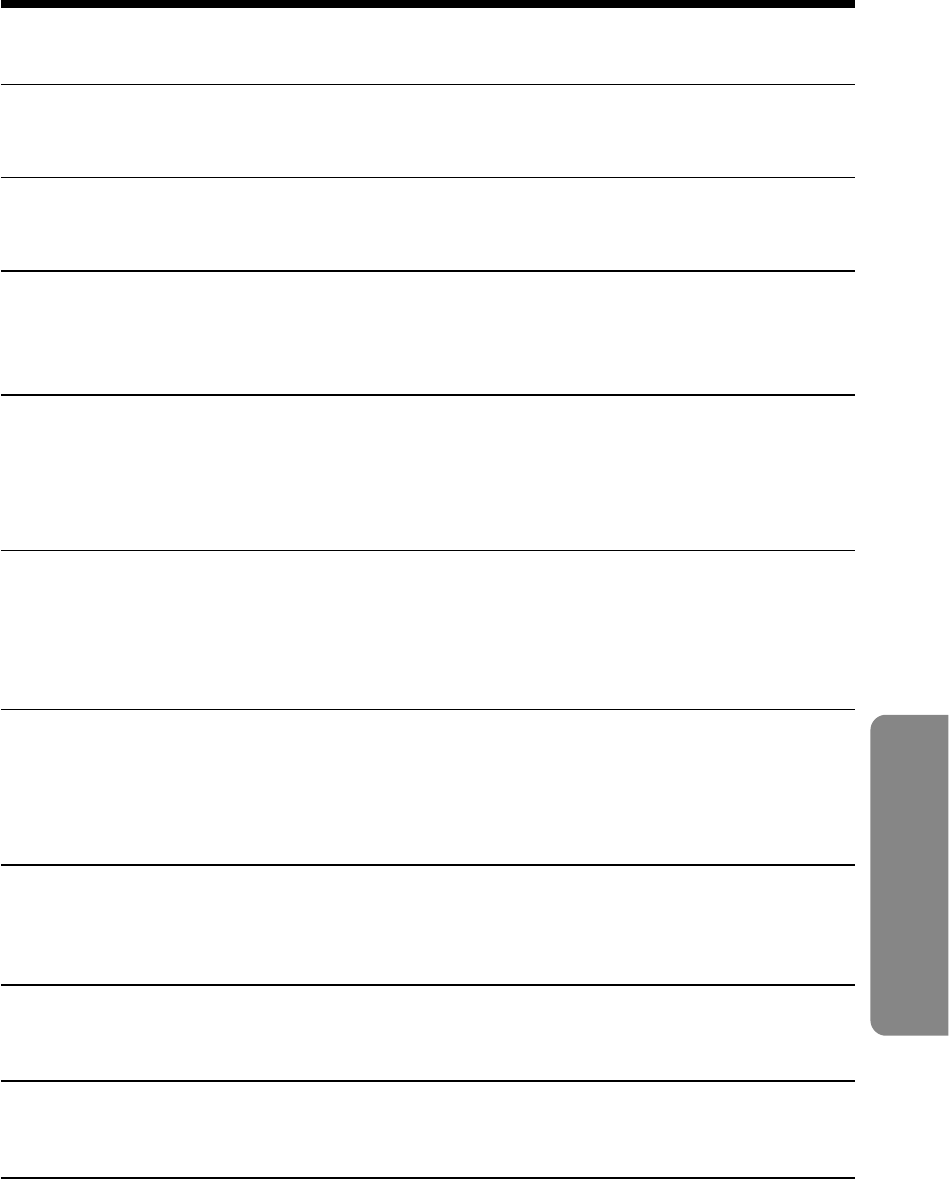
67
Answering System
Direct commands
NEW MESSAGE
PLAYBACK
ALL MESSAGE
PLAYBACK
REPEAT
(During playback)
SKIP
(During playback)
STOP
ERASING A
SPECIFIC
MESSAGE
(During playback)
ERASING ALL
MESSAGES
ANSWERING
SYSTEM OFF
ANSWERING
SYSTEM ON
(4)
(5)
(1)
(2)
(9)
(*) (4)
(*) (5)
•Only new messages are played back.
•All messages are played back.
•The current message is repeated.
•You can also press BACK Üto repeat a
message.
•The current message is skipped.
The next message is played.
•You can also press FWD/EDIT áto skip
a message.
•Operation is stopped temporarily.
•To resume operation, enter a direct
command within 15 seconds, or the
voice menu will start (p. 66).
•The current message is erased.
•A short beep will sound and the next
message will be played.
•All recorded messages are erased.
•A long beep sounds and “No messages” is
heard.
•“Answer off” is heard and the answering
system is turned off.
•“Answer set” is heard and the answering
system is turned on.
(0)
(8)
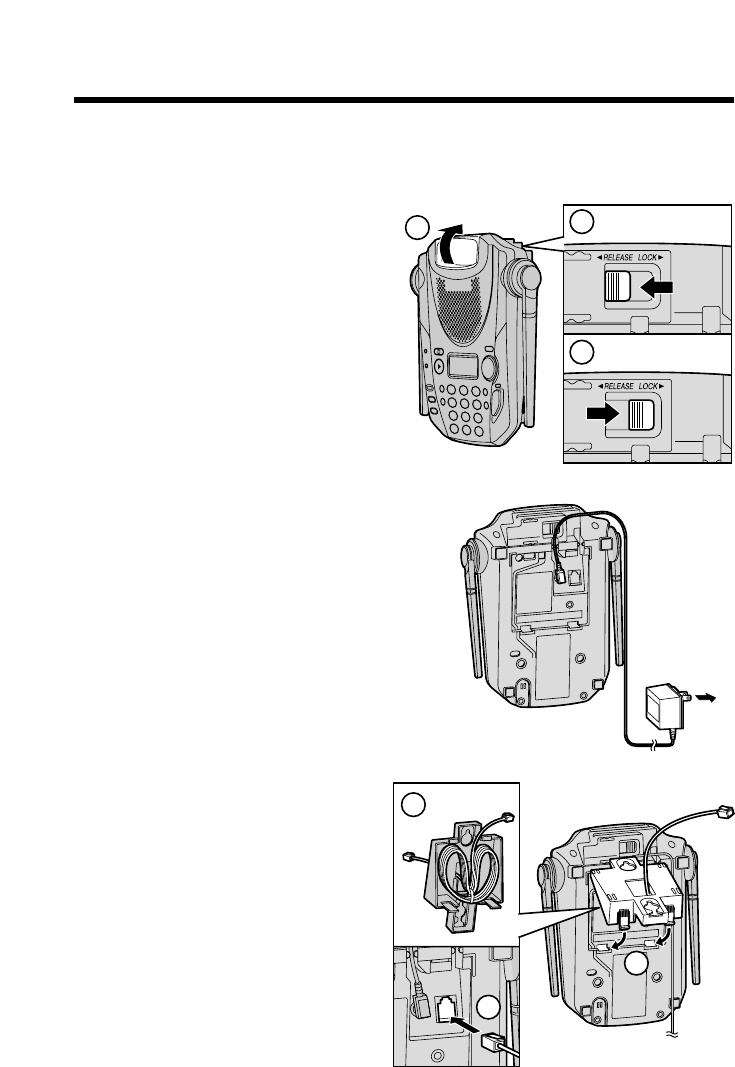
68
Wall Mounting
This unit can be mounted on a wall phone plate.
2Connect the AC adaptor.
3#Tuck the telephone line
cord inside the wall
mounting adaptor.
$Connect the telephone line
cord to the unit.
%Install the adaptor by
pushing it in the direction of
the arrow.
•The word “UP” should face
upward.
1Adjust the angle of the cradle:
#Slide the lock switch
to “RELEASE”.
$Rotate the cradle 90°
until it stops.
%Slide the lock switch
to “LOCK”.
1
3
2
To Power
Outlet
1
3
2
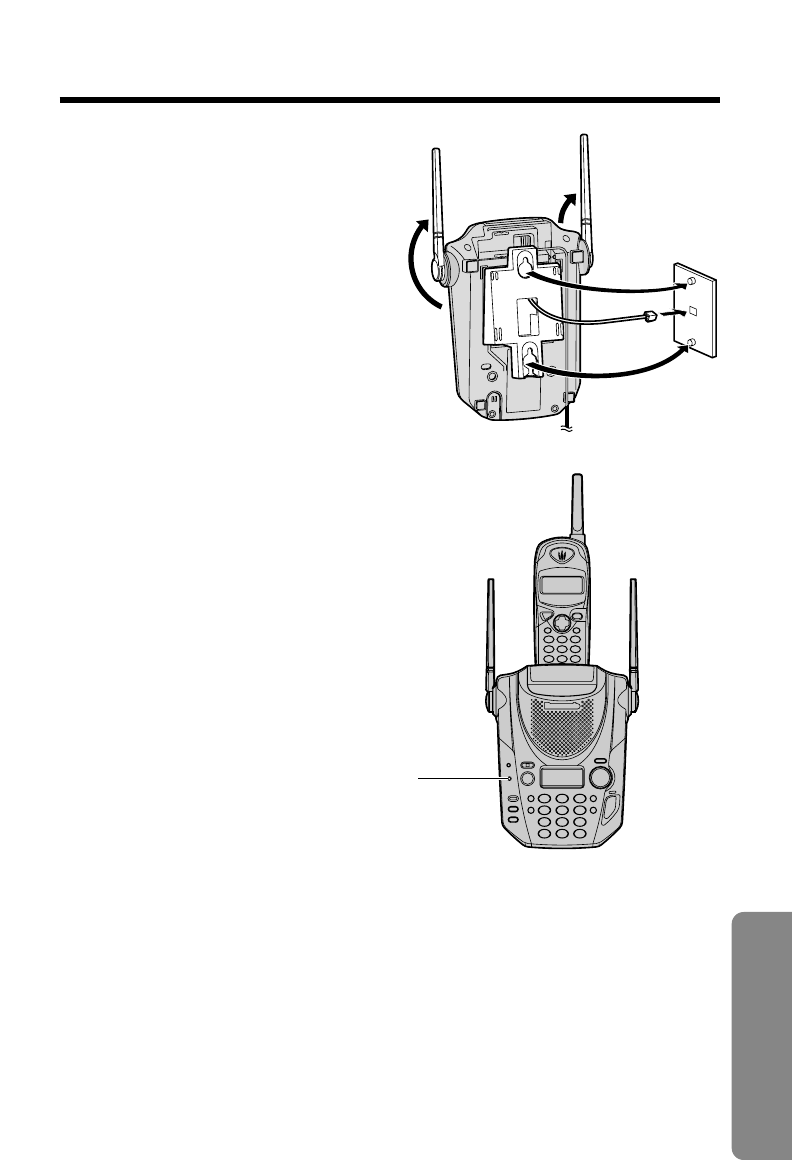
69
Useful Information
4Connect the telephone line
cord. Mount the unit, then
slide down.
•Raise the antennas.
5To charge the handset battery:
Place the handset in the cradle as
shown.
•The IN USE/CHARGE indicator lights.
IN USE/CHARGE
Indicator
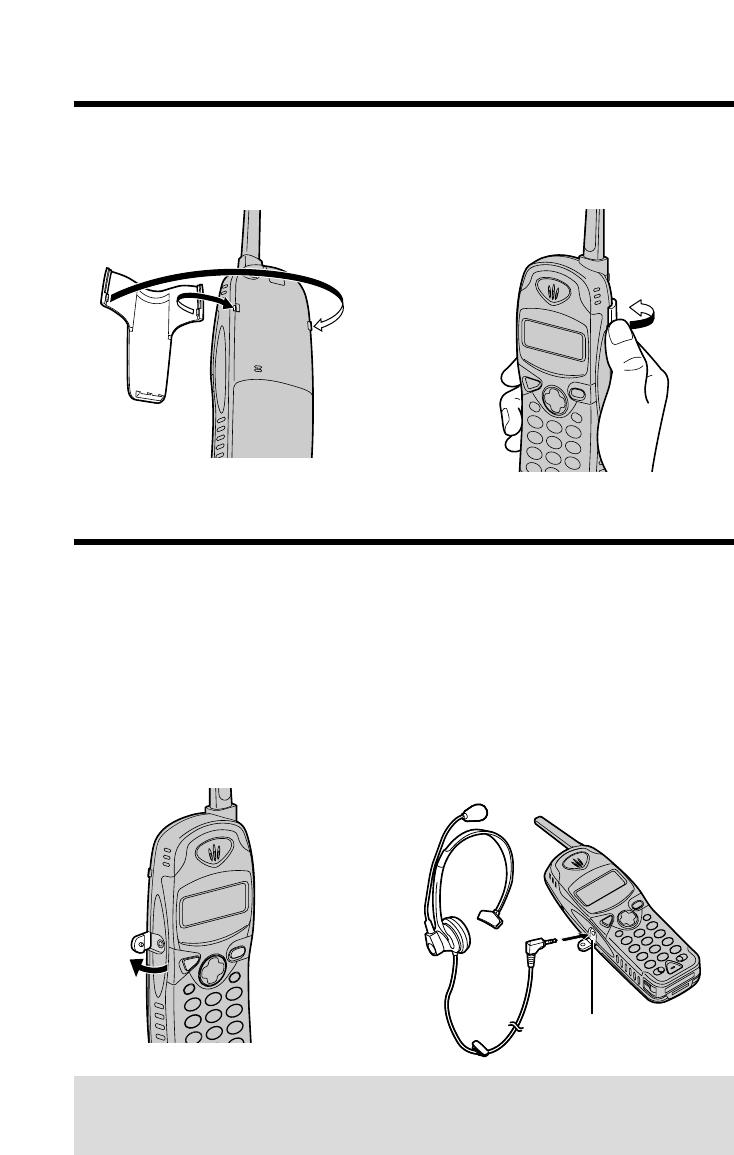
Using an Optional Headset
70
Plugging an optional headset into the handset allows a hands-free phone
conversation. Please use only the Panasonic KX-TCA88 headset. To order
call the accessories telephone number on page 2.
With the Handset
Connecting the headset to the handset
Open the headset jack cover, and connect the headset to the headset
jack as shown below.
Headset Jack
H
When the optional headset is connected to the handset, make sure to use the
headset to talk with the caller. If you want to have a normal cordless phone
conversation, disconnect the headset.
Using the Belt Clip
You can hang the handset on your belt or pocket using the belt clip.
To attach the belt clip To remove the belt clip
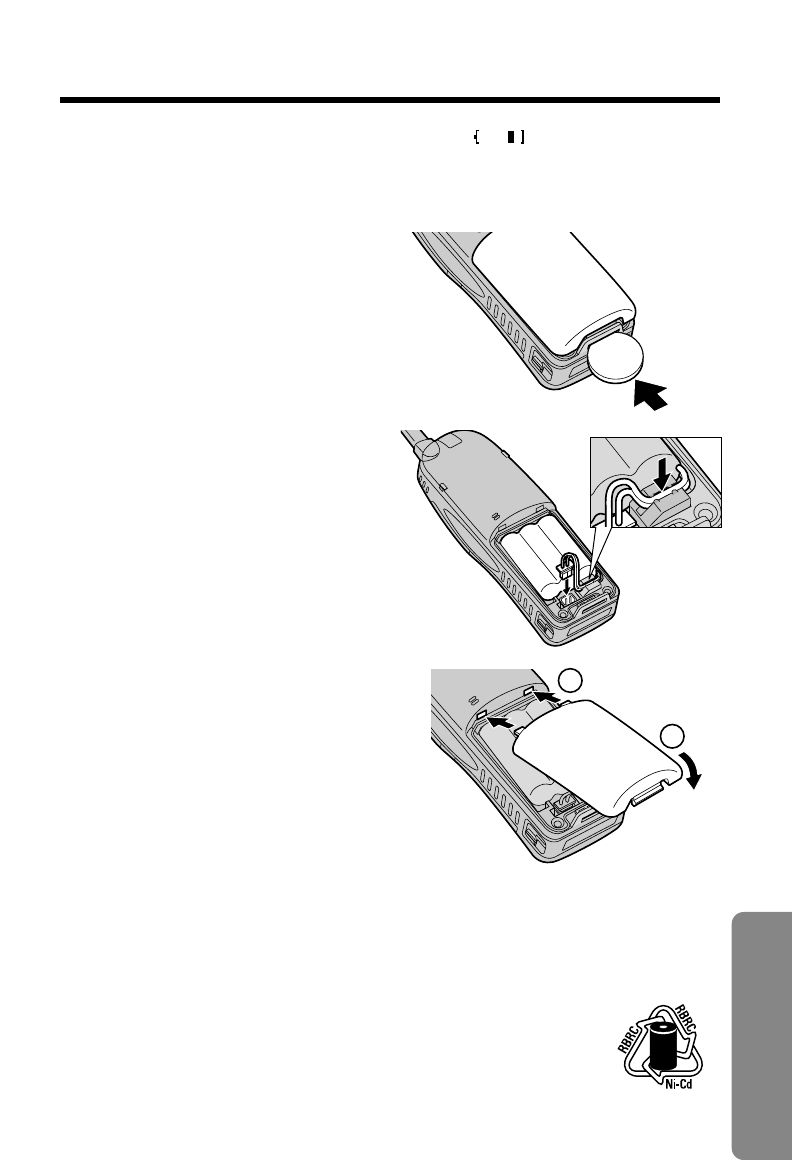
71
Useful Information
Battery Replacement
Attention:
The product you have purchased is powered by a nickel
cadmium battery which is recyclable. At the end of its
useful life, under various state and local laws, it is illegal
to dispose of this battery into your municipal waste
stream. Please call 1-800-8-BATTERY for information on
how to recycle this battery.
If “Recharge battery” is displayed and/or “” flashes after being
fully charged, replace the battery with a new Panasonic P-P508 battery.
To order, call the accessories telephone number on page 2.
1Carefully insert a flat metal
object in the slot, and push
forward to release the lock.
Remove the handset cover.
2Replace the battery. Place
the battery leads inside the
groove, otherwise the leads
may be damaged when
closing the cover.
3Close the cover.
4Make sure you charge the new battery for about 6 hours in order to
display the battery strength prompt correctly (p. 11).
1
2
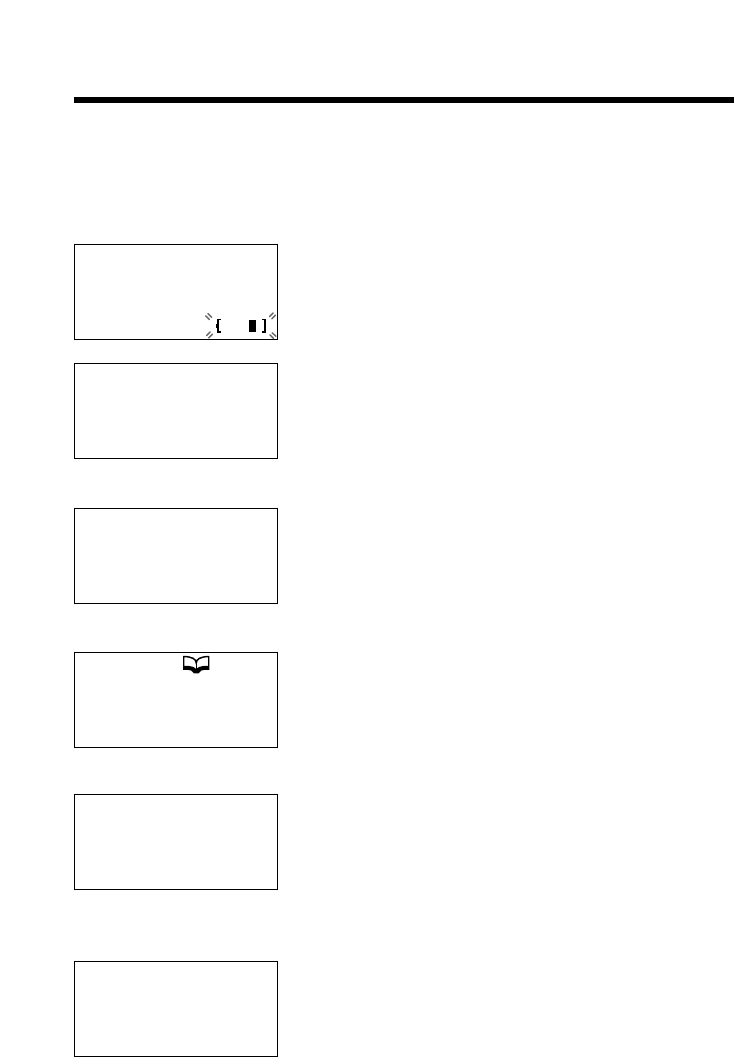
72
If the Following Appear...
If the unit detects a problem, one of the following messages will be
displayed on the handset or the base unit.
Handset display
Recharge battery
No link to base.
Place on cradle
and try again.
Please lift up
and try again
Not available
Save error
The battery needs to be charged. Place the
handset on the base unit to charge the battery
(p. 11).
The handset has lost communication with the
base unit. Place the handset on the base unit
and try again.
Ö, Ñ, BACK Üor FWD/EDIT áwas pressed
while the handset was on the base unit. Lift the
handset and press the button again.
When trying to store an item or Caller List
information in the directory, the directory
memory is full (p. 38, 44). To erase other stored
items from the directory, see page 51.
While the base unit was not in the standby mode,
Öor Ñwas pressed to search the Caller
List/directory list, FWD/EDIT áwas pressed to
select an option, or (INTERCOM/CLEAR) or
(FLASH/CALL!WAIT/PLAYBACK) was pressed.
While storing items in the directory, the handset
has lost communication with the base unit.
Move closer to the base unit and try again.
Directory full
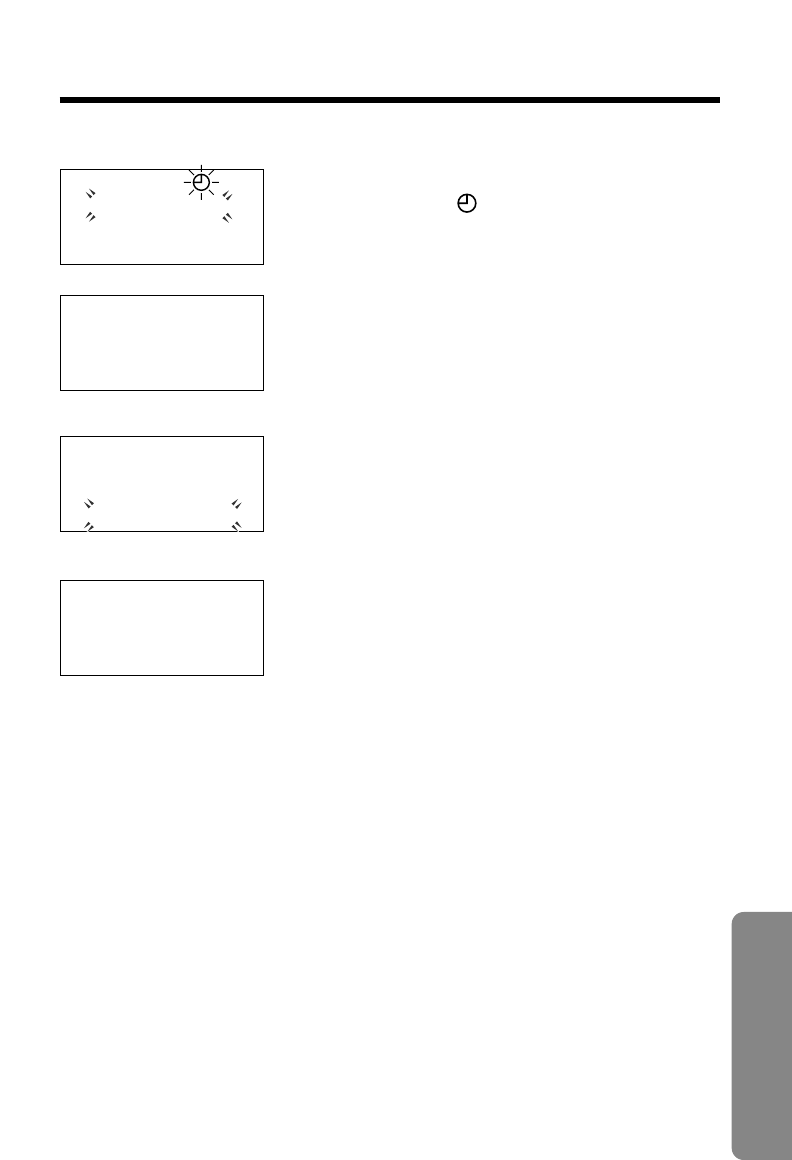
73
Useful Information
Base unit display
SUN 12:00AM
0 messages
Greeting record
Recording error
SUN 12:00AM
Message full
Handset in use
When the clock needs adjusting, the day and
time flashes with “”. Adjust the clock (p. 22).
Your greeting message was not recorded
correctly. Record it again (p. 19).
If message memory is full, “Message full”
will flash. Erase some, or all, of the messages
(p. 59).
The display will be shown when the handset is
in use (making/answering a call, viewing the
Caller List or directory list, listening to
messages, etc.).
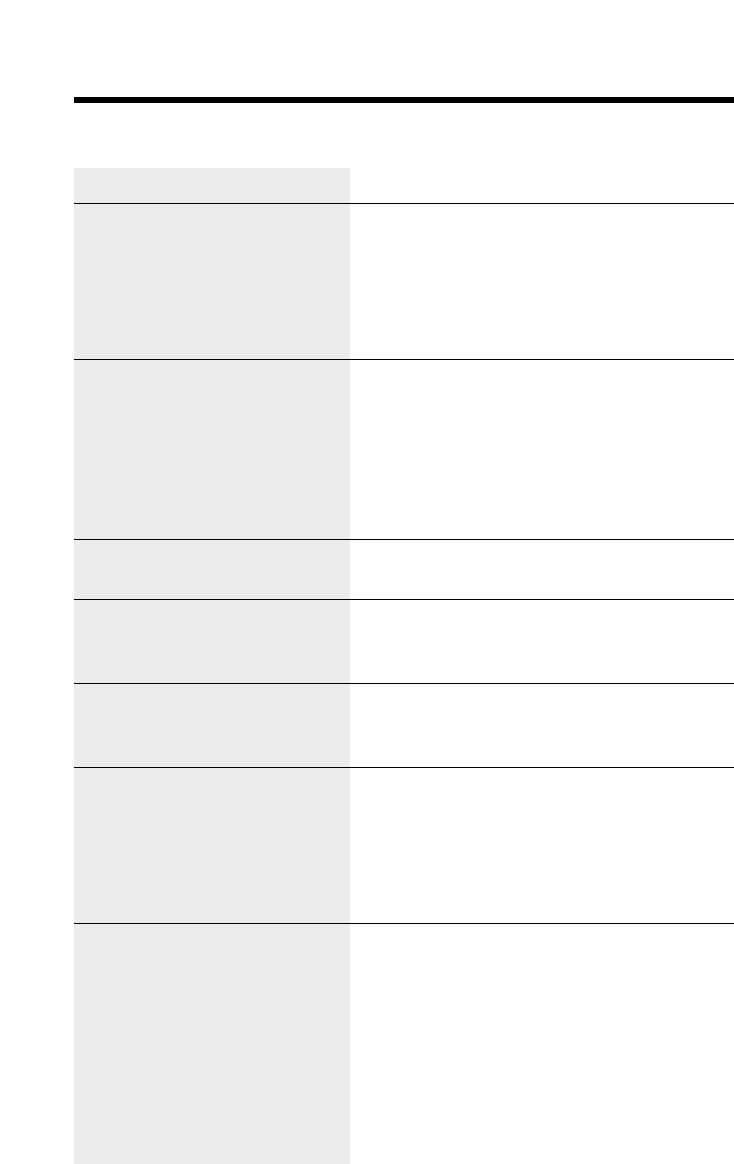
74
Before Requesting Help
Problem
“No link to base.
Place on cradle and
try again.” is displayed
and an alarm tone sounds.
Static, sound cuts in/out,
fades. Interference from
other electrical units.
The handset and/or the base
unit do not ring.
The handset display is
blank.
The handset display is still
blank after pressing Ö, Ñ,
BACK Üor FWD/EDIT á.
You cannot store a name
and phone number in the
directory.
While programming or
searching, the unit starts to
ring and stops the program/
search.
Remedy
•You are too far from the base unit. Move
closer and try again.
•Place the handset on the base unit and
try again.
•Plug in the AC adaptor.
•Raise the base unit antennas.
•Locate the handset and the base unit
away from other electrical appliances
(p. 3).
•Move closer to the base unit.
•Raise the base unit antennas.
•Press (FUNCTION/EXIT/CH) to select a
clearer channel.
•The ringer volume is set to OFF. Set to
HIGH or LOW (p. 17, 18).
•The handset is in the standby mode
(p. 9). Press Ö, Ñ, BACK Üor
FWD/EDIT áto turn the display on.
•Charge the battery fully (p. 11).
•You cannot store an item in the directory
while the unit is in the talk,
speakerphone or intercom mode, or
while the answering system is in use.
•Do not pause for over 60 seconds while
storing.
•To answer the call, press (TALK) or
(DIGITAL!SP-PHONE). Start again from
the beginning after hanging up.
Cordless Telephone
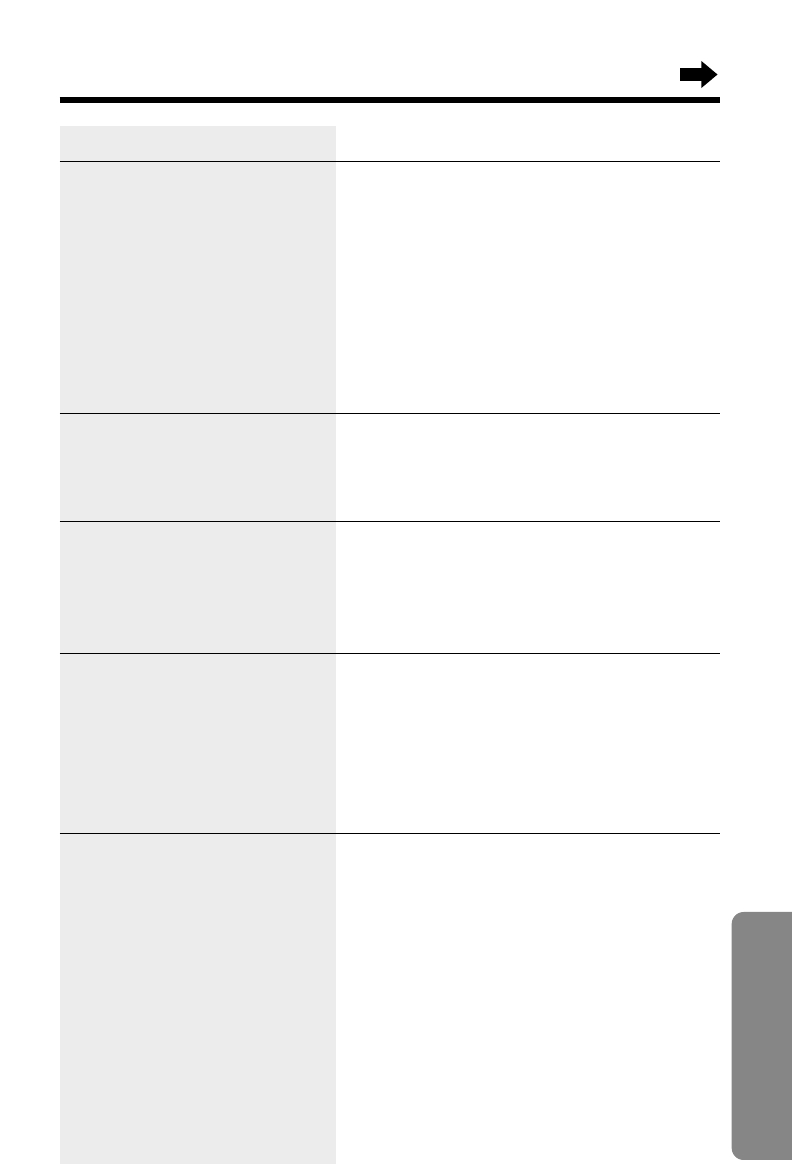
75
Useful Information
Problem
The unit does not display the
caller’s name and/or phone
number.
The handset or base unit
display goes to the standby
mode while viewing the
Caller List.
When a second call is
received during a
conversation, the unit does
not display the new caller’s
name and/or phone number.
You cannot page the
handset or the base unit.
You cannot redial by
pressing (REDIAL/PAUSE).
Remedy
•You need to subscribe to a Caller ID
service from a telephone company.
•Other telephone equipment may be
interfering with your phone. Disconnect
it and try again.
•Other electrical appliances connected to
the same outlet may be interfering with
the Caller ID information.
•Telephone line noise may be affecting
the Caller ID information.
•Do not pause for over 60 seconds while
searching.
•The line mode selection is incorrect. See
page 14.
•The handset is too far from the base unit.
•The handset or the base unit is engaged
in an outside call, viewing the Caller
List/directory list or listening to
messages. Try again later. If you are
using the base unit, wait until “Handset
in use” disappears.
•If the last number dialed was more than
32 digits long, the number will not be
redialed correctly.
•Access numbers entered after pressing
(TONE) will not be included when
redialing.
•The button has a double function as
either redial or pause. It will redial the
last number dialed if pressed at the
outset of a call (p. 26, 29). If another
number has been dialed first, it will
operate as a pause button (p. 54).
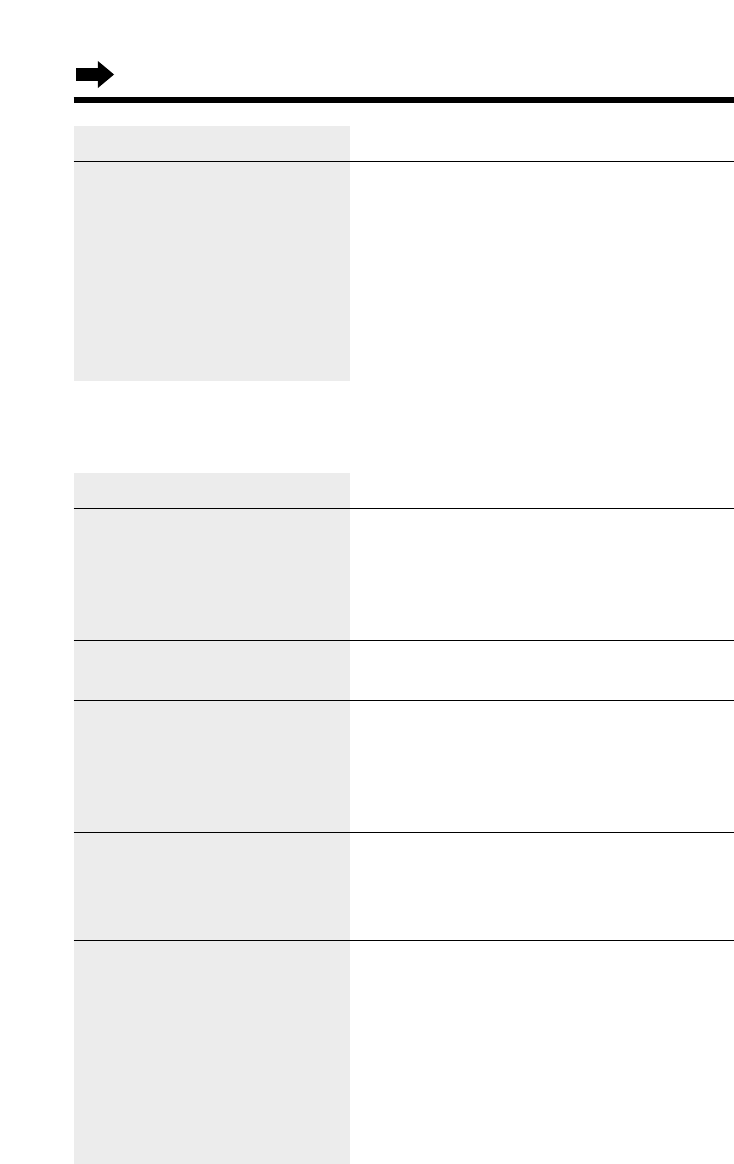
76
Before Requesting Help
Problem
The answering system is on,
but incoming messages are
not recorded.
You cannot listen to the
recorded messages.
“Message full” flashes
on the base unit display and
the ANSWER ON indicator
flashes rapidly, and no new
messages are recorded.
You cannot operate the
answering system at the
base unit.
You cannot operate the
answering system from a
touch tone phone.
Remedy
•The recording time is set to “Greeting
only”. Select “1 minute” or “3 minutes”
(p. 24).
•Memory is full. Erase some, or all, of the
messages (p. 59).
•Make sure that the unit is in the standby
mode.
•Memory is full. Erase some, or all, of the
messages (p. 59).
•The handset user is operating the
answering system, or is engaged in an
outside call. Wait until “Handset in
use” disappears.
•Make sure you enter the correct remote
code.
•The answering system may not respond
if the tones are too short to activate the
unit. Press each button firmly.
•The answering system is off. Turn it on
(p. 65).
Answering System
Problem
You cannot have a
conversation using the
headset.
Remedy
•When the headset is connected (p. 70),
you must use the headset to talk with
the caller. To have a normal cordless
phone conversation, disconnect the
headset.
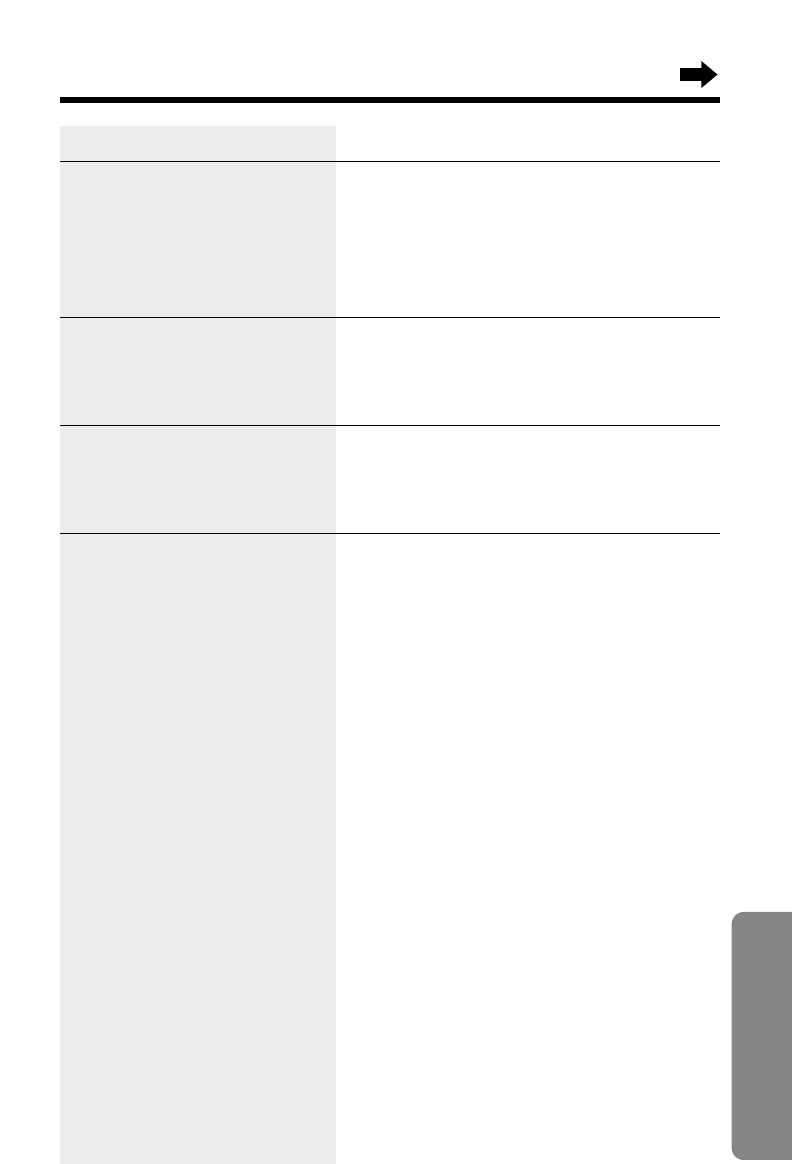
77
Useful Information
Problem
You cannot operate the
answering system with the
handset.
While recording a greeting
message, the unit starts to
ring and stops recording.
During playback, the unit
starts to ring and stops
playback.
The base unit does not
display the name and/or
number of the caller whose
message is being played.
Remedy
•Someone is operating the answering
system.
•You are too far from the base unit. Move
closer to the base unit.
•The unit is recording a message.
To answer the call, press (TALK).
•To answer the call, press
(DIGITAL!SP-PHONE) or press (TALK).
Start again from the beginning after
hanging up.
•To answer the call, press
(DIGITAL!SP-PHONE) or press (TALK). To
resume playback, press
(NEW!MESSAGE) after hanging up.
•If the caller is not stored in the Caller
List, the handset will not display the
caller’s information.
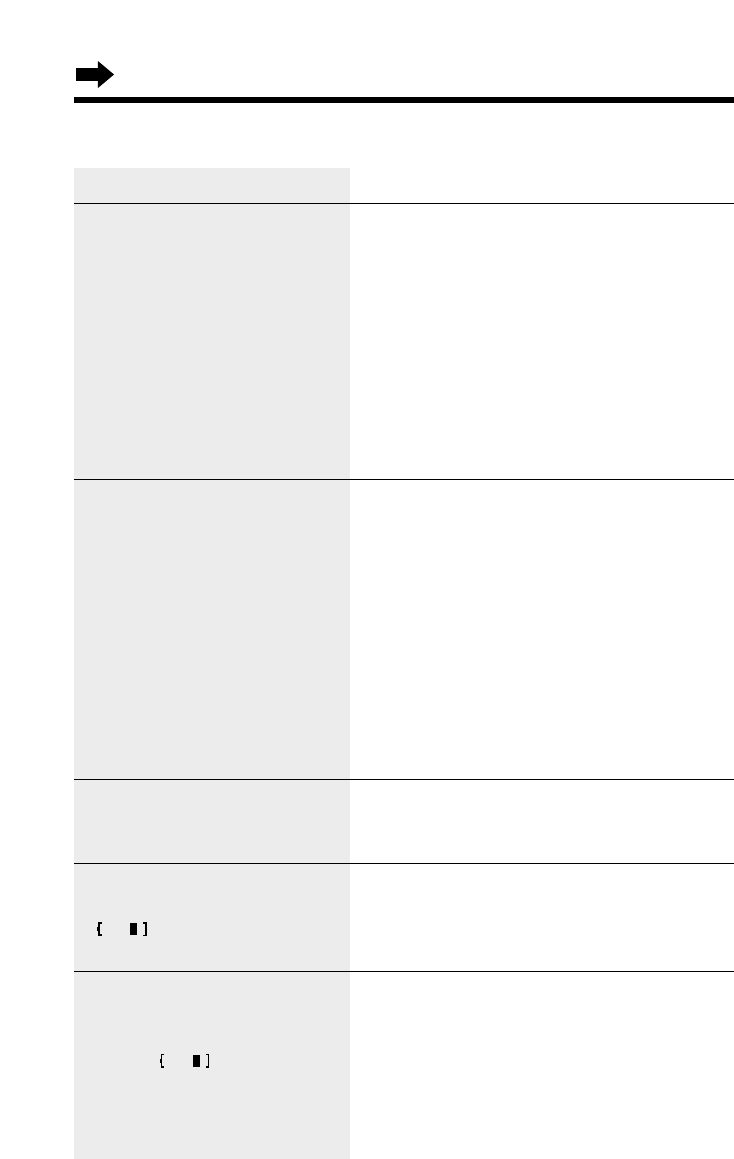
78
Before Requesting Help
General
Problem
The unit does not work.
You cannot program items,
such as the dialing mode.
Previously programmed
information is erased.
“Recharge battery” is
displayed on the handset,
“” flashes or the unit
beeps intermittently.
You charged the battery
fully, but “Recharge
battery” is still displayed
and/or “” continues to
flash.
Remedy
•Check the settings (p. 10–14).
•Charge the battery fully (p. 11).
•Clean the charge contacts and charge
again (p. 12).
•Install the battery properly (p. 71).
•Place the handset on the base unit and
unplug the AC adaptor to reset. Plug in,
and try again.
•Re-install the battery and place the
handset on the base unit (p. 71). Try
again.
•Programming is not possible while the
unit is in the talk or speakerphone mode,
when viewing the Caller List/directory
list, or while the answering system is in
use.
•Do not pause for over 60 seconds while
programming.
•Move closer to the base unit.
•Ö, Ñ, BACK Üor FWD/EDIT ámay
have been pressed when you picked up
the handset. Press (FUNCTION/EXIT/CH)
and try again.
•If a power failure occurs, programmed
information may be erased. Reprogram
if necessary.
•Charge the battery fully (p. 11).
•Clean the charge contacts and charge
again (p. 12).
•Install a new battery (p. 71).
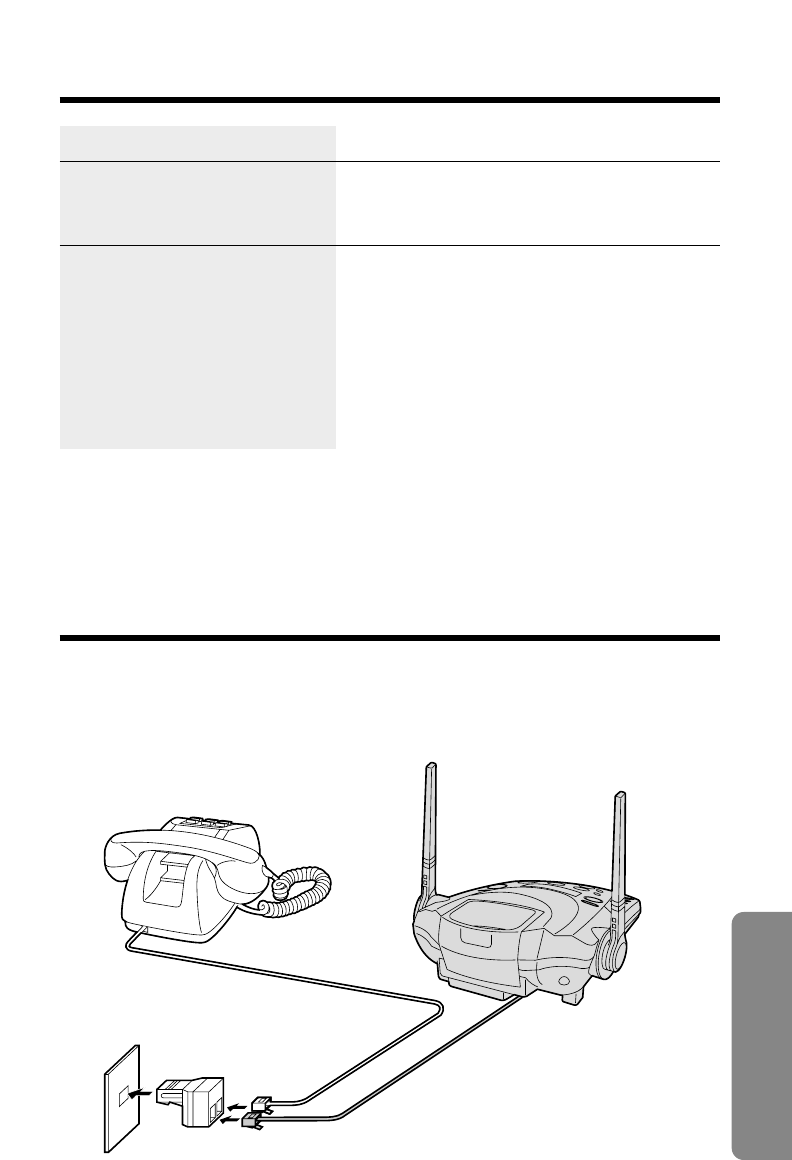
79
Useful Information
Problem
The IN USE/CHARGE
indicator light does not go
out while charging.
If you cannot solve your
problem.
Remedy
•This is normal.
•Call our customer call center at
1-800-211-PANA(7262).
•Panasonic’s e-mail address for customer
inquiries:
consumerproducts@panasonic.com
for customers in the USA or Puerto Rico
ONLY
Adding Another Phone
This unit will not function during a power failure. To connect a standard
telephone on the same line, use the Panasonic T-adaptor KX-J66.
To order, call the accessories telephone number on page 2.
T-Adaptor (KX-J66)
Single-Line
Telephone Jack
Telephone
Line Cord
Standard Telephone

80
Important Safety Instructions
When using this unit, basic safety precautions should always be followed
to reduce the risk of fire, electric shock, or personal injury.
11. Read and understand all instructions.
12. Follow all warnings and instructions marked on this unit.
13. Unplug this unit from AC outlets before cleaning. Do not use liquid or
aerosol cleaners. Use a damp cloth for cleaning.
14. Do not use this unit near water, for example, near a bathtub,
washbowl, kitchen sink, or the like.
15. Place this unit securely on a stable surface. Serious damage and/or
injury may result if the unit falls.
16. Do not cover slots and openings on the unit. They are provided for
ventilation and protection against overheating. Never place the unit
near radiators, or in a place where proper ventilation is not provided.
17. Use only the power source marked on the unit. If you are not sure of
the type of power supplied to your home, consult your dealer or local
power company.
18. Do not place objects on the power cord. Install the unit where no one
can step or trip on the cord.
19. Do not overload wall outlets and extension cords. This can result in
the risk of fire or electric shock.
10. Never push any objects through slots in this unit. This may result in
the risk of fire or electric shock. Never spill any liquid on the unit.
11. To reduce the risk of electric shock, do not disassemble this unit.
Take the unit to an authorized servicenter when service is required.
Opening or removing covers may expose you to dangerous voltages
or other risks. Incorrect reassembly can cause electric shock when
the unit is subsequently used.
12. Unplug this unit from the wall outlet and refer servicing to an
authorized servicenter when the following conditions occur:
A. When the power supply cord or plug is damaged or frayed.
B. If liquid has been spilled into the unit.
C. If the unit has been exposed to rain or water.
D. If the unit does not work normally by following the operating
instructions. Adjust only controls covered by the operating
instructions. Improper adjustment may require extensive work by
an authorized servicenter.
E. If the unit has been dropped or physically damaged.
F. If the unit exhibits a distinct change in performance.
13. During thunderstorms, avoid using telephones except cordless types.
There may be a remote risk of an electric shock from lightning.
14. Do not use this unit to report a gas leak, when in the vicinity of the
leak.
SAVE THESE INSTRUCTIONS

81
Useful Information
CAUTION:
To reduce the risk of fire or injury to persons, read and follow these
instructions.
1. Use only the battery(ies) specified.
2. Do not dispose of the battery(ies) in a fire. They may explode. Check
with local waste management codes for special disposal instructions.
3. Do not open or mutilate the battery(ies). Released electrolyte is
corrosive and may cause burns or injury to the eyes or skin. The
electrolyte may be toxic if swallowed.
4. Exercise care in handling batteries in order not to short the battery to
conductive materials such as rings, bracelets, and keys. The battery
and/or conductor may overheat and cause burns.
5. Charge the battery(ies) provided with or identified for use with this
product only in accordance with the instructions and limitations
specified in this manual.
WARNING:
TO PREVENT FIRE OR SHOCK HAZARD, DO NOT EXPOSE THE
BASE UNIT TO RAIN OR ANY TYPE OF MOISTURE. ONLY THE
HANDSET IS SHOCK AND SPLASH RESISTANT.
•
When left unused for a long period of time, the base unit should be
unplugged from the household AC outlet.
Splash-Resistant (HANDSET ONLY)
The handset is designed to be splash resistant.
You can use the handset with wet hands.
CAUTION:
•Do not immerse in water or leave under running water.
•Keep the handset away from salt water.
•Avoid exposure to prolonged high humidity.
•Since water in headset jack may cause damage, close the headset jack
cover when the optional headset is not in use. When the optional
headset is connected, do not use the handset with wet hands.
•If the handset is wet, wipe with a soft dry cloth.
•The base unit is not designed to be splash resistant. Do not place the
wet handset on the base unit.
Shock-Resistant (HANDSET ONLY)
Although the handset is designed to be shock resistant, do not throw or
step on the handset.

82
FCC and Other Information
If requested by the telephone company, inform them as follows:
FCC Registration No. . . . . . . . . . . . . . . . . . . . . . (found on the bottom of the unit)
Ringer Equivalence . . . . . . . . . . . . . . . . . . . . . . . . . . . . . . . . . . . . . . . . . . . . 0.1B
The particular telephone line to which the equipment is connected.
This unit must not be connected to a coin operated line.
If you are on a party line, check with your local telephone company.
Ringer Equivalence No. (REN):
The REN is useful in determining the quantity of devices you may connect to your
telephone line and still have all of those devices ring when your telephone number
is called. In most, but not all areas, the sum of the REN’s of all devices connected
to one line should not exceed five (5.0). To be certain of the number of devices
you may connect to your line, as determined by the REN, you should contact your
local telephone company to determine the maximum REN for your calling area.
In the event terminal equipment causes harm to the telephone network, the telephone
company should notify the customer, if possible, that service may be stopped.
However, where prior notice is impractical, the company may temporarily cease
service providing that they:
(a) Promptly notify the customer.
(b) Give the customer an opportunity to correct the problem with their equipment.
(c) Inform the customer of the right to bring a complaint to the Federal
Communication Commission pursuant to procedures set out in FCC Rules and
Regulations Subpart E of Part 68.
The Telephone Company may make changes in its communications facilities,
equipment, operations or procedures, where such action is reasonably required in
the operation of its business and is not inconsistent with the rules and regulations
in FCC Part 68.
If such changes can be reasonably expected to render any customer terminal
equipment incompatible with telephone company communications facilities, or
require modification or alteration of such terminal equipment, or otherwise materially
affect its use or performance, the customer shall be given adequate notice in
writing, to allow the customer an opportunity to maintain uninterrupted service.
When programming emergency numbers and/or making test calls to emergency
numbers:
1. Remain on the line and briefly explain to the dispatcher the reason for the call
before hanging up.
2. Perform such activities in the off-peak hours, such as early morning hours or
late evenings.
This device complies with Part 15 of the FCC Rules. Operation is subject to the
following two conditions: (1) This device may not cause harmful interference, and
(2) this device must accept any interference received, including interference that
may cause undesired operation.
Privacy of communications may not be ensured when using this phone.

83
Useful Information
CAUTION:
Any changes or modifications not expressly approved by the party responsible for
compliance could void the user’s authority to operate this device.
Note:
This equipment has been tested and found to comply with the limits for a Class B
digital device, pursuant to Part 15 of the FCC Rules. These limits are designed to
provide reasonable protection against harmful interference in a residential
installation. This equipment generates, uses, and can radiate radio frequency
energy and, if not installed and used in accordance with the instructions, may
cause harmful interference to radio communications. However, there is no
guarantee that interference will not occur in a particular installation. If this
equipment does cause harmful interference to radio or television reception, which
can be determined by turning the equipment off and on, the user is encouraged to
try to correct the interference by one or more of the following measures:
—Reorient or relocate the receiving antenna.
—Increase the separation between the equipment and receiver.
—Connect the equipment into an outlet on a circuit different from that to which the
receiver is connected.
—Consult the dealer or an experienced radio/TV technician for help.
Some cordless telephones operate at frequencies that may cause interference to
nearby TVs and VCRs. To minimize or prevent such interference, the base of the
cordless telephone should not be placed near or on top of a TV or VCR. If
interference is experienced, move the cordless telephone further away from the
TV or VCR. This will often reduce, or eliminate, interference.
Operating near 2.4GHz electrical appliances may cause interference. Move away
from the electrical appliances and/or press the CH (Channel) button.
•Environment — do not place the unit in a room where the temperature is less
than 5°C (41°F) or greater than 40°C (104°F). Allow 10 cm (4") clearance
around the unit for proper ventilation. Avoid excessive smoke, dust, mechanical
vibration, shock, or direct sunlight.
•Medical —consult the manufacturer of any personal medical devices, such as
pacemakers, to determine if they are adequately shielded from external RF
(radio frequency) energy. (The unit operates in the frequency range of
2401MHz to 2472MHz, and the power output level can range from 0.001 watts
to 0.20 watts.) Do not use the unit in health care facilities if any regulations
posted in the area instruct you not to do so. Hospitals or health care facilities
may be using equipment that could be sensitive to external RF (radio
frequency) energy.
•Routine care — wipe the unit with a soft cloth. Do not use benzine, thinner, or
any abrasive powder. When you leave the unit unused for a long period of time,
unplug the AC adaptor from the outlet.
•If there is any trouble — disconnect the unit from the telephone line and
connect a known working phone. If the known working phone operates properly,
have your unit repaired by one of the authorized Panasonic Factory Service
Centers. If the known working phone does not operate properly, consult your
telephone company.
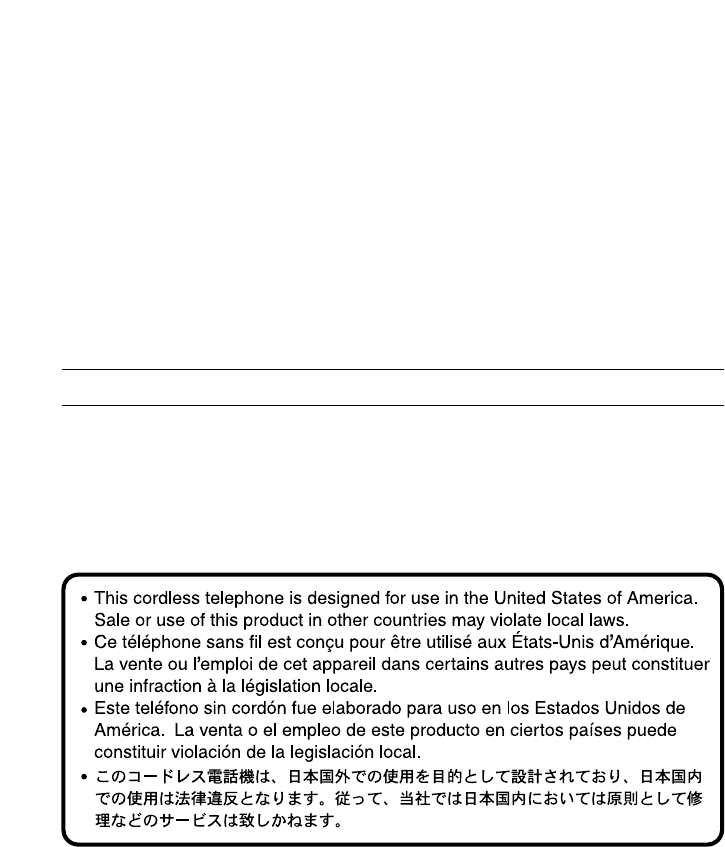
For product service
•Panasonic Servicenters are listed in the servicenter directory.
•Call 1-800-211-PANA(7262) for the location of an authorized servicenter.
•Panasonic’s e-mail address for customer inquiries:
consumerproducts@panasonic.com
for customers in the USA or Puerto Rico ONLY
When you ship the product
•Carefully pack your unit, preferably in the original carton.
•Attach a letter, detailing the symptom, to the outside of the carton.
Symptom
•Send the unit to an authorized servicenter, prepaid and adequately
insured.
•Do not send your unit to the Panasonic Consumer Electronics Company
listed below or to executive or regional sales offices. These locations do
not repair consumer products.
Panasonic Consumer Electronics Company,
Division of Matsushita Electric Corporation of America
One Panasonic Way, Secaucus, New Jersey 07094
Panasonic Sales Company,
Division of Matsushita Electric of Puerto Rico, Inc.
Ave. 65 de Infantería, Km. 9.5, San Gabriel Industrial Park
Carolina, Puerto Rico 00985